Paul van Yperen's Blog, page 83
June 22, 2023
Imported from the USA: Mary Nolan a.k.a. Imogene Robertson
Mary Nolan (1902–1948) was a Hollywood star who started her film career in the European cinema. She was a beautiful but ba-a-ad girl, who loved to party. The sexy blonde appeared on stage, on screen, and most of all in the tabloids. After a 'sex scandal', she fled to Germany where she starred in 17 silent films under the stage name Imogene Robertson. Her life ended tragically.
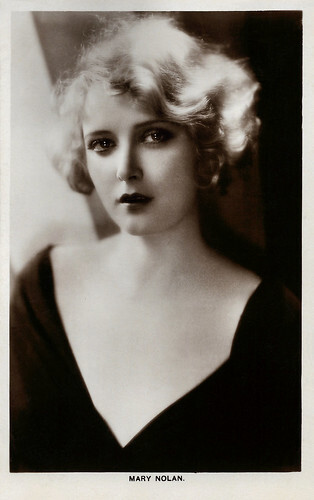
British postcard in the Picturegoer Series, London, no. 370.
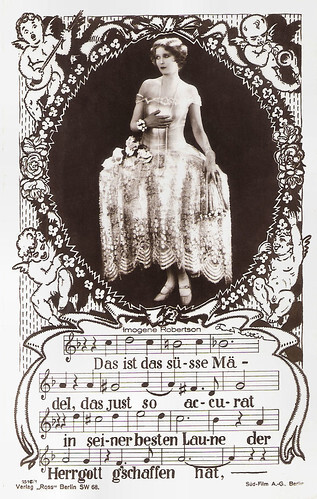
German postcard by Ross Verlag, no. 1516/1, 1927-1928. Photo: Süd-Film A.G., Berlin. Imogene Robertson a.k.a. Mary Nolan in Das süße Mädel/The Sweet Girl (Manfred Noa, 1926).
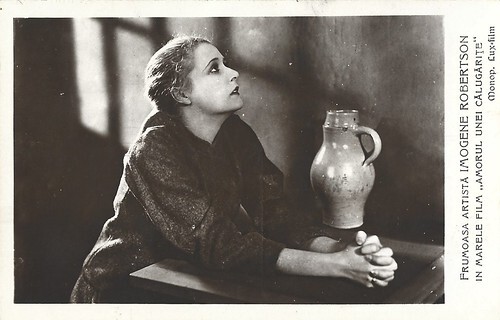
Romanian postcard. Photo: Monopole / Lux-Film / Münchner Lichtspielkunst. Imogene Robertson (Mary Nolan) in Erinnerungen einer Nonne/Memoirs of a Nun (Arthur Bergen, 1927). Caption: The beautiful Imogene Robertson in the big film The Love of a Nun.
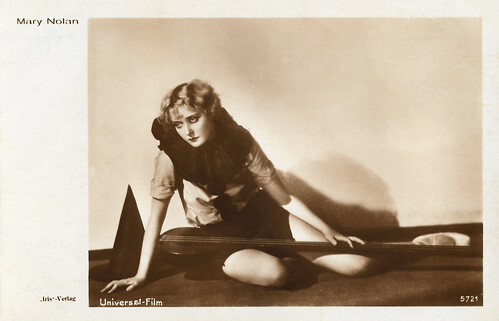
Austrian postcard by Iris-Verlag, no. 5721. Photo: Universal-Film, Berlin.
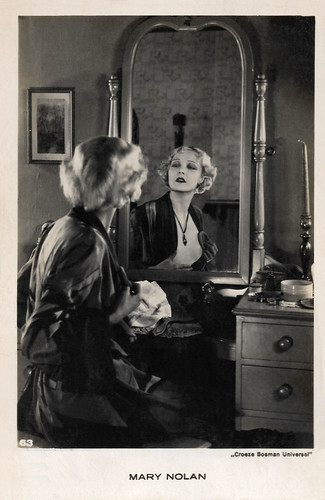
Dutch postcard by Croese Bosman Universal, no. 63. Sent by mail in 1933.
Jazz-Age baby and party girl by nature
Mary Nolan was born Mary Imogene Robertson in Louisville, Kentucky, U.S. in 1902 (according to Wikipedia and 1905 according to IMDb ). She was one of five children born to Africanus and Viola Robertson. Her mother died of cancer at the age of 46. Unable to care for five young children, Africanus Robertson placed Mary in a foster home. She eventually went to live in a Catholic orphanage in Missouri where she earned the nickname 'Bubbles'.
The beautiful blonde arrived broke in New York in 1919. Eve Golden at Films of the Golden Age : "She really was breathtaking with her perfect bone structure, a cloud of thick blonde hair, and china-blue eyes. It wasn't long before Mary got work as an artist's model for such big shots as James Montgomery Flagg and Arthur William Brown." Famous Broadway producer Oliver Morosco launched her stage career in the choruses of Daffy Dill and Lady Butterfly (1923). Bubbles proved to be a Jazz-Age baby and a party girl by nature. Florenz Ziegfeld Jr. signed her up for his Follies shows on Broadway. As a showgirl, she performed under the stage name Imogene 'Bubbles' Wilson.
For the next several years, she started a violent love/hate relationship with Ziegfeld comedian Frank Tinney. Tinney was married to the comedy star Edna Davenport. Tinney set Mary up in a West 72nd Street apartment and showered her with expensive gifts, but he also showered her with bruises, both physical and emotional. The abusive affair stirred up a major sex scandal in 1924. The tabloids exposed the tumultuous relationship when Mary was seriously hospitalized after one of their many arguments.
Mary was fired by Ziegfeld and set sail for France where she was scheduled to appear in vaudeville. She made her way to London in October where she reunited with Frank Tinney. By December 1924, Tinney had resumed drinking and began to physically abuse her again. In early 1925, Nolan finally ended the relationship. She then travelled to Germany where she began to work in the film industry under the new stage name Imogene Robertson. Her first German film was Verborgene Gluten/Hidden Fires (Einar Bruun, 1925) with Alphons Fryland . Later that year, she appeared in the title role of Die Feuertänzerin (Robert Dinesen, 1925) for the Ufa. She received good reviews for her work in the film which prompted the Ufa to offer her a contract for $1500 a week.
Nolan worked steadily in Germany from 1925 to 1927 and continued to receive favourable reviews for her acting. Her best-known films include the mystery Das Parfüm der Mrs. Worrington/The Parfum of Mrs. Worrington (Franz Seitz, 1925) with Ernst Reicher as detective Stuart Webbs, Das süße Mädel/The sweet girl (Manfred Noa, 1926) with Nils Asther , and the drama Die Abenteuer eines Zehnmarkscheines/The adventures of a 10-mark note (Berthold Viertel, 1926).
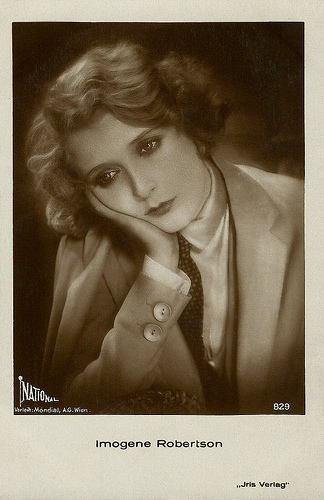
Austrian postcard by Iris Verlag, no. 829. Photo: National / Mondial A.G., Wien. Collection: Didier Hanson.
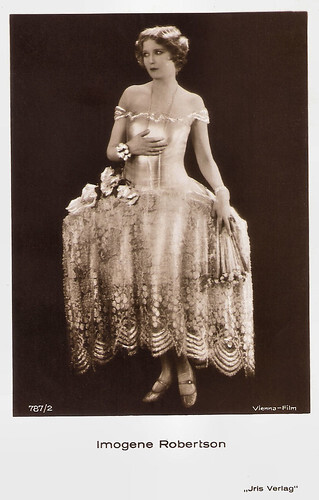
Austrian postcard by Iris Verlag, no. 878/2. Photo: Vienna-Film.
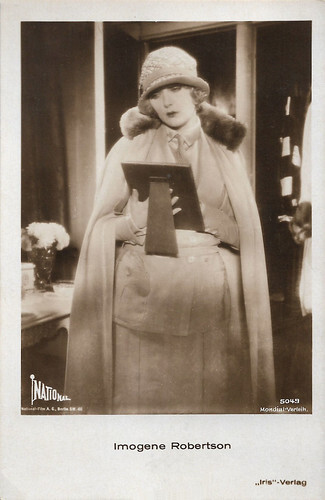
Austrian postcard by Iris-Verlag, no. 5049. Photo: Mondial-Verleih / National-Film, Berlin. Probably a still for Die Königin des Weltbades/The Queen of the Baths (Victor Janson, 1926) which was released by National-Film in Germany.
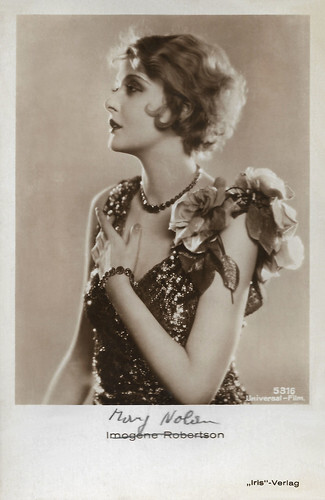
Austrian postcard by Iris Verlag, no. 5316. Photo: Universal-Film.
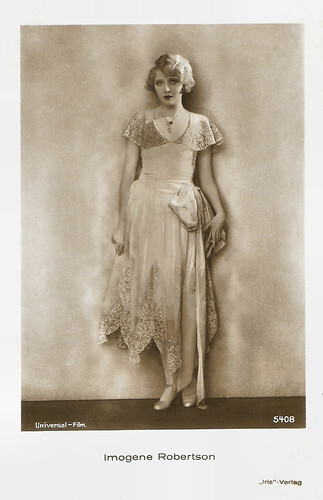
Austrian postcard by Iris-Verlag, no. 5408. Photo: Universal-Film.
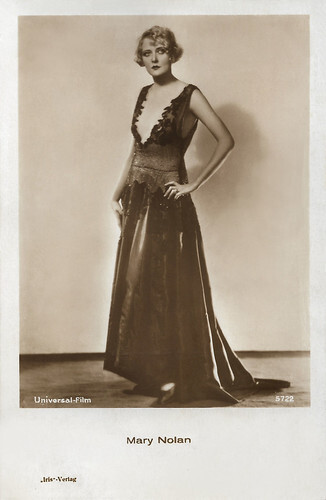
Austrian postcard by Iris-Verlag, no. 5722. Photo: Universal-Film.
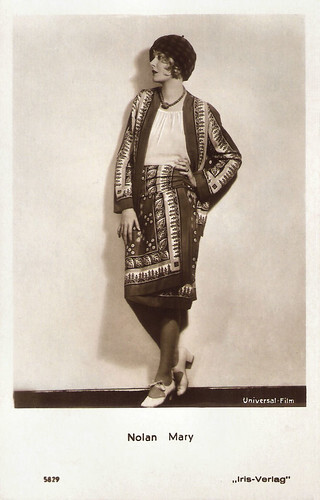
Austrian postcard by Iris Verlag, no. 5829. Photo: Universal-Film.
Carnival sideshow dancer
While in Germany, Imogene Robertson received offers from Hollywood producers to appear in American films but turned them down. She finally relented after Joseph M. Schenck offered her a contract with United Artists. She returned to the United States in January 1927. To solve the problem of audiences connecting her with her scandalous past, United Artists suggested she change her name to Mary Nolan. For United Artists, she appeared in an uncredited bit part in Topsy and Eva (Del Lord, 1927), and a supporting role in Sorrell and Son (Herbert Brenon, 1927). In 1928, Nolan was signed to Universal Pictures. Her first film for the company was Good Morning, Judge (William A. Seiter, 1928), starring Reginald Denny for which she received good reviews. Universal loaned her out to Metro-Goldwyn-Mayer for West of Zanzibar (Tod Browning, 1928), about the vengefulness of a cuckolded magician ( Lon Chaney ) paralysed in a brawl with his rival ( Lionel Barrymore ). Nolan played Chaney's defiled daughter Maizie. The film was a hit and Nolan received favourable reviews for her work in the film.
The following year, she was loaned to MGM again for the romantic drama Desert Nights (William Nigh, 1929), with John Gilbert . Two thieves (Noland and Ernest Torrence ) victimise a diamond mine and kidnap its manager (Gilbert), but he gains the upper hand (and falls in love with Nolan) when they flee into the hostile desert. Desert Nights was another financial success and served to boost Nolan's career. Shortly after signing with Universal in 1927, Nolan had begun a relationship with another married man, studio executive Eddie Mannix. Mannix used his clout to further Nolan's career and was responsible for her loan outs to MGM. Shortly after Desert Nights was released in 1929, Mannix abruptly ended the relationship. This angered Nolan who threatened to tell Mannix's wife Bernice of their affair. Mannix became enraged and beat her unconscious.
Nolan was hospitalised for six months and required fifteen surgeries to repair damage Mannix inflicted on her abdomen. While hospitalised, Nolan was prescribed morphine for pain. She eventually became addicted which contributed to the decline of her career. In the Universal production Young Desire (Lew Collins, 1930), Nolan plays Helen Herbert aka 'La Belle Helene', a carnival sideshow dancer. She falls in love with wealthy, wet-behind-the-ears Bobby Spencer who whisks her off to his hometown of Spencerville and stakes her to an apartment and a job. But Helen's sordid past catches up with her...
By then, Nolan's acting career had begun to decline due to her drug abuse and reputation for being temperamental. She was fired from the film What Men Want (1930). Nolan got into an argument with the film's director, Ernst Laemmle, after she learned she was the only cast member who hadn't received a close-up shot. Laemmle banned Nolan from the set and she was subsequently fired. After threatening to file a lawsuit against Universal, the studio bought her out of her contract in January 1931. She married stock broker Wallace T. McCreary on 29 March 1931. One week before they married, McCreary lost $3 million on bad investments. The couple used McCreary's remaining money to open a dress shop in Beverly Hills. The shop went out of business within months and Nolan filed for bankruptcy in August 1931. Nolan divorced McCreary in July 1932.
After her exit from Universal, she was unable to secure film work with any of the major studios. Nolan spent the remainder of her acting career appearing in roles in low-budget films for independent studios. She made her final film appearances in File 113 (Chester M. Franklin, 1933), for Allied Pictures Corporation. From then on, Nolan appeared in vaudeville and performed in nightclubs and roadhouses around the United States. Later, Mary Nolan suffered several nervous breakdowns and her health declined. She turned to heroin, and it spelt the end. In 1948, she died of cardiac arrest and liver problems (according to IMDb , but Wikipedia writes she died of a barbiturate overdose). Gary Brumburgh at IMDb : "Mary became just one more Hollywood tragedy - an incredible beauty whose life turned absolutely beastly."
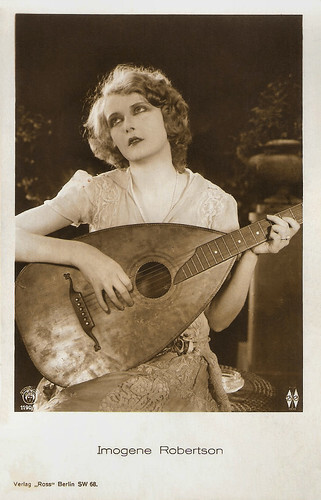
German postcard by Ross Verlag, no. 1190/1, 1927-1928. Photo: Emelka Films / Süd-Film. Bayern Films. Imogene Robertson in Erinnerungen einer Nonne/Memories of a Nun (Arthur Bergen, 1927).
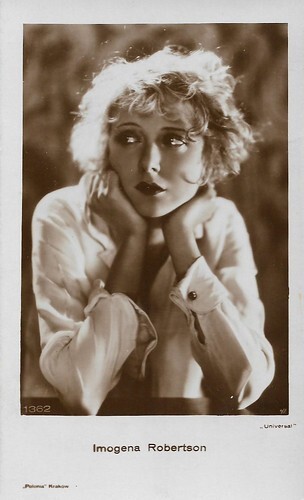
Polish postcard by Polonia, Krakow, no. 1362. Photo: Universal.
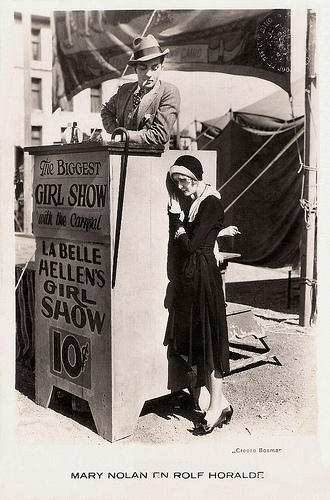
Dutch postcard by Croese Bosman. Sent by mail in 1932. Photo: publicity still for Young Desire (Lew Collins, 1930).
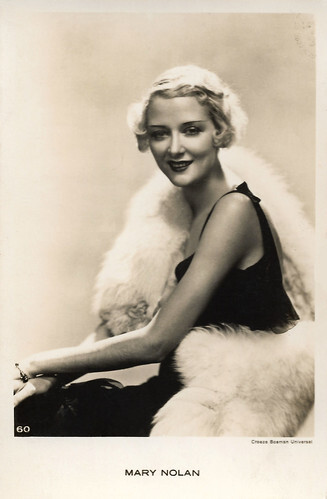
Dutch postcard, no. 60. Photo: Croeze Bosman Universal.
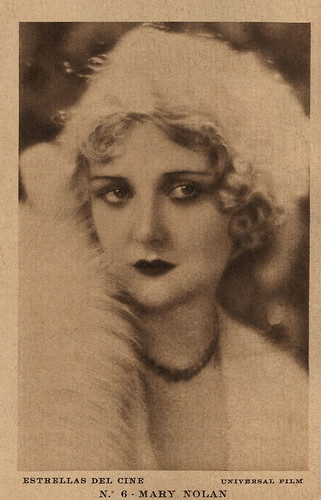
Spanish postcard in the Estrellas del Cine Series by Editorial Gráfica, Barcelona, no. 6. Photo: Universal Film.
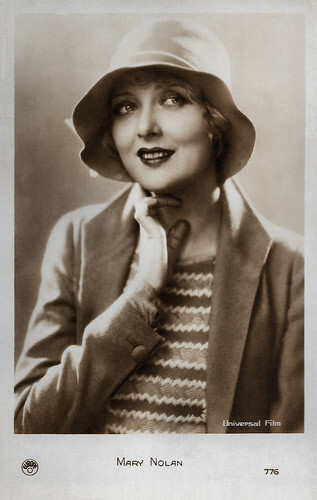
French postcard by Europe, no. 776. Photo: Universal Film.
Source: (IMDb), Eve Golden (Films of the Golden Age), Thomas Staedeli (Cyranos), Wikipedia and .

British postcard in the Picturegoer Series, London, no. 370.

German postcard by Ross Verlag, no. 1516/1, 1927-1928. Photo: Süd-Film A.G., Berlin. Imogene Robertson a.k.a. Mary Nolan in Das süße Mädel/The Sweet Girl (Manfred Noa, 1926).

Romanian postcard. Photo: Monopole / Lux-Film / Münchner Lichtspielkunst. Imogene Robertson (Mary Nolan) in Erinnerungen einer Nonne/Memoirs of a Nun (Arthur Bergen, 1927). Caption: The beautiful Imogene Robertson in the big film The Love of a Nun.

Austrian postcard by Iris-Verlag, no. 5721. Photo: Universal-Film, Berlin.

Dutch postcard by Croese Bosman Universal, no. 63. Sent by mail in 1933.
Jazz-Age baby and party girl by nature
Mary Nolan was born Mary Imogene Robertson in Louisville, Kentucky, U.S. in 1902 (according to Wikipedia and 1905 according to IMDb ). She was one of five children born to Africanus and Viola Robertson. Her mother died of cancer at the age of 46. Unable to care for five young children, Africanus Robertson placed Mary in a foster home. She eventually went to live in a Catholic orphanage in Missouri where she earned the nickname 'Bubbles'.
The beautiful blonde arrived broke in New York in 1919. Eve Golden at Films of the Golden Age : "She really was breathtaking with her perfect bone structure, a cloud of thick blonde hair, and china-blue eyes. It wasn't long before Mary got work as an artist's model for such big shots as James Montgomery Flagg and Arthur William Brown." Famous Broadway producer Oliver Morosco launched her stage career in the choruses of Daffy Dill and Lady Butterfly (1923). Bubbles proved to be a Jazz-Age baby and a party girl by nature. Florenz Ziegfeld Jr. signed her up for his Follies shows on Broadway. As a showgirl, she performed under the stage name Imogene 'Bubbles' Wilson.
For the next several years, she started a violent love/hate relationship with Ziegfeld comedian Frank Tinney. Tinney was married to the comedy star Edna Davenport. Tinney set Mary up in a West 72nd Street apartment and showered her with expensive gifts, but he also showered her with bruises, both physical and emotional. The abusive affair stirred up a major sex scandal in 1924. The tabloids exposed the tumultuous relationship when Mary was seriously hospitalized after one of their many arguments.
Mary was fired by Ziegfeld and set sail for France where she was scheduled to appear in vaudeville. She made her way to London in October where she reunited with Frank Tinney. By December 1924, Tinney had resumed drinking and began to physically abuse her again. In early 1925, Nolan finally ended the relationship. She then travelled to Germany where she began to work in the film industry under the new stage name Imogene Robertson. Her first German film was Verborgene Gluten/Hidden Fires (Einar Bruun, 1925) with Alphons Fryland . Later that year, she appeared in the title role of Die Feuertänzerin (Robert Dinesen, 1925) for the Ufa. She received good reviews for her work in the film which prompted the Ufa to offer her a contract for $1500 a week.
Nolan worked steadily in Germany from 1925 to 1927 and continued to receive favourable reviews for her acting. Her best-known films include the mystery Das Parfüm der Mrs. Worrington/The Parfum of Mrs. Worrington (Franz Seitz, 1925) with Ernst Reicher as detective Stuart Webbs, Das süße Mädel/The sweet girl (Manfred Noa, 1926) with Nils Asther , and the drama Die Abenteuer eines Zehnmarkscheines/The adventures of a 10-mark note (Berthold Viertel, 1926).

Austrian postcard by Iris Verlag, no. 829. Photo: National / Mondial A.G., Wien. Collection: Didier Hanson.

Austrian postcard by Iris Verlag, no. 878/2. Photo: Vienna-Film.

Austrian postcard by Iris-Verlag, no. 5049. Photo: Mondial-Verleih / National-Film, Berlin. Probably a still for Die Königin des Weltbades/The Queen of the Baths (Victor Janson, 1926) which was released by National-Film in Germany.

Austrian postcard by Iris Verlag, no. 5316. Photo: Universal-Film.

Austrian postcard by Iris-Verlag, no. 5408. Photo: Universal-Film.

Austrian postcard by Iris-Verlag, no. 5722. Photo: Universal-Film.

Austrian postcard by Iris Verlag, no. 5829. Photo: Universal-Film.
Carnival sideshow dancer
While in Germany, Imogene Robertson received offers from Hollywood producers to appear in American films but turned them down. She finally relented after Joseph M. Schenck offered her a contract with United Artists. She returned to the United States in January 1927. To solve the problem of audiences connecting her with her scandalous past, United Artists suggested she change her name to Mary Nolan. For United Artists, she appeared in an uncredited bit part in Topsy and Eva (Del Lord, 1927), and a supporting role in Sorrell and Son (Herbert Brenon, 1927). In 1928, Nolan was signed to Universal Pictures. Her first film for the company was Good Morning, Judge (William A. Seiter, 1928), starring Reginald Denny for which she received good reviews. Universal loaned her out to Metro-Goldwyn-Mayer for West of Zanzibar (Tod Browning, 1928), about the vengefulness of a cuckolded magician ( Lon Chaney ) paralysed in a brawl with his rival ( Lionel Barrymore ). Nolan played Chaney's defiled daughter Maizie. The film was a hit and Nolan received favourable reviews for her work in the film.
The following year, she was loaned to MGM again for the romantic drama Desert Nights (William Nigh, 1929), with John Gilbert . Two thieves (Noland and Ernest Torrence ) victimise a diamond mine and kidnap its manager (Gilbert), but he gains the upper hand (and falls in love with Nolan) when they flee into the hostile desert. Desert Nights was another financial success and served to boost Nolan's career. Shortly after signing with Universal in 1927, Nolan had begun a relationship with another married man, studio executive Eddie Mannix. Mannix used his clout to further Nolan's career and was responsible for her loan outs to MGM. Shortly after Desert Nights was released in 1929, Mannix abruptly ended the relationship. This angered Nolan who threatened to tell Mannix's wife Bernice of their affair. Mannix became enraged and beat her unconscious.
Nolan was hospitalised for six months and required fifteen surgeries to repair damage Mannix inflicted on her abdomen. While hospitalised, Nolan was prescribed morphine for pain. She eventually became addicted which contributed to the decline of her career. In the Universal production Young Desire (Lew Collins, 1930), Nolan plays Helen Herbert aka 'La Belle Helene', a carnival sideshow dancer. She falls in love with wealthy, wet-behind-the-ears Bobby Spencer who whisks her off to his hometown of Spencerville and stakes her to an apartment and a job. But Helen's sordid past catches up with her...
By then, Nolan's acting career had begun to decline due to her drug abuse and reputation for being temperamental. She was fired from the film What Men Want (1930). Nolan got into an argument with the film's director, Ernst Laemmle, after she learned she was the only cast member who hadn't received a close-up shot. Laemmle banned Nolan from the set and she was subsequently fired. After threatening to file a lawsuit against Universal, the studio bought her out of her contract in January 1931. She married stock broker Wallace T. McCreary on 29 March 1931. One week before they married, McCreary lost $3 million on bad investments. The couple used McCreary's remaining money to open a dress shop in Beverly Hills. The shop went out of business within months and Nolan filed for bankruptcy in August 1931. Nolan divorced McCreary in July 1932.
After her exit from Universal, she was unable to secure film work with any of the major studios. Nolan spent the remainder of her acting career appearing in roles in low-budget films for independent studios. She made her final film appearances in File 113 (Chester M. Franklin, 1933), for Allied Pictures Corporation. From then on, Nolan appeared in vaudeville and performed in nightclubs and roadhouses around the United States. Later, Mary Nolan suffered several nervous breakdowns and her health declined. She turned to heroin, and it spelt the end. In 1948, she died of cardiac arrest and liver problems (according to IMDb , but Wikipedia writes she died of a barbiturate overdose). Gary Brumburgh at IMDb : "Mary became just one more Hollywood tragedy - an incredible beauty whose life turned absolutely beastly."

German postcard by Ross Verlag, no. 1190/1, 1927-1928. Photo: Emelka Films / Süd-Film. Bayern Films. Imogene Robertson in Erinnerungen einer Nonne/Memories of a Nun (Arthur Bergen, 1927).

Polish postcard by Polonia, Krakow, no. 1362. Photo: Universal.

Dutch postcard by Croese Bosman. Sent by mail in 1932. Photo: publicity still for Young Desire (Lew Collins, 1930).

Dutch postcard, no. 60. Photo: Croeze Bosman Universal.

Spanish postcard in the Estrellas del Cine Series by Editorial Gráfica, Barcelona, no. 6. Photo: Universal Film.

French postcard by Europe, no. 776. Photo: Universal Film.
Source: (IMDb), Eve Golden (Films of the Golden Age), Thomas Staedeli (Cyranos), Wikipedia and .
Published on June 22, 2023 22:00
June 21, 2023
Verdun, visions d'histoire (1928)
The French silent film Verdun, visions d'histoire/Verdun, Visions of History (Léon Poirier, 1928) is a dramatised account of the battle of Verdun (1916), a key World War I battle. French troops, fighting alone and often in desperate hand-to-hand combat, had to halt the German advance at all costs. The docudrama uses newsreel footage, director Léon Poirier's own highly realistic reconstructions of the conflict and some little dramatic scenes which add a thread of personal interest to the events.
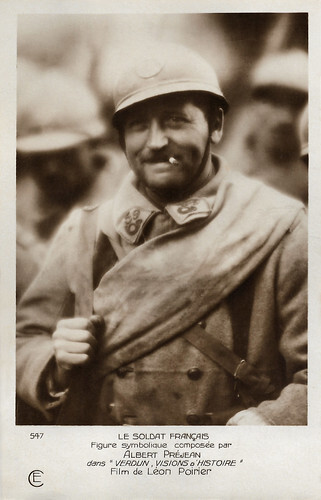
French postcard by Editions Cinémagazine, no. 547. Photo: Albert Préjean as the symbolic figure of Le Soldat Français (The French soldier) in Verdun, visions d'histoire/Verdun, Visions of History (Léon Poirier, 1928).
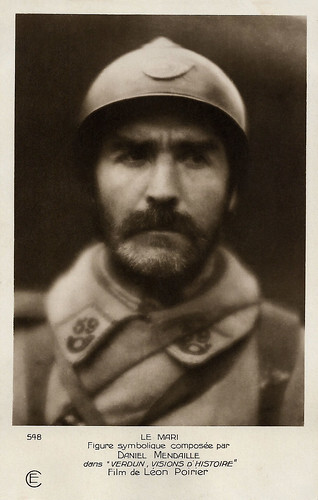
French postcard by Cinémagazine-Edition, no. 548. Photo: Daniel Mendaille as Le Mari (The Husband) in Verdun, visions d'histoire/Verdun, Visions of History (Leon Poirier, 1928).
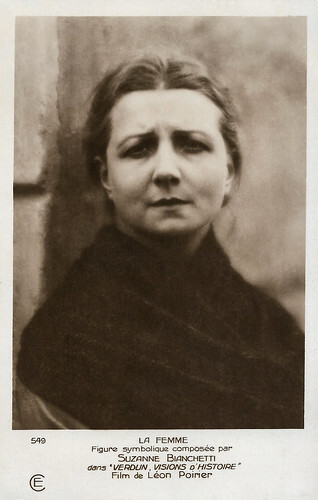
French postcard by Cinémagazine-Edition, no. 549. Photo: Suzanne Bianchetti as La Femme (The Wife) in Verdun, visions d'histoire/Verdun, Visions of History (Léon Poirier, 1928).
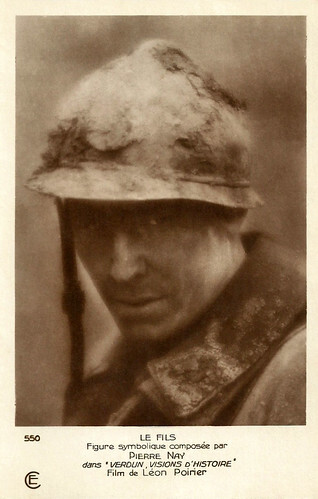
French postcard by Editions Cinémagazine, no. 550. Photo: Pierre Nay as Le Fils (The Son) in Verdun, visions d'histoire/Verdun, Visions of History (Léon Poirier, 1928).
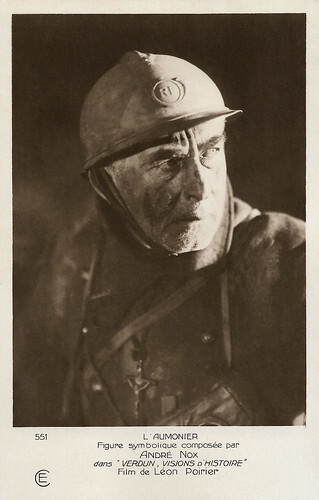
French postcard by Editions Cinémagazine, no. 551. Photo: André Nox as L'Aumonier (The Chaplain) in Verdun, visions d'histoire/Verdun, Visions of History (Léon Poirier, 1928).
Crawling across no-man's-land
Director Léon Poirier tells Verdun, visions d'histoire/Verdun, historical visions from both sides. The film is surprisingly sympathetic to the German point of view, considering when it was made.
Poirier's pacifist stance is revealed in several moments, notably in one scene when two angels descend onto the battlefield and extract the souls of two soldiers, one German and one French, and place them together on a stretcher which they carry up to heaven.
The fort that is posing for Fort Vaux during the attack on it in the film is actually Fort Tavannes. It is not far from Fort Vaux and has been attacked during the real battle in 1916.
The film features newly filmed material but also features much archive footage of Emperor Wilhelm II and German marches. The special effects are well done, with a huge variety of explosions, ghostly images, scenery and graphic maps to illustrate the battle.
The re-enacted battle sequences, place the viewer in the midst of the horror, crawling across no-man's-land, cowering in fox-holes, or being blown apart in trenches. The countryside is shown as a moonscape of craters and splintered trees.

French postcard by Editions Cinémagazine, no. 552. Photo: Jean Dehelly as Le Jeune Homme (The Young Man) and an anonymous local woman as La Jeune Fille (The Young Woman) in Verdun, visions d'histoire/Verdun, Visions of History (Léon Poirier, 1928).

French postcard by Editions Cinémagazine, no. 554. Photo: José Davert as Le Vieux Paysan (The Old Farmer) in Verdun, visions d'histoire (Léon Poirier, 1928).

French postcard by Editions Cinémagazine, no. 555. Photo: Maurice Schutz as Le Vieux Maréchal d'Empire (The Old Marshal) in Verdun, visions d'histoire (Léon Poirier, 1928).

French postcard by Editions Cinemagazine, no. 556. Photo: Thomy Bourdelle as L'Officier Allemand (The German officer) in Verdun, visions d'histoire (Léon Poirier, 1928).

French postcard by A.N., Paris, no. 344. Photo: Alban. Suzanne Bianchetti as The Wife in Verdun, visions d'histoire (Léon Poirier, 1928).
Filmed in a real shell hole
Verdun, visions d'histoire/Verdun, Visions of History is filmed on location in Verdun and its surroundings. The scene in which the Intellectual (Antonin Artaud) dies, is actually filmed in a real shell hole. Remains of a human arm were found with an ID tag on which the filmmakers could just make out: "Fulle... 1916" (Class of 1916).
According to Poirier, the entire cast and crew of the film were made up of actual French and German World War I veterans, including Marshal Philippe Pétain who portrays himself. For the Bois des Caures scene, many actual veterans are used. Among them are Lieutenant Robin and captain Vantroys, who responded to Léon Poirier's call to participate in the film. They are playing themselves in the film.
The only exceptions were the female actresses, like Suzanne Bianchetti and Jeanne Marie-Laurent, and the older actors such as André Nox and Maurice Schutz . Antonin Artaud also wasn't a veteran. Other than Pétain, the film pays tribute to the officers Robert Nivelle, Charles Mangin, Ferdinand Foch and Georges Guynemer.
The premiere of the film took place in Paris in November 1928, at the Opéra Garnier, to celebrate the 10 years of the armistice. The film was screened in the presence of the French president and the German ambassador, with an original orchestra score by André Petiot. It was released in regular cinemas on 23 November 1928. In 1931, Poirier re-edited the film and added an audio track to create a sound film, which was released under the title Verdun, souvenirs d'histoire/Verdun, Memories of History. Some scenes were re-shot using different actors.
Many prints of Verdun, visions d'histoire/Verdun, Visions of History (Léon Poirier, 1928) were lost over the years and only very few prints were available. The best existing print was found in Moscow: stolen from France by the Nazis, then grabbed by the Russians at the end of the war. A restoration by the Cinémathèque de Toulouse of this print of the original silent version was issued on DVD in 2006.

Cover of the French magazine La Petite Illustration, no. 408, 18 September 1928. The picture shows Albert Préjean in the film Verdun, visions d'histoire/Verdun, Visions of History (Léon Poirier, 1928).

French postcard by Editions V.G., no. 32. Verdun, visions d'histoire (Léon Poirier, 1928) was released a decade after the end of the First World War.

French postcard by Editions V.G., no. 43.

French postcard by Editions V.G., no. 44.

French postcard by Editions V.G., no. 37.

French postcard by Photo-Edit. E. Mignon, Nangis, Seine-et-Marne, no. 1021. The film Verdun, visions d'histoire (Léon Poirier, 1928) shown in Melun (Seine et Marne district), which is some 50 km from Paris.
Sources: Wikipedia (French and English) and IMDb.

French postcard by Editions Cinémagazine, no. 547. Photo: Albert Préjean as the symbolic figure of Le Soldat Français (The French soldier) in Verdun, visions d'histoire/Verdun, Visions of History (Léon Poirier, 1928).

French postcard by Cinémagazine-Edition, no. 548. Photo: Daniel Mendaille as Le Mari (The Husband) in Verdun, visions d'histoire/Verdun, Visions of History (Leon Poirier, 1928).

French postcard by Cinémagazine-Edition, no. 549. Photo: Suzanne Bianchetti as La Femme (The Wife) in Verdun, visions d'histoire/Verdun, Visions of History (Léon Poirier, 1928).

French postcard by Editions Cinémagazine, no. 550. Photo: Pierre Nay as Le Fils (The Son) in Verdun, visions d'histoire/Verdun, Visions of History (Léon Poirier, 1928).

French postcard by Editions Cinémagazine, no. 551. Photo: André Nox as L'Aumonier (The Chaplain) in Verdun, visions d'histoire/Verdun, Visions of History (Léon Poirier, 1928).
Crawling across no-man's-land
Director Léon Poirier tells Verdun, visions d'histoire/Verdun, historical visions from both sides. The film is surprisingly sympathetic to the German point of view, considering when it was made.
Poirier's pacifist stance is revealed in several moments, notably in one scene when two angels descend onto the battlefield and extract the souls of two soldiers, one German and one French, and place them together on a stretcher which they carry up to heaven.
The fort that is posing for Fort Vaux during the attack on it in the film is actually Fort Tavannes. It is not far from Fort Vaux and has been attacked during the real battle in 1916.
The film features newly filmed material but also features much archive footage of Emperor Wilhelm II and German marches. The special effects are well done, with a huge variety of explosions, ghostly images, scenery and graphic maps to illustrate the battle.
The re-enacted battle sequences, place the viewer in the midst of the horror, crawling across no-man's-land, cowering in fox-holes, or being blown apart in trenches. The countryside is shown as a moonscape of craters and splintered trees.

French postcard by Editions Cinémagazine, no. 552. Photo: Jean Dehelly as Le Jeune Homme (The Young Man) and an anonymous local woman as La Jeune Fille (The Young Woman) in Verdun, visions d'histoire/Verdun, Visions of History (Léon Poirier, 1928).

French postcard by Editions Cinémagazine, no. 554. Photo: José Davert as Le Vieux Paysan (The Old Farmer) in Verdun, visions d'histoire (Léon Poirier, 1928).

French postcard by Editions Cinémagazine, no. 555. Photo: Maurice Schutz as Le Vieux Maréchal d'Empire (The Old Marshal) in Verdun, visions d'histoire (Léon Poirier, 1928).

French postcard by Editions Cinemagazine, no. 556. Photo: Thomy Bourdelle as L'Officier Allemand (The German officer) in Verdun, visions d'histoire (Léon Poirier, 1928).

French postcard by A.N., Paris, no. 344. Photo: Alban. Suzanne Bianchetti as The Wife in Verdun, visions d'histoire (Léon Poirier, 1928).
Filmed in a real shell hole
Verdun, visions d'histoire/Verdun, Visions of History is filmed on location in Verdun and its surroundings. The scene in which the Intellectual (Antonin Artaud) dies, is actually filmed in a real shell hole. Remains of a human arm were found with an ID tag on which the filmmakers could just make out: "Fulle... 1916" (Class of 1916).
According to Poirier, the entire cast and crew of the film were made up of actual French and German World War I veterans, including Marshal Philippe Pétain who portrays himself. For the Bois des Caures scene, many actual veterans are used. Among them are Lieutenant Robin and captain Vantroys, who responded to Léon Poirier's call to participate in the film. They are playing themselves in the film.
The only exceptions were the female actresses, like Suzanne Bianchetti and Jeanne Marie-Laurent, and the older actors such as André Nox and Maurice Schutz . Antonin Artaud also wasn't a veteran. Other than Pétain, the film pays tribute to the officers Robert Nivelle, Charles Mangin, Ferdinand Foch and Georges Guynemer.
The premiere of the film took place in Paris in November 1928, at the Opéra Garnier, to celebrate the 10 years of the armistice. The film was screened in the presence of the French president and the German ambassador, with an original orchestra score by André Petiot. It was released in regular cinemas on 23 November 1928. In 1931, Poirier re-edited the film and added an audio track to create a sound film, which was released under the title Verdun, souvenirs d'histoire/Verdun, Memories of History. Some scenes were re-shot using different actors.
Many prints of Verdun, visions d'histoire/Verdun, Visions of History (Léon Poirier, 1928) were lost over the years and only very few prints were available. The best existing print was found in Moscow: stolen from France by the Nazis, then grabbed by the Russians at the end of the war. A restoration by the Cinémathèque de Toulouse of this print of the original silent version was issued on DVD in 2006.

Cover of the French magazine La Petite Illustration, no. 408, 18 September 1928. The picture shows Albert Préjean in the film Verdun, visions d'histoire/Verdun, Visions of History (Léon Poirier, 1928).

French postcard by Editions V.G., no. 32. Verdun, visions d'histoire (Léon Poirier, 1928) was released a decade after the end of the First World War.

French postcard by Editions V.G., no. 43.

French postcard by Editions V.G., no. 44.

French postcard by Editions V.G., no. 37.

French postcard by Photo-Edit. E. Mignon, Nangis, Seine-et-Marne, no. 1021. The film Verdun, visions d'histoire (Léon Poirier, 1928) shown in Melun (Seine et Marne district), which is some 50 km from Paris.
Sources: Wikipedia (French and English) and IMDb.
Published on June 21, 2023 22:00
June 20, 2023
The Broken Coin (1915)
The Broken Coin (1915) was a popular serial with 22 episodes, directed by Francis Ford and produced by Universal Film Manufacturing. Francis Ford himself, Grace Cunard and Austro-American actor Eddie Polo were the stars. Jack Ford, who would soon become the famous Western director John Ford, played a supporting part. The mystery adventure The Broken Coin was launched with much publicity, including a huge spread of fake coins with the effigy of king Michael III, a suggestion of two halves, and a text referring to the hiding place of the treasure. What a pity thus that nothing remains of the series! With a series of Spanish 'cromos', Ivo Blom tries to reconstruct this early silent serial.
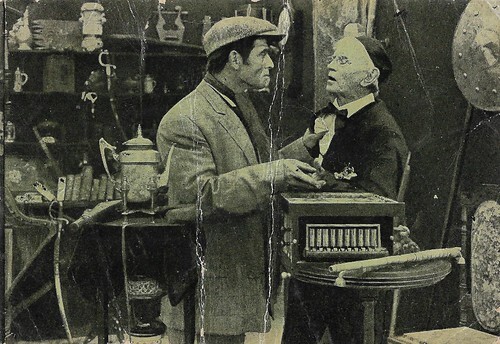
Spanish cromos (coloured minicard) by Chocolate Pi, Barcelona, card 1 (of 36). Photo: The Trans-Atlantic Film Co. Ltd. / Distr. J. Verdaguer. Eddie Polo and Doc Crane in The Broken Coin (Francis Ford, 1915).
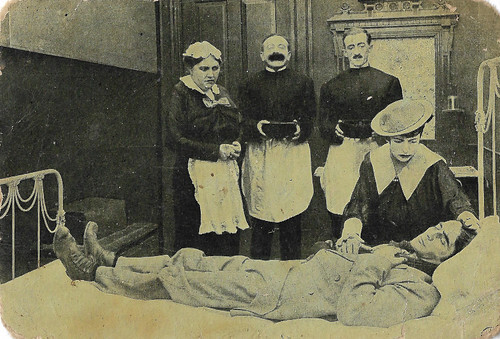
Spanish cromos (coloured minicard) by Chocolate Pi, Barcelona, card 2 (of 36). Photo: The Trans-Atlantic Film Co. Ltd. / Distr. J. Verdaguer. Grace Cunard and Eddie Polo in The Broken Coin (Francis Ford, 1915).
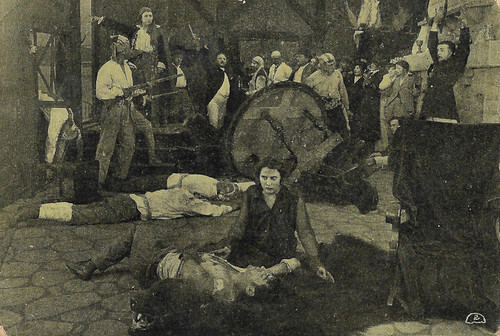
Spanish cromos (coloured minicard) by Chocolate Pi, Barcelona, card 3 (of 36). Photo: The Trans-Atlantic Film Co. Ltd. / Distr. J. Verdaguer. Scene from The Broken Coin (Francis Ford, 1915).
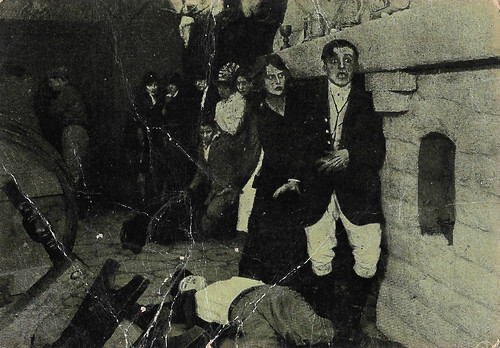
Spanish cromos (coloured minicard) by Chocolate Pi, Barcelona, card 8 (we miss cards 4 to 7). Photo: The Trans-Atlantic Film Co. Ltd. / Distr. J. Verdaguer. Scene from The Broken Coin (Francis Ford, 1915).
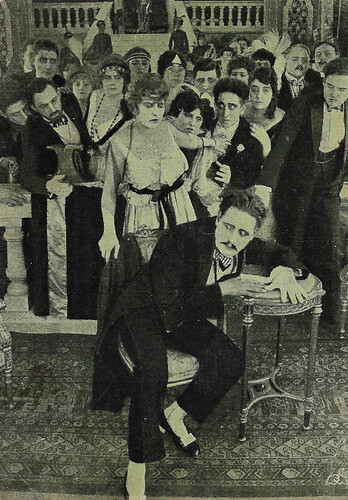
Spanish cromos (coloured minicard) by Chocolate Pi, Barcelona, card 9 (of 36). Photo: The Trans-Atlantic Film Co. Ltd. / Distr. J. Verdaguer. Scene from The Broken Coin (Francis Ford, 1915).
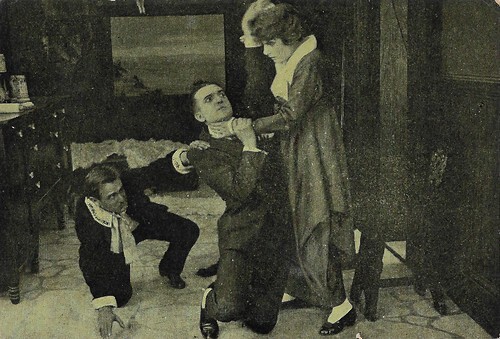
Spanish cromos (coloured minicard) by Chocolate Pi, Barcelona, card 10 (of 36). Photo: The Trans-Atlantic Film Co. Ltd. / Distr. J. Verdaguer. Scene from The Broken Coin (Francis Ford, 1915).
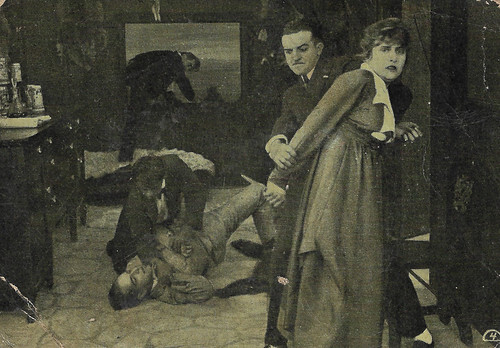
Spanish cromos (coloured minicard) by Chocolate Pi, Barcelona, card 11 (of 36). Photo: The Trans-Atlantic Film Co. Ltd. / Distr. J. Verdaguer. Scene from The Broken Coin (Francis Ford, 1915).
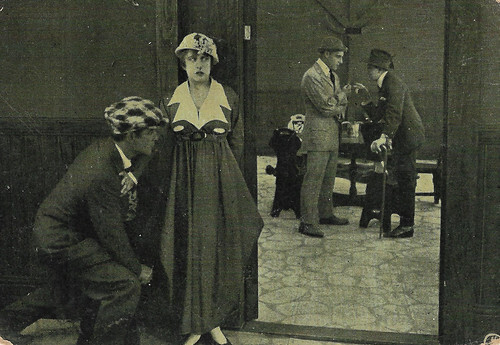
Spanish cromos (coloured minicard) by Chocolate Pi, Barcelona, card 14 (we miss 12 and 13). Photo: The Trans-Atlantic Film Co. Ltd. / Distr. J. Verdaguer. Scene from The Broken Coin (Francis Ford, 1915).
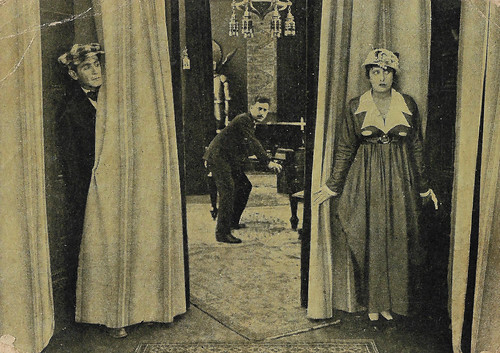
Spanish cromos (coloured minicard) by Chocolate Pi, Barcelona, card 15 (of 36). Photo: The Trans-Atlantic Film Co. Ltd. / Distr. J. Verdaguer. Scene from The Broken Coin (Francis Ford, 1915).
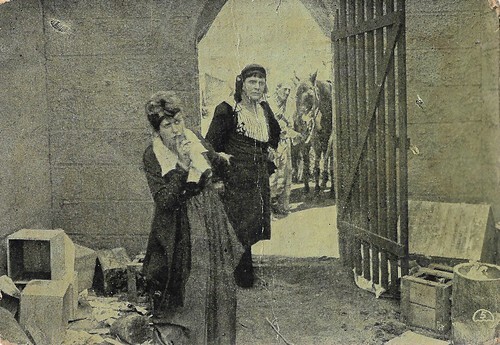
Spanish cromos (coloured minicard) by Chocolate Pi, Barcelona, card 16 (of 36). Photo: The Trans-Atlantic Film Co. Ltd. / Distr. J. Verdaguer. Scene from The Broken Coin (Francis Ford, 1915).
An athletic reporter with a nose for news
At Women Film Pioneers Project , Jennifer M. Bean writes about the career of serial queen Grace Cunard : "Lauded as making the most 'popular' of films, Cunard’s stories tend toward the fantastic, and her female characters tend toward the fantastically unconventional." Cunard performed in over one hundred silent-era films, including five of Universal Studio’s most popular adventure serials in the 1910s. One of these five serials was The Broken Coin (Francis Ford, 1915).
Grace Cunard stars in the serial as Kitty Grey, an athletic reporter with a nose for news. In the first part of the 22 parts of the serial, Kitty leaves her office for lunch. On her way to the restaurant, she sees in an old curiosity shop half of a broken coin, inscribed in Latin. The name 'Gretzhoffen' attracts her attention, and she buys the mysterious coin. On her way out of the shop, she drops the papers she is carrying, which are picked up and handed to her by a foreign-looking stranger named Rolleaux ( Eddie Polo ). He had been watching the coin before Kitty came along. When the man enters the shop to buy the coin the owner of the curiosity shop (Doc Crane) tells him that the young lady who just left the shop bought it.
This is the start of an impossible, lengthy plot with hundreds of plot turns, and a Ruritania setting. The basis is that the mighty Count Frederick ( Francis Ford ) wants to overthrow the puppet ruler and weakling, King Michael of Gretzhoffen (Harry Schumm). For this, he needs to obtain the two halves of a broken coin, that together point at the hidden treasures of the former King. Rolleaux, formerly Frederick's aide, instead becomes Kitty's helper. A constant fight about Kitty's half coin sets about, in which gradually also a gang of Apaches is involved who also want their piece of the cake.
The plot expands even more when Count Sacchio (Ernest Shields) of the neighbouring kingdom Grahoffen wants to get hold of the broken coin too, so his King Philip (Mark Fenton) may start a war against his neighbour and dethrone his rival. More and more, Frederick proves to be not as bad as thought. The sympathy between him and Kitty grows, when they together with Rolleaux and a small army of loyal soldiers, fight the enemy army, with success. In the end, it comes out that Frederick is the real heir to the throne, and the puppet king is kicked out. Kitty becomes Queen.
The Spanish release title of The Broken Coin was a literal translation, La Moneda Rota. J. Verdaguer, the Spanish distributor of the serial had bought it from Trans-Atlantic aka Transatlantic, the European distribution branch of Universal in the 1910s, with a central office in London. In the Spanish version of the serial, the main characters were named Lucille, Hugo and Polo.
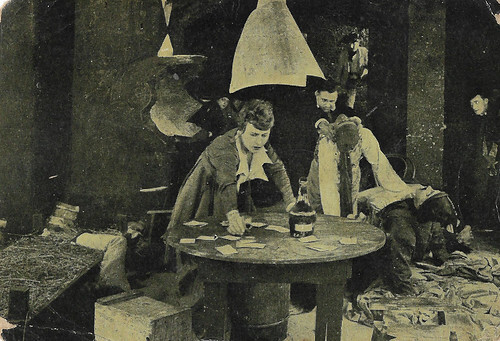
Spanish cromos (coloured minicard) by Chocolate Pi, Barcelona, card 17 (of 36). Photo: The Trans-Atlantic Film Co. Ltd. / Distr. J. Verdaguer. Scene from The Broken Coin (Francis Ford, 1915).

Spanish cromos (coloured minicard) by Chocolate Pi, Barcelona, card 18 (of 36). Photo: The Trans-Atlantic Film Co. Ltd. / Distr. J. Verdaguer. Scene from The Broken Coin (Francis Ford, 1915).
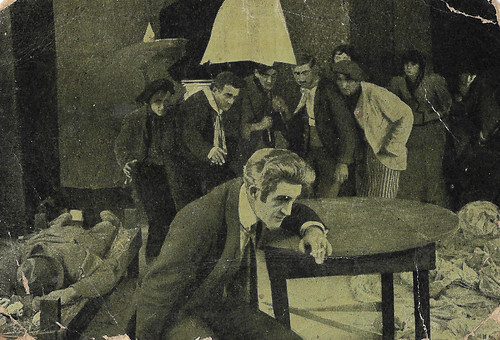
Spanish cromos (coloured minicard) by Chocolate Pi, Barcelona, card 19 (of 36). Photo: The Trans-Atlantic Film Co. Ltd. / Distr. J. Verdaguer. Francis Ford in The Broken Coin (Francis Ford, 1915).
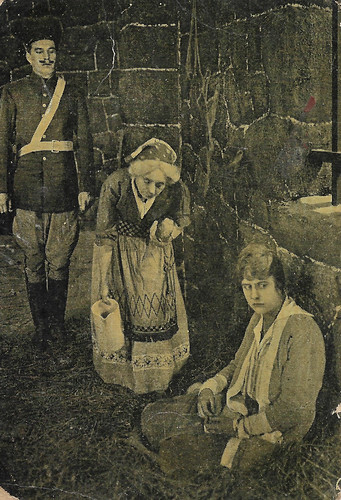
Spanish cromos (coloured minicard) by Chocolate Pi, Barcelona, card 20 (of 36). Photo: The Trans-Atlantic Film Co. Ltd. / Distr. J. Verdaguer. Scene from The Broken Coin (Francis Ford, 1915).
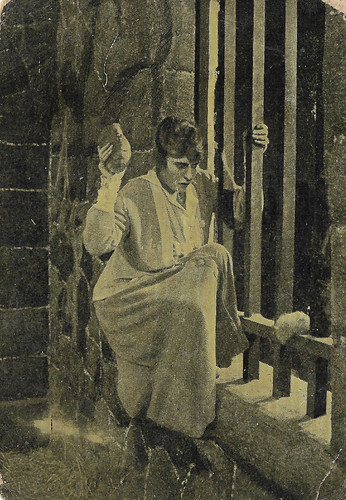
Spanish cromos (coloured minicard) by Chocolate Pi, Barcelona, card 21 (of 36). Photo: The Trans-Atlantic Film Co. Ltd. / Distr. J. Verdaguer. Scene from The Broken Coin (Francis Ford, 1915).
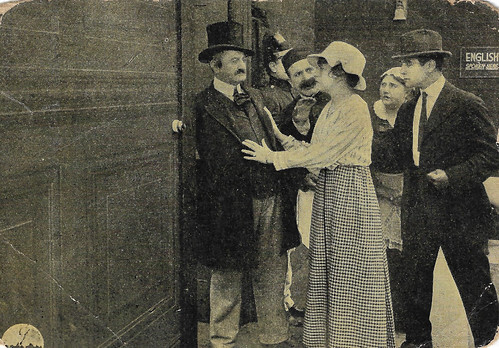
Spanish cromos (coloured minicard) by Chocolate Pi, Barcelona, card 23 (of 36). Photo: The Trans-Atlantic Film Co. Ltd. / Distr. J. Verdaguer. Scene from The Broken Coin (Francis Ford, 1915).
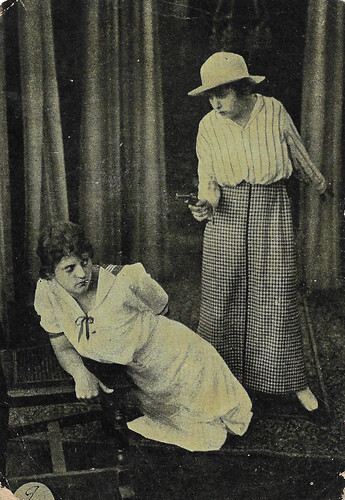
Spanish cromos (coloured minicard) by Chocolate Pi, Barcelona, card 24 (of 36). Photo: The Trans-Atlantic Film Co. Ltd. / Distr. J. Verdaguer. Scene from The Broken Coin (Francis Ford, 1915).
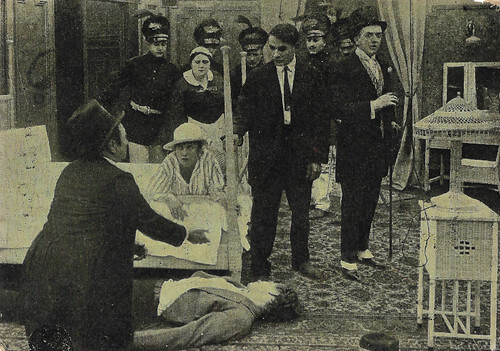
Spanish cromos (coloured minicard) by Chocolate Pi, Barcelona, card 25 (of 36). Photo: The Trans-Atlantic Film Co. Ltd. / Distr. J. Verdaguer. Scene from The Broken Coin (Francis Ford, 1915).
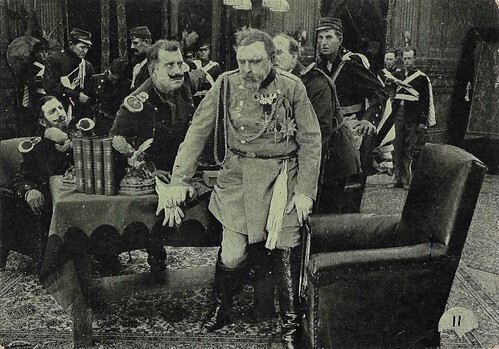
Spanish cromos (coloured minicard) by Chocolate Pi, Barcelona, card 26 (of 36). Photo: The Trans-Atlantic Film Co. Ltd. / Distr. J. Verdaguer. Scene from The Broken Coin (Francis Ford, 1915).
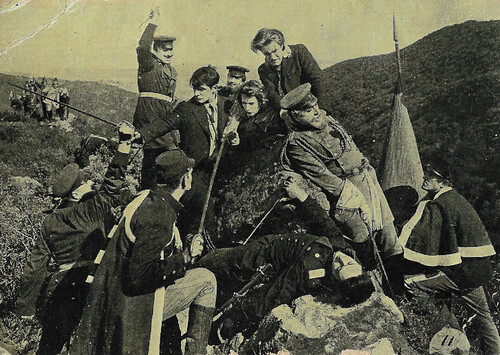
Spanish cromos (coloured minicard) by Chocolate Pi, Barcelona, card 27 (of 36). Photo: The Trans-Atlantic Film Co. Ltd. / Distr. J. Verdaguer. Scene from The Broken Coin (Francis Ford, 1915).
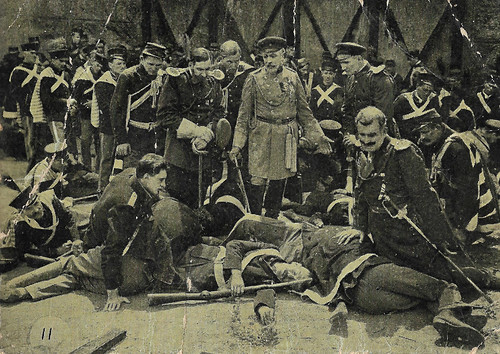
Spanish cromos (coloured minicard) by Chocolate Pi, Barcelona, card 28 (of 36). Photo: The Trans-Atlantic Film Co. Ltd. / Distr. J. Verdaguer. Scene from The Broken Coin (Francis Ford, 1915).
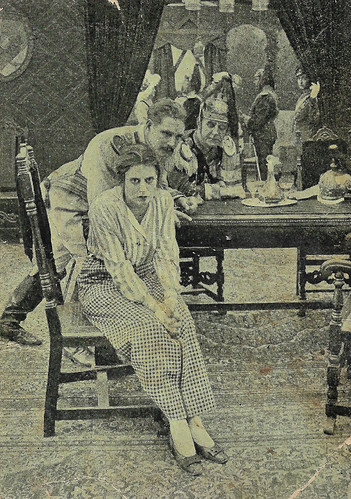
Spanish cromos (coloured minicard) by Chocolate Pi, Barcelona, card 29 (of 36). Photo: The Trans-Atlantic Film Co. Ltd. / Distr. J. Verdaguer. Scene from The Broken Coin (Francis Ford, 1915).
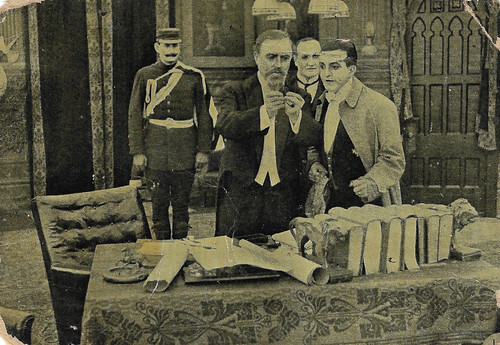
Spanish cromos (coloured minicard) by Chocolate Pi, Barcelona, card 30 (of 36). Photo: The Trans-Atlantic Film Co. Ltd. / Distr. J. Verdaguer. Scene from The Broken Coin (Francis Ford, 1915).
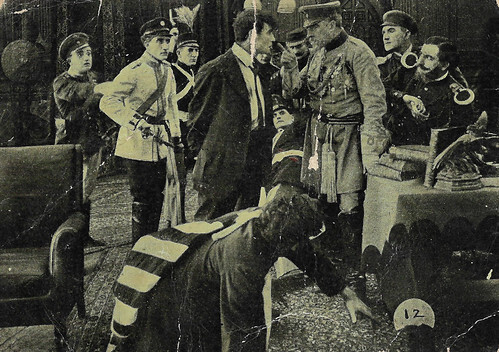
Spanish cromos (coloured minicard) by Chocolate Pi, Barcelona, card 31 (of 36). Photo: The Trans-Atlantic Film Co. Ltd. / Distr. J. Verdaguer. Scene from The Broken Coin (Francis Ford, 1915).
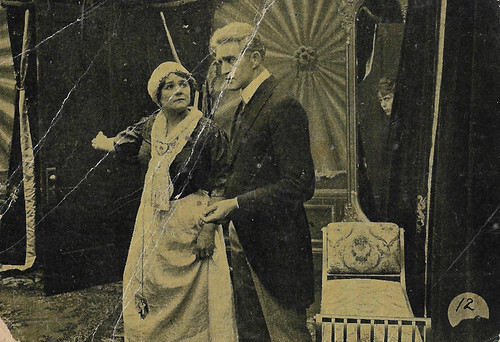
Spanish cromos (coloured minicard) by Chocolate Pi, Barcelona, card 32 (of 36). Photo: The Trans-Atlantic Film Co. Ltd. / Distr. J. Verdaguer. Scene from The Broken Coin (Francis Ford, 1915).
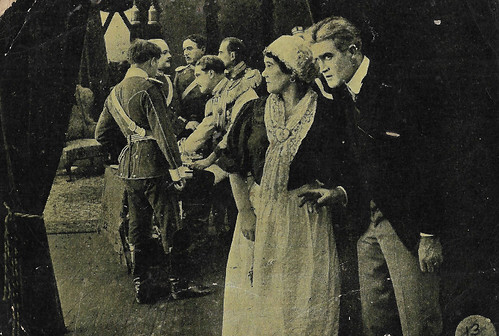
Spanish cromos (coloured minicard) by Chocolate Pi, Barcelona, card 33 (of 36). Photo: The Trans-Atlantic Film Co. Ltd. / Distr. J. Verdaguer. Scene from The Broken Coin (Francis Ford, 1915).
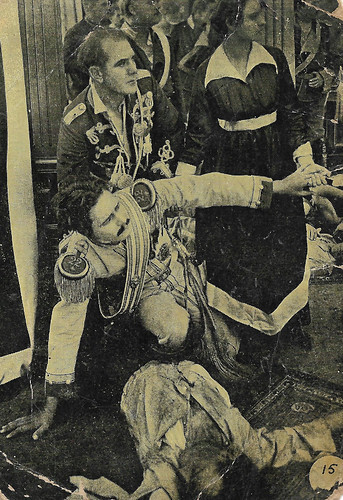
Spanish cromos (coloured minicard) by Chocolate Pi, Barcelona, card 34 (of 36). Photo: The Trans-Atlantic Film Co. Ltd. / Distr. J. Verdaguer. Scene from The Broken Coin (Francis Ford, 1915).
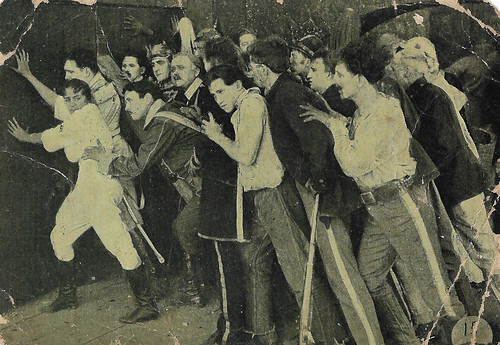
Spanish cromos (coloured minicard) by Chocolate Pi, Barcelona, card 35 (of 36). Photo: The Trans-Atlantic Film Co. Ltd. / Distr. J. Verdaguer. Scene from The Broken Coin (Francis Ford, 1915).
Sources: Jennifer M. Bean (Women Film Pioneers Project), Wikipedia and IMDb.

Spanish cromos (coloured minicard) by Chocolate Pi, Barcelona, card 1 (of 36). Photo: The Trans-Atlantic Film Co. Ltd. / Distr. J. Verdaguer. Eddie Polo and Doc Crane in The Broken Coin (Francis Ford, 1915).

Spanish cromos (coloured minicard) by Chocolate Pi, Barcelona, card 2 (of 36). Photo: The Trans-Atlantic Film Co. Ltd. / Distr. J. Verdaguer. Grace Cunard and Eddie Polo in The Broken Coin (Francis Ford, 1915).

Spanish cromos (coloured minicard) by Chocolate Pi, Barcelona, card 3 (of 36). Photo: The Trans-Atlantic Film Co. Ltd. / Distr. J. Verdaguer. Scene from The Broken Coin (Francis Ford, 1915).

Spanish cromos (coloured minicard) by Chocolate Pi, Barcelona, card 8 (we miss cards 4 to 7). Photo: The Trans-Atlantic Film Co. Ltd. / Distr. J. Verdaguer. Scene from The Broken Coin (Francis Ford, 1915).

Spanish cromos (coloured minicard) by Chocolate Pi, Barcelona, card 9 (of 36). Photo: The Trans-Atlantic Film Co. Ltd. / Distr. J. Verdaguer. Scene from The Broken Coin (Francis Ford, 1915).

Spanish cromos (coloured minicard) by Chocolate Pi, Barcelona, card 10 (of 36). Photo: The Trans-Atlantic Film Co. Ltd. / Distr. J. Verdaguer. Scene from The Broken Coin (Francis Ford, 1915).

Spanish cromos (coloured minicard) by Chocolate Pi, Barcelona, card 11 (of 36). Photo: The Trans-Atlantic Film Co. Ltd. / Distr. J. Verdaguer. Scene from The Broken Coin (Francis Ford, 1915).

Spanish cromos (coloured minicard) by Chocolate Pi, Barcelona, card 14 (we miss 12 and 13). Photo: The Trans-Atlantic Film Co. Ltd. / Distr. J. Verdaguer. Scene from The Broken Coin (Francis Ford, 1915).

Spanish cromos (coloured minicard) by Chocolate Pi, Barcelona, card 15 (of 36). Photo: The Trans-Atlantic Film Co. Ltd. / Distr. J. Verdaguer. Scene from The Broken Coin (Francis Ford, 1915).

Spanish cromos (coloured minicard) by Chocolate Pi, Barcelona, card 16 (of 36). Photo: The Trans-Atlantic Film Co. Ltd. / Distr. J. Verdaguer. Scene from The Broken Coin (Francis Ford, 1915).
An athletic reporter with a nose for news
At Women Film Pioneers Project , Jennifer M. Bean writes about the career of serial queen Grace Cunard : "Lauded as making the most 'popular' of films, Cunard’s stories tend toward the fantastic, and her female characters tend toward the fantastically unconventional." Cunard performed in over one hundred silent-era films, including five of Universal Studio’s most popular adventure serials in the 1910s. One of these five serials was The Broken Coin (Francis Ford, 1915).
Grace Cunard stars in the serial as Kitty Grey, an athletic reporter with a nose for news. In the first part of the 22 parts of the serial, Kitty leaves her office for lunch. On her way to the restaurant, she sees in an old curiosity shop half of a broken coin, inscribed in Latin. The name 'Gretzhoffen' attracts her attention, and she buys the mysterious coin. On her way out of the shop, she drops the papers she is carrying, which are picked up and handed to her by a foreign-looking stranger named Rolleaux ( Eddie Polo ). He had been watching the coin before Kitty came along. When the man enters the shop to buy the coin the owner of the curiosity shop (Doc Crane) tells him that the young lady who just left the shop bought it.
This is the start of an impossible, lengthy plot with hundreds of plot turns, and a Ruritania setting. The basis is that the mighty Count Frederick ( Francis Ford ) wants to overthrow the puppet ruler and weakling, King Michael of Gretzhoffen (Harry Schumm). For this, he needs to obtain the two halves of a broken coin, that together point at the hidden treasures of the former King. Rolleaux, formerly Frederick's aide, instead becomes Kitty's helper. A constant fight about Kitty's half coin sets about, in which gradually also a gang of Apaches is involved who also want their piece of the cake.
The plot expands even more when Count Sacchio (Ernest Shields) of the neighbouring kingdom Grahoffen wants to get hold of the broken coin too, so his King Philip (Mark Fenton) may start a war against his neighbour and dethrone his rival. More and more, Frederick proves to be not as bad as thought. The sympathy between him and Kitty grows, when they together with Rolleaux and a small army of loyal soldiers, fight the enemy army, with success. In the end, it comes out that Frederick is the real heir to the throne, and the puppet king is kicked out. Kitty becomes Queen.
The Spanish release title of The Broken Coin was a literal translation, La Moneda Rota. J. Verdaguer, the Spanish distributor of the serial had bought it from Trans-Atlantic aka Transatlantic, the European distribution branch of Universal in the 1910s, with a central office in London. In the Spanish version of the serial, the main characters were named Lucille, Hugo and Polo.

Spanish cromos (coloured minicard) by Chocolate Pi, Barcelona, card 17 (of 36). Photo: The Trans-Atlantic Film Co. Ltd. / Distr. J. Verdaguer. Scene from The Broken Coin (Francis Ford, 1915).

Spanish cromos (coloured minicard) by Chocolate Pi, Barcelona, card 18 (of 36). Photo: The Trans-Atlantic Film Co. Ltd. / Distr. J. Verdaguer. Scene from The Broken Coin (Francis Ford, 1915).

Spanish cromos (coloured minicard) by Chocolate Pi, Barcelona, card 19 (of 36). Photo: The Trans-Atlantic Film Co. Ltd. / Distr. J. Verdaguer. Francis Ford in The Broken Coin (Francis Ford, 1915).

Spanish cromos (coloured minicard) by Chocolate Pi, Barcelona, card 20 (of 36). Photo: The Trans-Atlantic Film Co. Ltd. / Distr. J. Verdaguer. Scene from The Broken Coin (Francis Ford, 1915).

Spanish cromos (coloured minicard) by Chocolate Pi, Barcelona, card 21 (of 36). Photo: The Trans-Atlantic Film Co. Ltd. / Distr. J. Verdaguer. Scene from The Broken Coin (Francis Ford, 1915).

Spanish cromos (coloured minicard) by Chocolate Pi, Barcelona, card 23 (of 36). Photo: The Trans-Atlantic Film Co. Ltd. / Distr. J. Verdaguer. Scene from The Broken Coin (Francis Ford, 1915).

Spanish cromos (coloured minicard) by Chocolate Pi, Barcelona, card 24 (of 36). Photo: The Trans-Atlantic Film Co. Ltd. / Distr. J. Verdaguer. Scene from The Broken Coin (Francis Ford, 1915).

Spanish cromos (coloured minicard) by Chocolate Pi, Barcelona, card 25 (of 36). Photo: The Trans-Atlantic Film Co. Ltd. / Distr. J. Verdaguer. Scene from The Broken Coin (Francis Ford, 1915).

Spanish cromos (coloured minicard) by Chocolate Pi, Barcelona, card 26 (of 36). Photo: The Trans-Atlantic Film Co. Ltd. / Distr. J. Verdaguer. Scene from The Broken Coin (Francis Ford, 1915).

Spanish cromos (coloured minicard) by Chocolate Pi, Barcelona, card 27 (of 36). Photo: The Trans-Atlantic Film Co. Ltd. / Distr. J. Verdaguer. Scene from The Broken Coin (Francis Ford, 1915).

Spanish cromos (coloured minicard) by Chocolate Pi, Barcelona, card 28 (of 36). Photo: The Trans-Atlantic Film Co. Ltd. / Distr. J. Verdaguer. Scene from The Broken Coin (Francis Ford, 1915).

Spanish cromos (coloured minicard) by Chocolate Pi, Barcelona, card 29 (of 36). Photo: The Trans-Atlantic Film Co. Ltd. / Distr. J. Verdaguer. Scene from The Broken Coin (Francis Ford, 1915).

Spanish cromos (coloured minicard) by Chocolate Pi, Barcelona, card 30 (of 36). Photo: The Trans-Atlantic Film Co. Ltd. / Distr. J. Verdaguer. Scene from The Broken Coin (Francis Ford, 1915).

Spanish cromos (coloured minicard) by Chocolate Pi, Barcelona, card 31 (of 36). Photo: The Trans-Atlantic Film Co. Ltd. / Distr. J. Verdaguer. Scene from The Broken Coin (Francis Ford, 1915).

Spanish cromos (coloured minicard) by Chocolate Pi, Barcelona, card 32 (of 36). Photo: The Trans-Atlantic Film Co. Ltd. / Distr. J. Verdaguer. Scene from The Broken Coin (Francis Ford, 1915).

Spanish cromos (coloured minicard) by Chocolate Pi, Barcelona, card 33 (of 36). Photo: The Trans-Atlantic Film Co. Ltd. / Distr. J. Verdaguer. Scene from The Broken Coin (Francis Ford, 1915).

Spanish cromos (coloured minicard) by Chocolate Pi, Barcelona, card 34 (of 36). Photo: The Trans-Atlantic Film Co. Ltd. / Distr. J. Verdaguer. Scene from The Broken Coin (Francis Ford, 1915).

Spanish cromos (coloured minicard) by Chocolate Pi, Barcelona, card 35 (of 36). Photo: The Trans-Atlantic Film Co. Ltd. / Distr. J. Verdaguer. Scene from The Broken Coin (Francis Ford, 1915).
Sources: Jennifer M. Bean (Women Film Pioneers Project), Wikipedia and IMDb.
Published on June 20, 2023 22:00
June 19, 2023
Errol Flynn
Australian-born actor Errol Flynn (1909-1959) achieved fame in Hollywood with his suave, debonair, devil-may-care attitude. He was known for his romantic Swashbuckler roles in films like Captain Blood (1935) and The Adventures of Robin Hood (1938), often co-starring with Olivia de Havilland. In 1942, the tall, athletic and exceptionally handsome, Flynn became an American citizen. He developed a reputation for womanising, hard-drinking and for a time in the 1940s, narcotics abuse. He was linked romantically with Lupe Vélez, Marlene Dietrich, and Dolores del Río, among many others.
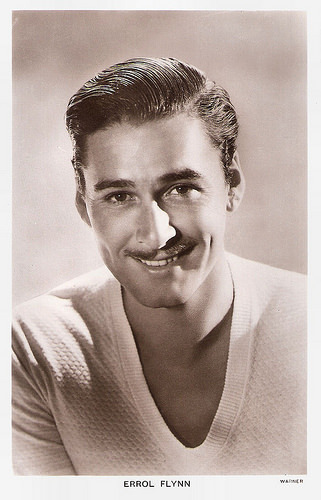
British postcard in the Picturegoer Series, no. 1301. Photo: Warner Bros.
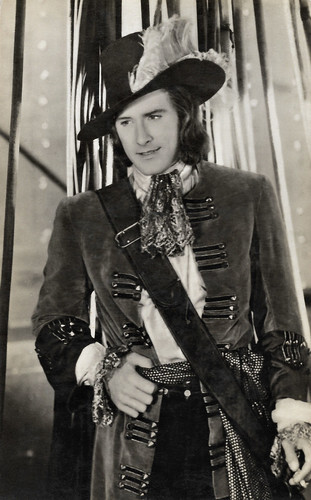
Vintage postcard. Errol Flynn in Captain Blood (Michael Curtiz, 1935).
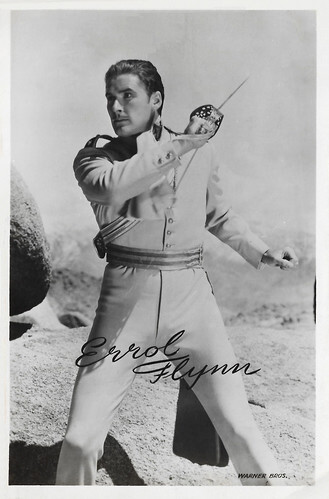
Dutch postcard by Takken / 't Sticht, no. a.x. 399. Photo: Warner Bros. Errol Flynn in The Charge of the Light Brigade (Michael Curtiz, 1936).
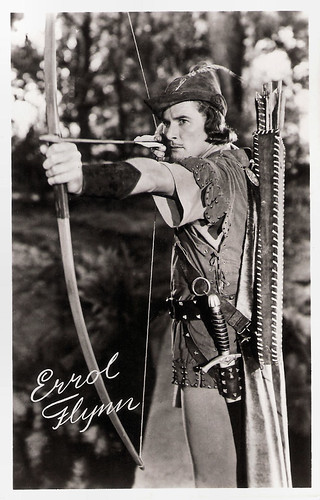
Dutch card. Photo: Warner Bros. Errol Flynn in The Adventures of Robin Hood (Michael Curtiz, William Keighley, 1938).
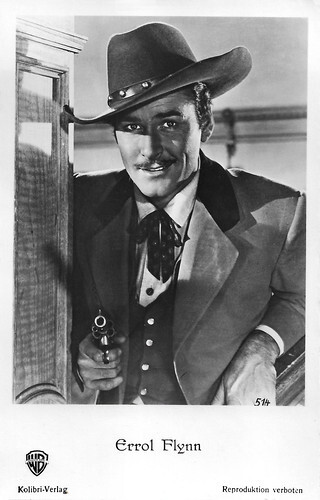
West-German postcard by Kolibri-Verlag, no. 514. Photo: Warner Bros. Errol Flynn in San Antonio (David Butler, Robert Florey, Raoul Walsh, 1945).
Pilfering petty cash
Errol Leslie Thomson Flynn was born in a suburb of Hobart, Tasmania, in 1909. His father, Theodore Flynn, was a lecturer and later professor of biology at the University of Tasmania. His mother was Lily Mary Young. After early schooling in Hobart, from 1923 to 1925 Flynn was educated at the South West London College, a private boarding school in Barnes, London.
In 1926 he returned to Australia to attend Sydney Church of England Grammar School (Shore School) where he was the classmate of a future Australian prime minister, John Gorton. His formal education ended with his expulsion from Shore for theft. After being dismissed from a job as a junior clerk with a Sydney shipping company for pilfering petty cash, he went to Papua New Guinea at the age of eighteen, seeking his fortune in tobacco planting and metals mining.
Flynn spent the next five years oscillating between the New Guinea frontier territory and Sydney. In early 1933, Flynn appeared as an amateur actor in the low-budget Australian film In the Wake of the Bounty (Charles Chauvel, 1933), in the lead role of Fletcher Christian.
Later that year he returned to Britain to pursue a career in acting and soon secured a job with the Northampton Repertory Company at the town's Royal Theatre, where he worked and received his training as a professional actor for seven months. In 1934 Flynn was dismissed from Northampton Rep. reportedly after he threw a female stage manager down a stairwell.
He returned to Warner Brothers' Teddington Studios in Middlesex where he had worked as an extra in the film I Adore You (George King, 1933) before going to Northampton. With his new-found acting skills, he was cast as the lead in Murder at Monte Carlo (Ralph Ince, 1935), now considered a lost film. During its filming, he was spotted by a talent scout for Warner Bros. and Flynn emigrated to the U.S. as a contract actor.
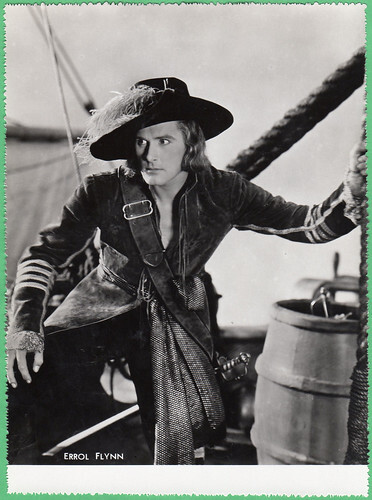
Belgian collectors card by Chocolaterie Clovis, Pepinster. Photo: publicity still for Captain Blood (Michael Curtiz, 1935). Collection: Amit Benyovits.
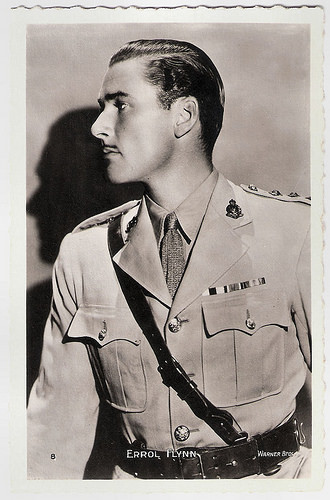
French postcard by Editions Chantal, Rueil-Malmaison, no. 8. Photo: Warner Bros. Publicity still for Another Dawn (William Dieterle, 1937).
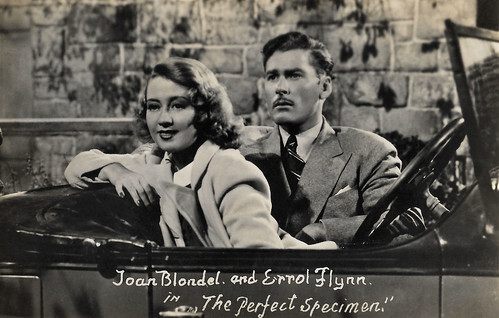
American postcard by K Ltd. Joan Blondell and Errol Flynn in The Perfect Specimen (Michael Curtiz, 1937).
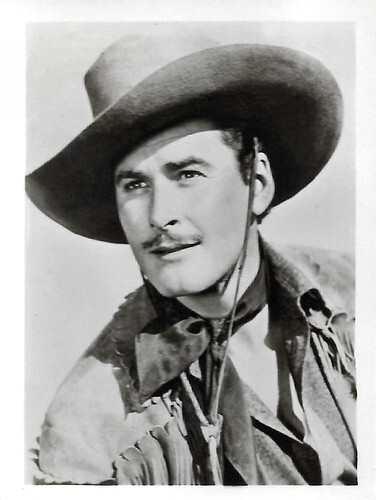
Small German collectors card in the 'Film Stars der Welt ' series by Greiling-Sammelbilder, series E, no. ?25. Photo: Warner Bros. Errol Flynn in Dodge City (Michael Curtiz, 1939).
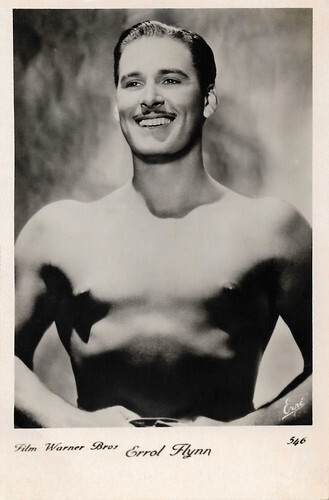
French postcard by Erpé, no. 546. Photo: Warner Bros.
Striking good looks
In Hollywood, Errol Flynn was first cast in two insignificant films, but then he got his great chance. He could replace Robert Donat in the title role of Captain Blood (Michael Curtiz, 1935). Flynn's natural athletic talent and good looks rocketed him overnight to international stardom.
Over the next six years, he was typecast as a dashing adventurer in The Charge of the Light Brigade (Michael Curtiz, 1936), The Prince and the Pauper (William Keighley, 1937), The Adventures of Robin Hood (Michael Curtiz, William Keighley, 1938; his first Technicolor film), The Dawn Patrol (Edmund Goulding, 1938) with David Niven , Dodge City (Michael Curtiz, 1939), The Private Lives of Elizabeth and Essex (Michael Curtiz, 1939) and The Sea Hawk (Michael Curtiz, 1940).
His striking good looks and screen charisma won him millions of fans. Flynn played an integral role in the re-invention of the action-adventure genre. In collaboration with Hollywood's best fight arrangers, Flynn became noted for fast-paced sword fights. He demonstrated an acting range beyond action-adventure roles in light contemporary social comedies, such as The Perfect Specimen (Michael Curtiz, 1937) and Four's a Crowd (Michael Curtiz, 1938), and the melodrama The Sisters (Anatole Litvak, 1938).
During this period Flynn published his first book, 'Beam Ends' (1937), an autobiographical account of his sailing experiences around Australia as a youth. He also travelled to Spain, in 1937, as a war correspondent during the Spanish Civil War.
Flynn co-starred with Olivia de Havilland a total of eight times, and together they made the most successful on-screen romantic partnership in Hollywood in the late 1930s-early 1940s in eight films. Flynn's relationship with Bette Davis , his co-star in The Private Lives of Elizabeth and Essex (Michael Curtiz, 1939), was quarrelsome. Davis allegedly slapped him across the face far harder than necessary during one scene.
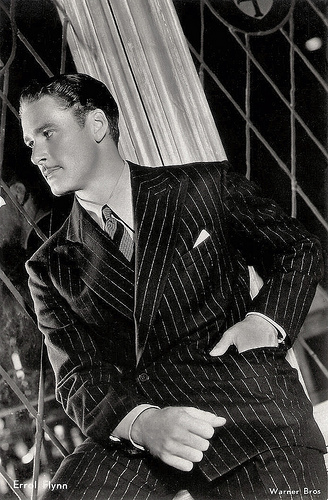
Dutch postcard by M.B.&Z., no. 1050. Photo: Warner Bros.
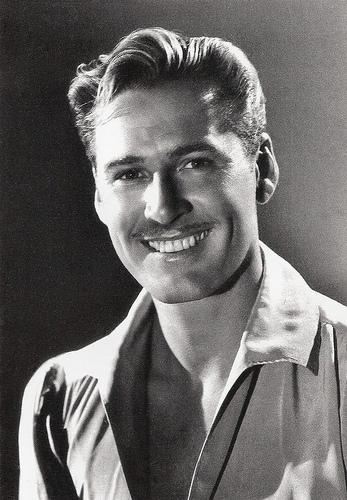
German postcard by Edition Cicero, Hamburg, no. 150/10. Photo: Elmer Fryer, 1936 / The Kobal Collection.
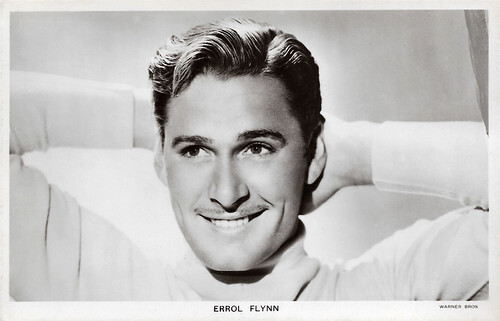
British postcard in the Picturegoer Series, London, no. W 65. Photo: Warner Bros.
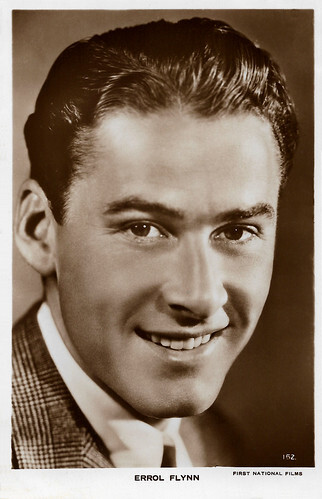
British postcard by Milton, no. 152. Photo: First National Films.
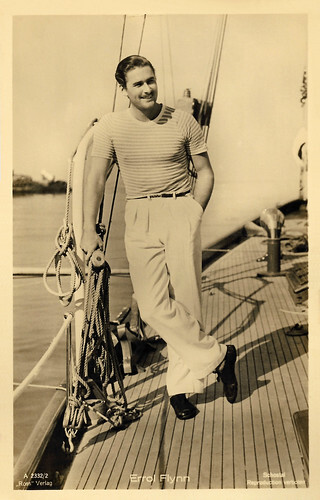
German postcard by Ross Verlag, no. A 2332/2, 1939-1940. Photo: Schostal.
Paragon of male physical prowess
In 1940, at the zenith of his career, Erroll Flynn was voted the fourth most popular star in the US. Flynn became a naturalised American citizen in 1942. As the United States had by then entered the Second World War, he attempted to enlist in the armed services but failed the physical exam due to multiple heart problems and other diseases.
This created an image problem for both Flynn, the supposed paragon of male physical prowess, and for Warner Brothers, which continued to cast him in athletic roles, including such patriotic productions as Dive Bomber (Michael Curtiz, 1941), Desperate Journey (Raoul Walsh, 1942) and Objective, Burma! (Raoul Walsh, 1945).
His womanising lifestyle caught up with him in 1942 when two underage girls, Betty Hansen and Peggy Satterlee, accused him of statutory rape at the Bel Air home of Flynn's friend Frederick McEvoy, and on board Flynn's yacht, respectively. The scandal received immense press attention. Many of Flynn's fans, assuming that his screen persona was a reflection of his actual personality, refused to accept that the charges were true. Flynn was acquitted, but the trial's widespread coverage and lurid overtones permanently damaged his carefully cultivated screen image as an idealised romantic leading player.
In 1946, Flynn published an adventure novel, Showdown, and earned a reported $184,000. In 1947 he signed a 15-year contract with Warner Bros. for $225,000 per film. After the Second World War, the taste of the American film-going audience changed from European-themed material and the English history-based escapist epics in which Flynn excelled to more gritty, urban realism and Film Noir, reflecting modern American life.
Flynn tried unsuccessfully to make the transition in Uncertain Glory (Raoul Walsh, 1944) with Paul Lukas , Cry Wolf (Peter Godfrey, 1947) with Barbara Stanwyck , and then increasingly passé Westerns such as Silver River (Raoul Walsh, 1948) and Montana (Ray Enright, 1950). Flynn's behaviour became increasingly disruptive during filming; he was released from his contract in 1950 by Jack L. Warner as part of a stable-clearing of 1930s glamour-generation stars. His Hollywood career over at the age of 41, Flynn entered a steep financial and physical decline.
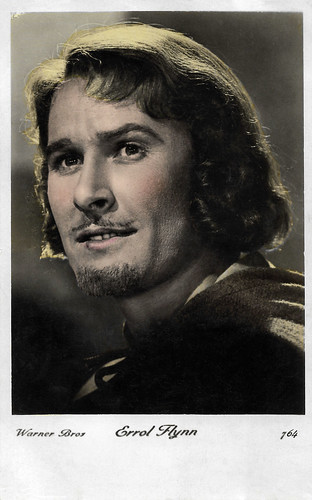
French postcard, no. 764. Photo: Warner Bros. Errol Flynn in The Adventures of Robin Hood (Michael Curtiz, William Keighley, 1938).
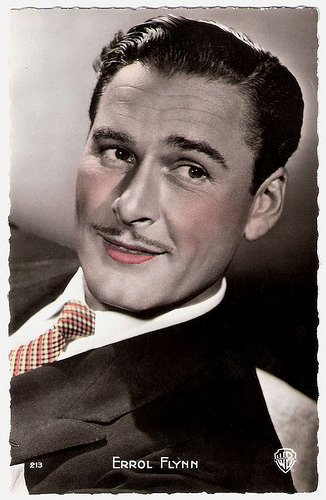
French postcard by Éditions P.I., Paris, no. 213. Photo: Warner Bros.
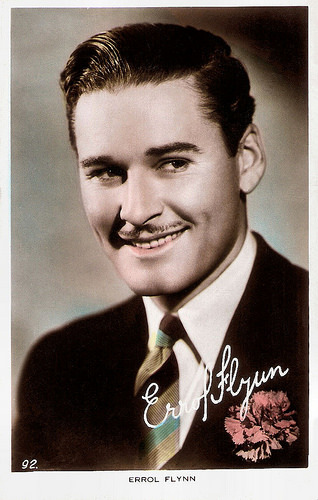
British postcard by Art Photo, no. 92.
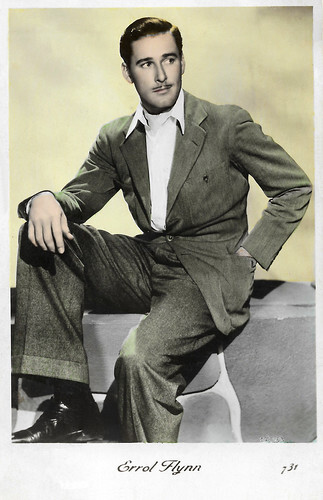
French postcard, no. 731.
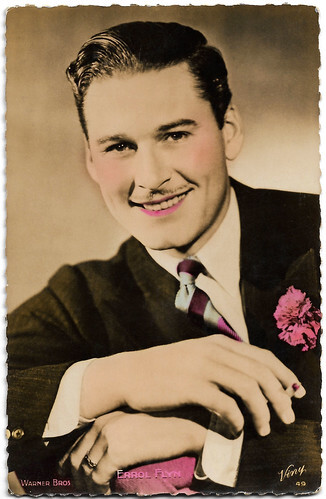
French postcard by Viny, no. 49. Photo: Warner Bros.
A parody of himself
In the 1950s, Errol Flynn became a parody of himself. He lost his savings from the Hollywood years in a series of financial disasters, including The Story of William Tell (Jack Cardiff, 1954) with Waltraut Haas . Aimlessly he sailed around the Western Mediterranean aboard his yacht Zaca. Heavy alcohol abuse left him prematurely aged and overweight.
He staved off financial ruin with roles in forgettable productions such as Hello God (William Marshall, 1951), Il maestro di Don Giovanni/Crossed Swords (Milton Krims, 1954) opposite Gina Lollobrigida and King's Rhapsody (Herbert Wilcox, 1955) with Anna Neagle .
He performed in such also-ran Hollywood films as Mara Maru (Gordon Douglas, 1952) and Istanbul (Joseph Pevney, 1957) with Cornell Borchers , and made occasional television appearances. As early as 1952 he had been seriously ill with hepatitis resulting in liver damage. In 1956 he presented and sometimes performed in the television anthology series The Errol Flynn Theatre which was filmed in Britain.
He enjoyed a brief revival of popularity with The Sun Also Rises (Henry King, 1957), The Big Boodle (Richard Wilson, 1957), filmed in Cuba; Too Much, Too Soon (Art Napoleon, 1958), and The Roots of Heaven (John Huston, 1958) with Juliette Gréco . In these films, he played drunks and washed-out bums and brought a poignancy to his performances that had not been there during his glamorous heydays.
He met with Stanley Kubrick to discuss a role in Lolita, but nothing came of it. Flynn went to Cuba in late 1958 to film the self-produced B film Cuban Rebel Girls (Barry Mahon, 1959), where he met Fidel Castro and was initially an enthusiastic supporter of the Cuban Revolution. He wrote a series of newspaper and magazine articles for the New York Journal American and other publications documenting his time in Cuba with Castro. Many of these pieces were lost until 2009 when they were rediscovered in a collection at the University of Texas at Austin's Center for American History. He narrated a short film titled Cuban Story: The Truth About Fidel Castro Revolution (1959), his last known work as an actor.
He published his autobiography, 'My Wicked Wicked Ways'. In 1959, Errol Flynn died of a heart attack in Vancouver, Canada. He was married three times. His first wife was actress Lily Damita (1935-1942). They had one son, actor and war correspondent Sean Flynn (1941-1971). Sean and his colleague Dana Stone disappeared in Cambodia in 1970, during the Vietnam War, while both were working as freelance photojournalists for Time magazine. It is generally assumed that they were killed by Khmer Rouge guerrillas.
Errol was married a second time to Nora Eddington from 1943 to 1949. They had two daughters, Deirdre (1945) and Rory (1947). His third wife was actress Patrice Wymore from 1950 until his death. They had one daughter, Arnella Roma (1953–1998). In 1980, author Charles Higham published a controversial biography, Errol Flynn: The Untold Story, in which he alleged that Flynn was a fascist sympathiser who spied for the Nazis before and during the Second World War and that he was bisexual and had multiple gay affairs. Later Flynn biographers were critical of Higham's allegations and found no evidence to corroborate them.
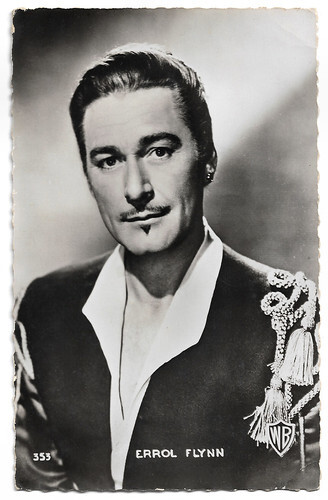
French postcard by Edition P.I., offered by Les Carbones Korès, no. 353. Photo: Warner Bros, 1953. Errol Flynn in Adventures of Don Juan (Vincent Sherman, 1948).
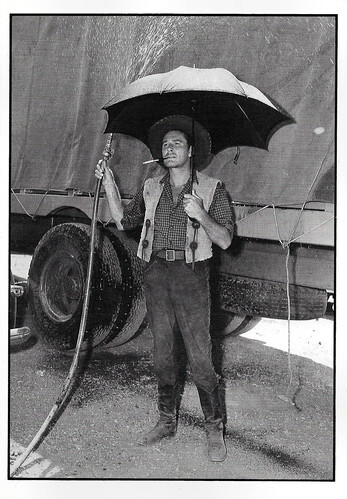
French postcard in the Entr'acte series by Éditions Asphodèle, Mâcon, no. 003/5. Collection: B. Courtel / D.R. Errol Flynn on the set of Montana (Ray Enright, 1949). Caption: A solution to refresh yourself without getting wet! Errol Flynn, in between takes, can't stand the heat of the Hollywood summer.
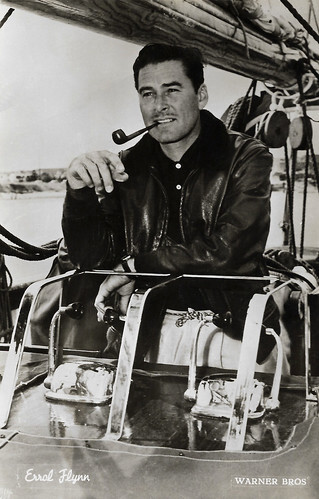
Vintage postcard. Photo: Warner Bros. Errol Flynn on his sailing boat the "Zacca".
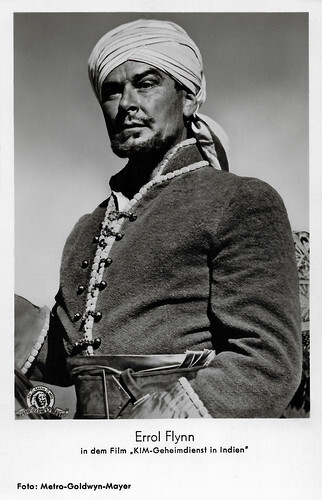
West German postcard by F.J. Rüdel, Filmpostkartenverlag, Hamburg-Bergedorf, no. 295. Photo: Metro-Goldwyn-Mayer. Errol Flynn in Kim (Victor Saville, 1950).
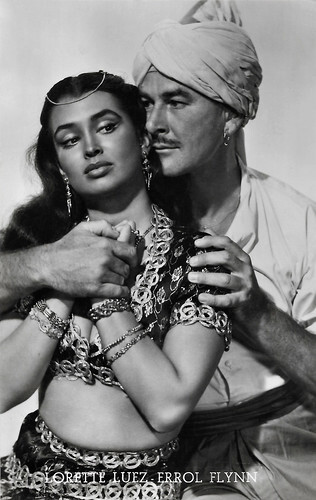
Belgian postcard, no. 731. Photo: Metro-Goldwyn-Mayer. Errol Flynn and Laurette Luez in Kim (Victor Saville, 1950).
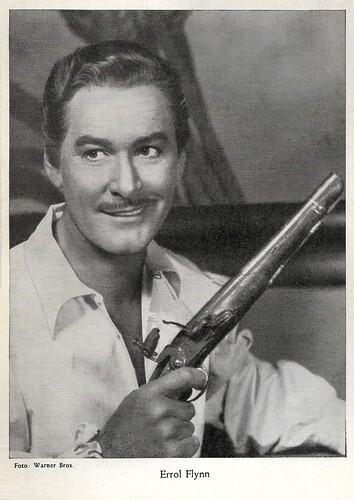
Vintage card. Photo: Warner Bros. Errol Flynn in Against All Flags (George Sherman, 1952).
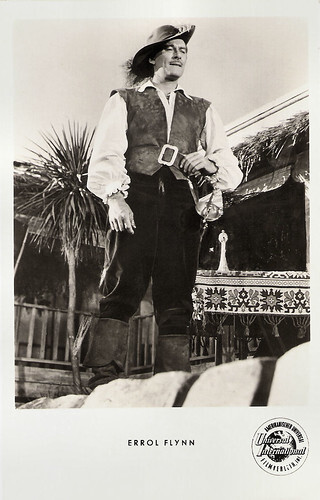
German postcard by Kunst und Bild, Berlin, no. A 454. Photo: Universal International. Publicity still for Against All Flags (George Sherman, 1952).
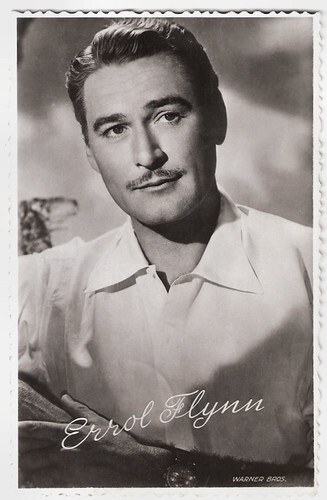
Dutch postcard by 't Sticht, Utrecht, no. 3059. Photo: Warner Bros. Sent by mail in the former Dutch Indies in 1949.
Sources: (IMDb), Wikipedia and .

British postcard in the Picturegoer Series, no. 1301. Photo: Warner Bros.

Vintage postcard. Errol Flynn in Captain Blood (Michael Curtiz, 1935).

Dutch postcard by Takken / 't Sticht, no. a.x. 399. Photo: Warner Bros. Errol Flynn in The Charge of the Light Brigade (Michael Curtiz, 1936).

Dutch card. Photo: Warner Bros. Errol Flynn in The Adventures of Robin Hood (Michael Curtiz, William Keighley, 1938).

West-German postcard by Kolibri-Verlag, no. 514. Photo: Warner Bros. Errol Flynn in San Antonio (David Butler, Robert Florey, Raoul Walsh, 1945).
Pilfering petty cash
Errol Leslie Thomson Flynn was born in a suburb of Hobart, Tasmania, in 1909. His father, Theodore Flynn, was a lecturer and later professor of biology at the University of Tasmania. His mother was Lily Mary Young. After early schooling in Hobart, from 1923 to 1925 Flynn was educated at the South West London College, a private boarding school in Barnes, London.
In 1926 he returned to Australia to attend Sydney Church of England Grammar School (Shore School) where he was the classmate of a future Australian prime minister, John Gorton. His formal education ended with his expulsion from Shore for theft. After being dismissed from a job as a junior clerk with a Sydney shipping company for pilfering petty cash, he went to Papua New Guinea at the age of eighteen, seeking his fortune in tobacco planting and metals mining.
Flynn spent the next five years oscillating between the New Guinea frontier territory and Sydney. In early 1933, Flynn appeared as an amateur actor in the low-budget Australian film In the Wake of the Bounty (Charles Chauvel, 1933), in the lead role of Fletcher Christian.
Later that year he returned to Britain to pursue a career in acting and soon secured a job with the Northampton Repertory Company at the town's Royal Theatre, where he worked and received his training as a professional actor for seven months. In 1934 Flynn was dismissed from Northampton Rep. reportedly after he threw a female stage manager down a stairwell.
He returned to Warner Brothers' Teddington Studios in Middlesex where he had worked as an extra in the film I Adore You (George King, 1933) before going to Northampton. With his new-found acting skills, he was cast as the lead in Murder at Monte Carlo (Ralph Ince, 1935), now considered a lost film. During its filming, he was spotted by a talent scout for Warner Bros. and Flynn emigrated to the U.S. as a contract actor.

Belgian collectors card by Chocolaterie Clovis, Pepinster. Photo: publicity still for Captain Blood (Michael Curtiz, 1935). Collection: Amit Benyovits.

French postcard by Editions Chantal, Rueil-Malmaison, no. 8. Photo: Warner Bros. Publicity still for Another Dawn (William Dieterle, 1937).

American postcard by K Ltd. Joan Blondell and Errol Flynn in The Perfect Specimen (Michael Curtiz, 1937).

Small German collectors card in the 'Film Stars der Welt ' series by Greiling-Sammelbilder, series E, no. ?25. Photo: Warner Bros. Errol Flynn in Dodge City (Michael Curtiz, 1939).

French postcard by Erpé, no. 546. Photo: Warner Bros.
Striking good looks
In Hollywood, Errol Flynn was first cast in two insignificant films, but then he got his great chance. He could replace Robert Donat in the title role of Captain Blood (Michael Curtiz, 1935). Flynn's natural athletic talent and good looks rocketed him overnight to international stardom.
Over the next six years, he was typecast as a dashing adventurer in The Charge of the Light Brigade (Michael Curtiz, 1936), The Prince and the Pauper (William Keighley, 1937), The Adventures of Robin Hood (Michael Curtiz, William Keighley, 1938; his first Technicolor film), The Dawn Patrol (Edmund Goulding, 1938) with David Niven , Dodge City (Michael Curtiz, 1939), The Private Lives of Elizabeth and Essex (Michael Curtiz, 1939) and The Sea Hawk (Michael Curtiz, 1940).
His striking good looks and screen charisma won him millions of fans. Flynn played an integral role in the re-invention of the action-adventure genre. In collaboration with Hollywood's best fight arrangers, Flynn became noted for fast-paced sword fights. He demonstrated an acting range beyond action-adventure roles in light contemporary social comedies, such as The Perfect Specimen (Michael Curtiz, 1937) and Four's a Crowd (Michael Curtiz, 1938), and the melodrama The Sisters (Anatole Litvak, 1938).
During this period Flynn published his first book, 'Beam Ends' (1937), an autobiographical account of his sailing experiences around Australia as a youth. He also travelled to Spain, in 1937, as a war correspondent during the Spanish Civil War.
Flynn co-starred with Olivia de Havilland a total of eight times, and together they made the most successful on-screen romantic partnership in Hollywood in the late 1930s-early 1940s in eight films. Flynn's relationship with Bette Davis , his co-star in The Private Lives of Elizabeth and Essex (Michael Curtiz, 1939), was quarrelsome. Davis allegedly slapped him across the face far harder than necessary during one scene.

Dutch postcard by M.B.&Z., no. 1050. Photo: Warner Bros.

German postcard by Edition Cicero, Hamburg, no. 150/10. Photo: Elmer Fryer, 1936 / The Kobal Collection.

British postcard in the Picturegoer Series, London, no. W 65. Photo: Warner Bros.

British postcard by Milton, no. 152. Photo: First National Films.

German postcard by Ross Verlag, no. A 2332/2, 1939-1940. Photo: Schostal.
Paragon of male physical prowess
In 1940, at the zenith of his career, Erroll Flynn was voted the fourth most popular star in the US. Flynn became a naturalised American citizen in 1942. As the United States had by then entered the Second World War, he attempted to enlist in the armed services but failed the physical exam due to multiple heart problems and other diseases.
This created an image problem for both Flynn, the supposed paragon of male physical prowess, and for Warner Brothers, which continued to cast him in athletic roles, including such patriotic productions as Dive Bomber (Michael Curtiz, 1941), Desperate Journey (Raoul Walsh, 1942) and Objective, Burma! (Raoul Walsh, 1945).
His womanising lifestyle caught up with him in 1942 when two underage girls, Betty Hansen and Peggy Satterlee, accused him of statutory rape at the Bel Air home of Flynn's friend Frederick McEvoy, and on board Flynn's yacht, respectively. The scandal received immense press attention. Many of Flynn's fans, assuming that his screen persona was a reflection of his actual personality, refused to accept that the charges were true. Flynn was acquitted, but the trial's widespread coverage and lurid overtones permanently damaged his carefully cultivated screen image as an idealised romantic leading player.
In 1946, Flynn published an adventure novel, Showdown, and earned a reported $184,000. In 1947 he signed a 15-year contract with Warner Bros. for $225,000 per film. After the Second World War, the taste of the American film-going audience changed from European-themed material and the English history-based escapist epics in which Flynn excelled to more gritty, urban realism and Film Noir, reflecting modern American life.
Flynn tried unsuccessfully to make the transition in Uncertain Glory (Raoul Walsh, 1944) with Paul Lukas , Cry Wolf (Peter Godfrey, 1947) with Barbara Stanwyck , and then increasingly passé Westerns such as Silver River (Raoul Walsh, 1948) and Montana (Ray Enright, 1950). Flynn's behaviour became increasingly disruptive during filming; he was released from his contract in 1950 by Jack L. Warner as part of a stable-clearing of 1930s glamour-generation stars. His Hollywood career over at the age of 41, Flynn entered a steep financial and physical decline.

French postcard, no. 764. Photo: Warner Bros. Errol Flynn in The Adventures of Robin Hood (Michael Curtiz, William Keighley, 1938).

French postcard by Éditions P.I., Paris, no. 213. Photo: Warner Bros.

British postcard by Art Photo, no. 92.

French postcard, no. 731.

French postcard by Viny, no. 49. Photo: Warner Bros.
A parody of himself
In the 1950s, Errol Flynn became a parody of himself. He lost his savings from the Hollywood years in a series of financial disasters, including The Story of William Tell (Jack Cardiff, 1954) with Waltraut Haas . Aimlessly he sailed around the Western Mediterranean aboard his yacht Zaca. Heavy alcohol abuse left him prematurely aged and overweight.
He staved off financial ruin with roles in forgettable productions such as Hello God (William Marshall, 1951), Il maestro di Don Giovanni/Crossed Swords (Milton Krims, 1954) opposite Gina Lollobrigida and King's Rhapsody (Herbert Wilcox, 1955) with Anna Neagle .
He performed in such also-ran Hollywood films as Mara Maru (Gordon Douglas, 1952) and Istanbul (Joseph Pevney, 1957) with Cornell Borchers , and made occasional television appearances. As early as 1952 he had been seriously ill with hepatitis resulting in liver damage. In 1956 he presented and sometimes performed in the television anthology series The Errol Flynn Theatre which was filmed in Britain.
He enjoyed a brief revival of popularity with The Sun Also Rises (Henry King, 1957), The Big Boodle (Richard Wilson, 1957), filmed in Cuba; Too Much, Too Soon (Art Napoleon, 1958), and The Roots of Heaven (John Huston, 1958) with Juliette Gréco . In these films, he played drunks and washed-out bums and brought a poignancy to his performances that had not been there during his glamorous heydays.
He met with Stanley Kubrick to discuss a role in Lolita, but nothing came of it. Flynn went to Cuba in late 1958 to film the self-produced B film Cuban Rebel Girls (Barry Mahon, 1959), where he met Fidel Castro and was initially an enthusiastic supporter of the Cuban Revolution. He wrote a series of newspaper and magazine articles for the New York Journal American and other publications documenting his time in Cuba with Castro. Many of these pieces were lost until 2009 when they were rediscovered in a collection at the University of Texas at Austin's Center for American History. He narrated a short film titled Cuban Story: The Truth About Fidel Castro Revolution (1959), his last known work as an actor.
He published his autobiography, 'My Wicked Wicked Ways'. In 1959, Errol Flynn died of a heart attack in Vancouver, Canada. He was married three times. His first wife was actress Lily Damita (1935-1942). They had one son, actor and war correspondent Sean Flynn (1941-1971). Sean and his colleague Dana Stone disappeared in Cambodia in 1970, during the Vietnam War, while both were working as freelance photojournalists for Time magazine. It is generally assumed that they were killed by Khmer Rouge guerrillas.
Errol was married a second time to Nora Eddington from 1943 to 1949. They had two daughters, Deirdre (1945) and Rory (1947). His third wife was actress Patrice Wymore from 1950 until his death. They had one daughter, Arnella Roma (1953–1998). In 1980, author Charles Higham published a controversial biography, Errol Flynn: The Untold Story, in which he alleged that Flynn was a fascist sympathiser who spied for the Nazis before and during the Second World War and that he was bisexual and had multiple gay affairs. Later Flynn biographers were critical of Higham's allegations and found no evidence to corroborate them.

French postcard by Edition P.I., offered by Les Carbones Korès, no. 353. Photo: Warner Bros, 1953. Errol Flynn in Adventures of Don Juan (Vincent Sherman, 1948).

French postcard in the Entr'acte series by Éditions Asphodèle, Mâcon, no. 003/5. Collection: B. Courtel / D.R. Errol Flynn on the set of Montana (Ray Enright, 1949). Caption: A solution to refresh yourself without getting wet! Errol Flynn, in between takes, can't stand the heat of the Hollywood summer.

Vintage postcard. Photo: Warner Bros. Errol Flynn on his sailing boat the "Zacca".

West German postcard by F.J. Rüdel, Filmpostkartenverlag, Hamburg-Bergedorf, no. 295. Photo: Metro-Goldwyn-Mayer. Errol Flynn in Kim (Victor Saville, 1950).

Belgian postcard, no. 731. Photo: Metro-Goldwyn-Mayer. Errol Flynn and Laurette Luez in Kim (Victor Saville, 1950).

Vintage card. Photo: Warner Bros. Errol Flynn in Against All Flags (George Sherman, 1952).

German postcard by Kunst und Bild, Berlin, no. A 454. Photo: Universal International. Publicity still for Against All Flags (George Sherman, 1952).

Dutch postcard by 't Sticht, Utrecht, no. 3059. Photo: Warner Bros. Sent by mail in the former Dutch Indies in 1949.
Sources: (IMDb), Wikipedia and .
Published on June 19, 2023 22:00
June 18, 2023
Continental Films
Continental Films, known as Continental, was a German-controlled French film production company, based in Paris, but with its finances, production and distribution tightly integrated with the German film industry. Continental was headed by the former UFA production chief and film producer Alfred Greven. It stood as the solely authorised film production organisation in Nazi-occupied France. Between 1940 and 1944, Continental released 31 quality feature films, some of which became French classics.
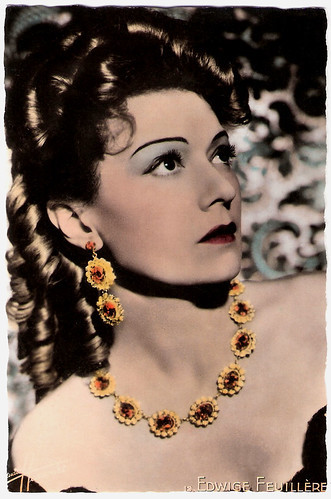
French postcard by Greff / S.E.R.P. Editeur, Paris, no. 596 A. Photo: Continental Films. Edwige Feuillère .
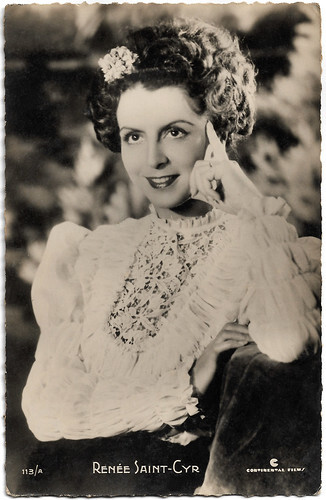
French postcard by Editions Continental, no. 113/A. Photo: Continental Films. Renée Saint-Cyr .
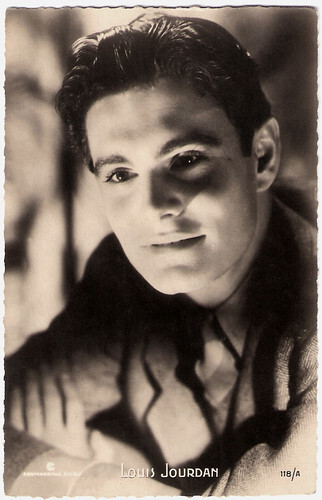
French postcard by Editions Continental, no. 118/A. Photo: Continental Films. Louis Jourdan .
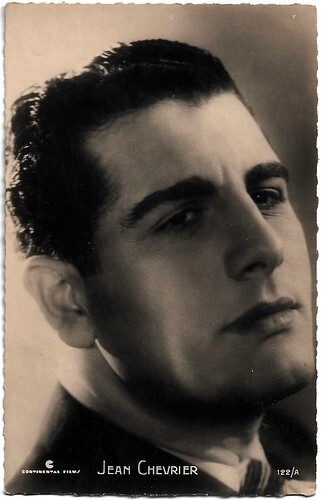
French postcard by Editions Continental, no. 122/A. Photo: Continental Films. Jean Chevrier .
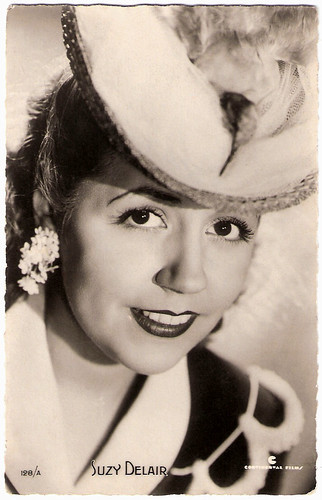
French postcard by Editions Continental, no. 128/A. Photo: Continental Films. Suzy Delair .
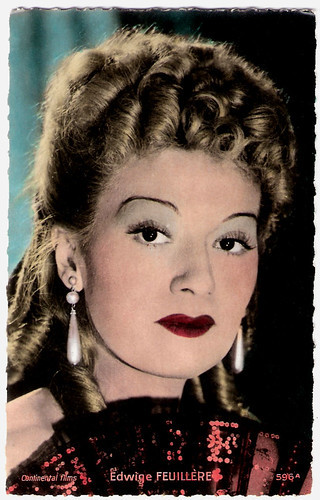
French postcard by Edit. Chantal, Rueil, no. 596 A. Photo: Continental Films. Edwige Feuillère .
Appointed by Joseph Goebbels
The order to found a German-controlled film production company in occupied France was given by Joseph Goebbels, the Minister of Propaganda of the Third Reich, in September 1940. For Goebbels, the purpose of this company was above all political, in order to keep control of film production in the occupied countries. Continental Films was established in October 1940. The Francophile Alfred Greven, who had been UFA's head of production for a short time in the spring of 1939 but was then replaced by Goebbels after only a few weeks, was appointed as director of this company.
Greven commandeered Paris studios and French screening facilities and in a short time brought the production activities of French rival companies to a virtual standstill. Goebbels wanted the Continental to produce simple, kitschy films. Alfred Greven, however, saw things differently. He was eager to promote the new company and signed on stars such as the actors Fernandel , Harry Baur , Edwige Feuillère , Pierre Fresnay , Raimu and Danielle Darrieux . Only a few directors, such as the highly respected Jean Renoir , preferred "to leave the German-occupied country as quickly as possible after Greven's offer of cooperation in order to avoid the smell of collaboration.
Continental had funds that were far greater than those of other studios at the time of the collaboration, which were facilitated by the use of excellent quality film (new and not recycled), and materials for sets and costumes that were practically impossible to find elsewhere. The Continental production included a number of high-quality productions by talented and subsequently important French directors such as Christian-Jaque, Henri-Georges Clouzot, Henri Decoin and André Cayatte. Continental's first production was L'Assassinat du père Noël/Who Killed Santa Claus? (Christian-Jaque, 1941) with Harry Baur and Raymond Rouleau . The firm gave Henri-Georges Clouzot his first directoral job for the comic thriller L'Assassin habite au 21/The Murderer Lives at Number 21 (Henri-Georges Clouzot, 1942), which Clouzot also co-wrote.
Well-positioned with French filmmakers willing to cooperate, Greven soon succeeded in producing high-quality films that also found recognition after 1945. These included Maurice Tourneur's film fantasy La Main du diable/The Devil's Hand (1942) and Clouzot's masterpiece Le Corbeau/The Raven (Henri-Georges Clouzot, 1943). However, Continental also produced a number of plain comedy films and romances from the hands of Fernandel and Richard Pottier, which was much more in line with Goebbels' intentions. A large number of these films were also shown in cinemas in the German Reich until the end of the war in 1945.
The end of Continental Films was as sudden as it was total. After Americans, British and "Free French" landed in Normandy in June 1944, the Franco-German film company ceased its work after three-quarters of a year. Two months later in August 1944, the Allies entered Paris and liberated the French capital. Continental became the nationalised Union Générale des Cinémas. By this time, Continental boss Greven had returned to the Reich. The last Continental film was the Georges Simenon adaptation Les Caves du Majestic/Majestic Hotel Cellars (Richard Pottier, 1944) with Albert Préjean in the role of Commissaire Maigret. It was ready for screening in 1944 but was not released in cinemas there until after the liberation of France.
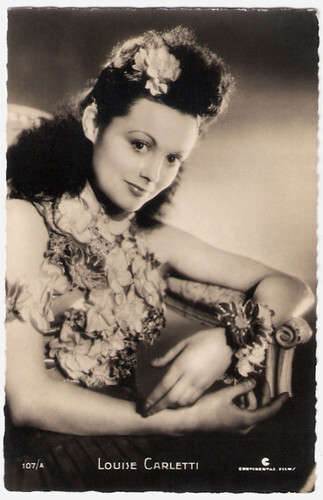
French postcard by Editions Continental, no. 107/A. Photo: Continental Films. Louise Carletti .
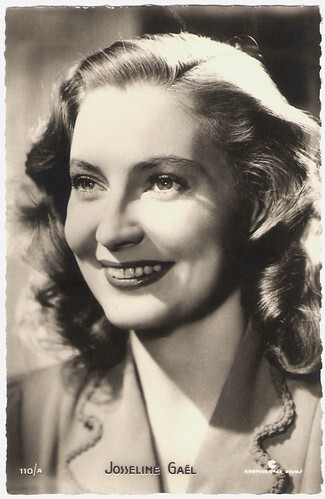
French postcard by Editions Continental, no. 110/A. Photo: Continental Films. Josseline Gael .
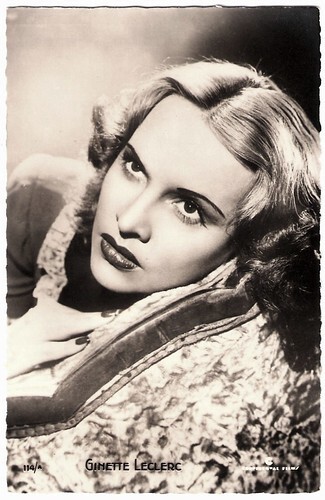
French postcard by Editions Continental, no. 114a. Photo: Continental Films. Ginette Leclerc .
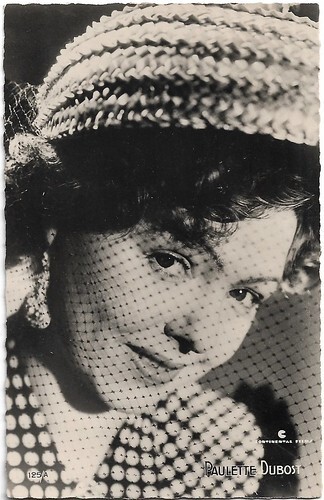
French postcard by Editions Continental, no. 125 A. Photo: Continental Films. Paulette Dubost.
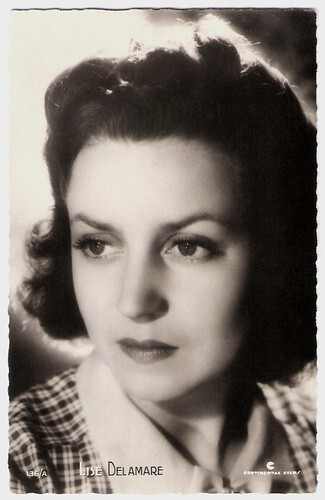
French postcard by Editions Continental, no. 136/A. Photo: Continental Films. Lise Delamare .
Alfred Greven
The director of Continental Film was the German producer Alfred Greven, who was born in 1897 in Elberfeld and died in 1973 in Cologne. After leaving the Gymnasium he volunteered in September 1914 for the German Army. He fought on the Western Front in the infantry and was severely wounded. In 1917, he fought in the Luftstreitkräfte and was awarded the Iron Cross 1st and 2nd class. After the war he started to work in the film business in 1920, joining the Nazi Party in 1931. He had studied in France and was an unconditional admirer of French culture and cinema.
In 1934, he was head of the committee for film production in the Reichsfilmkammer. Some of the films he produced were Der grüne Domino/The Green Domino (Herbert Selpin, 1935) starring Brigitte Helm , its French language version Le Domino Vert/The Green Domino (Henri Decoin, Herbert Selpin, 1935) with Danielle Darrieux , and Der Mann, der Sherlock Holmes war/Sherlock Holmes (Karl Hartl, 1937) with Hans Albers . In 1940, Goebbels appointed him managing director of the newly established Continental Film, his direct superior being Max Winkler. The sometimes high quality of Greven's production was increasingly at odds with Goebbels' film policy so that in May 1942 the head of Continental was summoned to Goebbels' ministry in Berlin: "The minister is dissatisfied with the standard of the Continental films: it is too high for him. Moreover, Greven is to produce German-language films with German actors in Paris."
Following the screening of Christian-Jaque's La Symphonie fantastique/The Fantastic Symphony (1942) with Jean-Louis Barrault , he wrote on 19 May 1942 in his diary that he was furious about Greven's company policy since he was supposedly showing the French how to ban national pride on celluloid instead of serving them with "stupid films". German film policy, Goebbels continued, must be "identical" to that of the United States vis-à-vis North and South America. "We must become the film power on the European continent". To the extent that films are produced in other countries, they should retain "a purely local character". The aim, Goebbels continued, was to prevent the creation of any national film industry "as far as possible" in German-occupied Europe.
Greven countered precisely this claim with his Continental company policy. In 1943, Continental Films produced André Cayatte's Au Bonheur des Dames based on the novel by Émile Zola, an author blacklisted by the Nazis. Greven initiated several other ambitious film adaptations of Guy de Maupassant and Honoré de Balzac. He employed the screenwriter Charles Spaak, who was arrested by the Gestapo, but also quite consciously held his protective hand over the communist, resistance fighter and Jew Jean-Paul Dreyfus, wanted by the occupying forces, the cover name 'Le Chanois'. Jean-Paul Le Chanois was the screenwriter of the Continental film La Main du diable/The Devil's Hand (Maurice Tourneur, 1942). The assistant director Jean Devaivre, in his second existence as a resistance fighter, was also employed by Continental.
With Le Corbeau/The Raven (Henri-Georges Clouzot, 1943), a bleak portrayal of a society under permanent suspicion and pressure to denounce, Continental-Films reached its artistic production peak in 1943, even though this film was immediately banned by the new French government authorities right after the liberation and the two main actors, Pierre Fresnay and Ginette Leclerc , were temporarily banned from working or even sentenced to six months in prison for alleged collaboration with the enemy. Director Clouzot only received a directing assignment again after three years of boycott and was only able to direct his first post-war film in 1947. After the war, Alfred Greven produced films in West Germany including the Catherina Valente vehicle Bonjour Kathrin (Karl Anton, 1957).
The film Laissez-passer/Safe Conduct (Bertrand Tavernier, 2002) depicts life and work at Continental, based on the memoirs of director Jean Devaivre. Greven was portrayed by Christian Berkel.
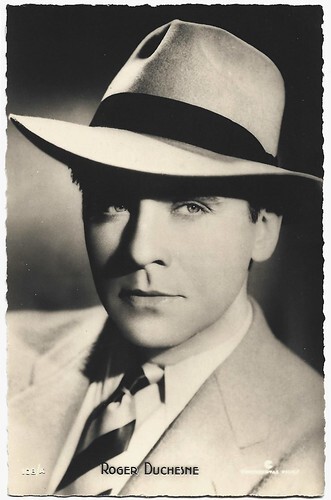
French postcard by Editions Continental, no. 108/A. Photo: Continental Films. Roger Duchesne .
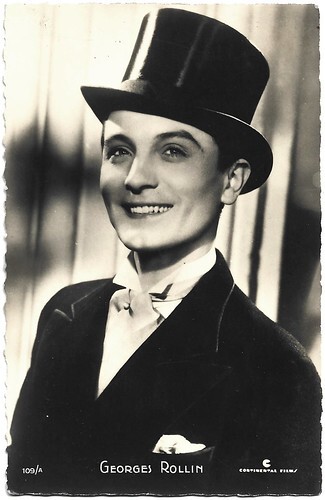
French postcard by Editions Continental, no. 109/A. Photo: Continental Films. Georges Rollin .
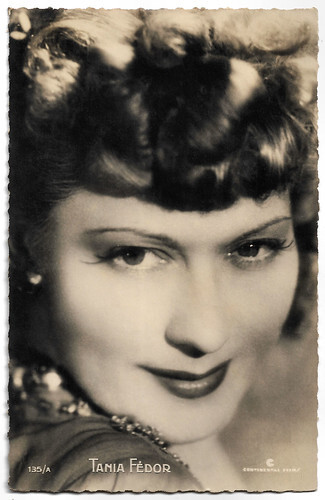
French postcard by Editions Continental, no. 135/A. Photo: Continental Films. Tania Fédor.
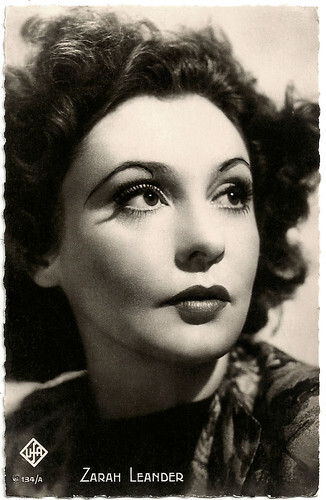
French postcard by Film-Foto Verlag, Berlin / Continental Films, Paris, no. 134/A. Photo: Ufa. Zarah Leander .
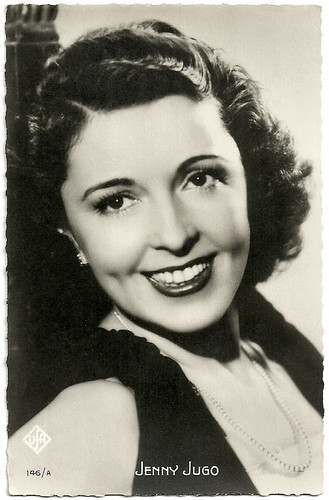
French postcard by Film-Foto Verlag, Berlin / Continental Films, Paris, no. 146/A. Photo: Ufa. Jenny Jugo .
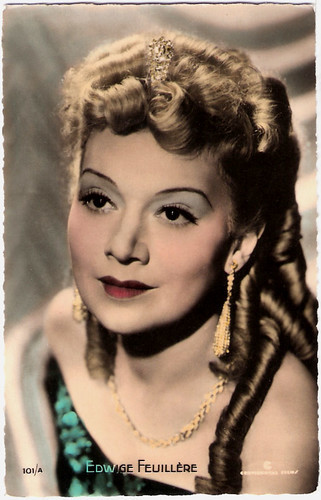
French postcard by Editions Continental, no. 101 A. Photo: Continental Films. Edwige Feuillère .
Sources: Wikipedia (French, German and English) and .

French postcard by Greff / S.E.R.P. Editeur, Paris, no. 596 A. Photo: Continental Films. Edwige Feuillère .

French postcard by Editions Continental, no. 113/A. Photo: Continental Films. Renée Saint-Cyr .

French postcard by Editions Continental, no. 118/A. Photo: Continental Films. Louis Jourdan .

French postcard by Editions Continental, no. 122/A. Photo: Continental Films. Jean Chevrier .

French postcard by Editions Continental, no. 128/A. Photo: Continental Films. Suzy Delair .

French postcard by Edit. Chantal, Rueil, no. 596 A. Photo: Continental Films. Edwige Feuillère .
Appointed by Joseph Goebbels
The order to found a German-controlled film production company in occupied France was given by Joseph Goebbels, the Minister of Propaganda of the Third Reich, in September 1940. For Goebbels, the purpose of this company was above all political, in order to keep control of film production in the occupied countries. Continental Films was established in October 1940. The Francophile Alfred Greven, who had been UFA's head of production for a short time in the spring of 1939 but was then replaced by Goebbels after only a few weeks, was appointed as director of this company.
Greven commandeered Paris studios and French screening facilities and in a short time brought the production activities of French rival companies to a virtual standstill. Goebbels wanted the Continental to produce simple, kitschy films. Alfred Greven, however, saw things differently. He was eager to promote the new company and signed on stars such as the actors Fernandel , Harry Baur , Edwige Feuillère , Pierre Fresnay , Raimu and Danielle Darrieux . Only a few directors, such as the highly respected Jean Renoir , preferred "to leave the German-occupied country as quickly as possible after Greven's offer of cooperation in order to avoid the smell of collaboration.
Continental had funds that were far greater than those of other studios at the time of the collaboration, which were facilitated by the use of excellent quality film (new and not recycled), and materials for sets and costumes that were practically impossible to find elsewhere. The Continental production included a number of high-quality productions by talented and subsequently important French directors such as Christian-Jaque, Henri-Georges Clouzot, Henri Decoin and André Cayatte. Continental's first production was L'Assassinat du père Noël/Who Killed Santa Claus? (Christian-Jaque, 1941) with Harry Baur and Raymond Rouleau . The firm gave Henri-Georges Clouzot his first directoral job for the comic thriller L'Assassin habite au 21/The Murderer Lives at Number 21 (Henri-Georges Clouzot, 1942), which Clouzot also co-wrote.
Well-positioned with French filmmakers willing to cooperate, Greven soon succeeded in producing high-quality films that also found recognition after 1945. These included Maurice Tourneur's film fantasy La Main du diable/The Devil's Hand (1942) and Clouzot's masterpiece Le Corbeau/The Raven (Henri-Georges Clouzot, 1943). However, Continental also produced a number of plain comedy films and romances from the hands of Fernandel and Richard Pottier, which was much more in line with Goebbels' intentions. A large number of these films were also shown in cinemas in the German Reich until the end of the war in 1945.
The end of Continental Films was as sudden as it was total. After Americans, British and "Free French" landed in Normandy in June 1944, the Franco-German film company ceased its work after three-quarters of a year. Two months later in August 1944, the Allies entered Paris and liberated the French capital. Continental became the nationalised Union Générale des Cinémas. By this time, Continental boss Greven had returned to the Reich. The last Continental film was the Georges Simenon adaptation Les Caves du Majestic/Majestic Hotel Cellars (Richard Pottier, 1944) with Albert Préjean in the role of Commissaire Maigret. It was ready for screening in 1944 but was not released in cinemas there until after the liberation of France.

French postcard by Editions Continental, no. 107/A. Photo: Continental Films. Louise Carletti .

French postcard by Editions Continental, no. 110/A. Photo: Continental Films. Josseline Gael .

French postcard by Editions Continental, no. 114a. Photo: Continental Films. Ginette Leclerc .

French postcard by Editions Continental, no. 125 A. Photo: Continental Films. Paulette Dubost.

French postcard by Editions Continental, no. 136/A. Photo: Continental Films. Lise Delamare .
Alfred Greven
The director of Continental Film was the German producer Alfred Greven, who was born in 1897 in Elberfeld and died in 1973 in Cologne. After leaving the Gymnasium he volunteered in September 1914 for the German Army. He fought on the Western Front in the infantry and was severely wounded. In 1917, he fought in the Luftstreitkräfte and was awarded the Iron Cross 1st and 2nd class. After the war he started to work in the film business in 1920, joining the Nazi Party in 1931. He had studied in France and was an unconditional admirer of French culture and cinema.
In 1934, he was head of the committee for film production in the Reichsfilmkammer. Some of the films he produced were Der grüne Domino/The Green Domino (Herbert Selpin, 1935) starring Brigitte Helm , its French language version Le Domino Vert/The Green Domino (Henri Decoin, Herbert Selpin, 1935) with Danielle Darrieux , and Der Mann, der Sherlock Holmes war/Sherlock Holmes (Karl Hartl, 1937) with Hans Albers . In 1940, Goebbels appointed him managing director of the newly established Continental Film, his direct superior being Max Winkler. The sometimes high quality of Greven's production was increasingly at odds with Goebbels' film policy so that in May 1942 the head of Continental was summoned to Goebbels' ministry in Berlin: "The minister is dissatisfied with the standard of the Continental films: it is too high for him. Moreover, Greven is to produce German-language films with German actors in Paris."
Following the screening of Christian-Jaque's La Symphonie fantastique/The Fantastic Symphony (1942) with Jean-Louis Barrault , he wrote on 19 May 1942 in his diary that he was furious about Greven's company policy since he was supposedly showing the French how to ban national pride on celluloid instead of serving them with "stupid films". German film policy, Goebbels continued, must be "identical" to that of the United States vis-à-vis North and South America. "We must become the film power on the European continent". To the extent that films are produced in other countries, they should retain "a purely local character". The aim, Goebbels continued, was to prevent the creation of any national film industry "as far as possible" in German-occupied Europe.
Greven countered precisely this claim with his Continental company policy. In 1943, Continental Films produced André Cayatte's Au Bonheur des Dames based on the novel by Émile Zola, an author blacklisted by the Nazis. Greven initiated several other ambitious film adaptations of Guy de Maupassant and Honoré de Balzac. He employed the screenwriter Charles Spaak, who was arrested by the Gestapo, but also quite consciously held his protective hand over the communist, resistance fighter and Jew Jean-Paul Dreyfus, wanted by the occupying forces, the cover name 'Le Chanois'. Jean-Paul Le Chanois was the screenwriter of the Continental film La Main du diable/The Devil's Hand (Maurice Tourneur, 1942). The assistant director Jean Devaivre, in his second existence as a resistance fighter, was also employed by Continental.
With Le Corbeau/The Raven (Henri-Georges Clouzot, 1943), a bleak portrayal of a society under permanent suspicion and pressure to denounce, Continental-Films reached its artistic production peak in 1943, even though this film was immediately banned by the new French government authorities right after the liberation and the two main actors, Pierre Fresnay and Ginette Leclerc , were temporarily banned from working or even sentenced to six months in prison for alleged collaboration with the enemy. Director Clouzot only received a directing assignment again after three years of boycott and was only able to direct his first post-war film in 1947. After the war, Alfred Greven produced films in West Germany including the Catherina Valente vehicle Bonjour Kathrin (Karl Anton, 1957).
The film Laissez-passer/Safe Conduct (Bertrand Tavernier, 2002) depicts life and work at Continental, based on the memoirs of director Jean Devaivre. Greven was portrayed by Christian Berkel.

French postcard by Editions Continental, no. 108/A. Photo: Continental Films. Roger Duchesne .

French postcard by Editions Continental, no. 109/A. Photo: Continental Films. Georges Rollin .

French postcard by Editions Continental, no. 135/A. Photo: Continental Films. Tania Fédor.

French postcard by Film-Foto Verlag, Berlin / Continental Films, Paris, no. 134/A. Photo: Ufa. Zarah Leander .

French postcard by Film-Foto Verlag, Berlin / Continental Films, Paris, no. 146/A. Photo: Ufa. Jenny Jugo .

French postcard by Editions Continental, no. 101 A. Photo: Continental Films. Edwige Feuillère .
Sources: Wikipedia (French, German and English) and .
Published on June 18, 2023 22:00
June 17, 2023
José Campos
Spanish actor and writer José Campos (1936-2010) was promoted as the Spanish James Dean. He was known for such films as La cripta e l'incubo/Crypt of the Vampire (1964), the historical TV series Diego de Acevedo (1966) and Vivir a mil/Living at a thousand (1976), which he also directed. Despite the high expectations at the start of his career, his films were of very little importance.

Spanish postcard by Raker, no. 1010.

Spanish postcard by Raker, no. 1084.
One of the most spectacular publicity campaigns in the history of Spanish cinema
José Campos was born José Antonio Campos Boloix in 1936 in Granada, Andalucia. He studied acting at the I.I.E.C., and then made his film debut, benefiting from a certain physical resemblance to the then-recently deceased James Dean .
He was given one of the most spectacular publicity campaigns in the history of Spanish cinema. For his first film, Llama un tal Esteban (Pedro L. Ramírez, 1959), the publicity read: "José Campos is a true star of today's cinema, who will mark an epoch and define a school of acting in world cinema".
However, the professional career of José Campos in no way corresponded to such optimistic perspectives. He developed his film activity mainly in Barcelona in films produced by Ignacio F. Iquino or the brothers Alfonso Balcázar and Jaime Jesús Balcázar.
In the early 1960s, he starred in such Spanish light entertainment films as Solteros de verano/Summer bachelors (Alfonso Balcázar, 1962) and Los castigadores/The punishers (Alfonso Balcázar, 1962).
Campos played a juvenile delinquent in Los desamparados/The Homeless (Antonio Santillán, 1962). He co-starred with Rafael Bardem in La alternativa/The alternative (José María Nunes, 1963). For this film, he also wrote the story.

Spanish postcard by Ediciones Raker, Barcelona, no. 26. José Campos in Solteros de verano/Summer bachelors (Alfonso Balcázar, 1962).
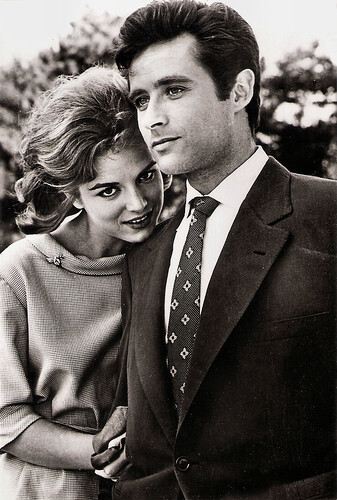
Spanish postcard by Ediciones Raker, Barcelona, no. 299. José Campos in Solteros de verano/Summer bachelors (Alfonso Balcázar, 1962).
A scary and ghastly film with a lot of thrills, chills, and ominous bloodsuckers
In Italy, José Campos appeared in the horror film La cripta e l'incubo/Crypt of the Vampire (Camillo Mastrocinque, 1964) starring Christopher Lee . Though only superficially faithful to Joseph Sheridan Le Fanu's famous novella, 'Carmilla', the film was praised for its consistent visual distinction and unity of mood.
Ma Cortes at IMDb : "A scary and ghastly film with a lot of thrills, chills, and ominous bloodsuckers. Interesting screenplay full of twists and turns."
He appeared in an episode of the popular historical series Diego de Acevedo (Ricardo Blasco, 1966) about Spain during the 19th century. He also appeared in the crime films Yo no soy un asesino/I am not a murderer (José María Zabalza, 1968) and Homicidios en Chicago/Homicides in Chicago (José María Zabalza, 1969).
After a long interval, José Campos returned to the screen with Vivir a mil/Living at a thousand (1976), which he both wrote and directed and which starred his son, Juan Carlos Campos. He then acted in the Spanish comedy Visanteta, estáte quieta/Visanteta, be quiet (Vicente Escrivá, 1979) starring Maria Rosaria Omaggio. He only played a supporting part, credited as Josep Campos.
He had an even smaller, uncredited part in the sex comedy Consultorio sexológico/Sex Clinic (José Antonio Villalba, 1980). His final film was the thriller El enigma del yate/The enigma of the yacht (Carlos Aured, 1983). José Campos died in 2010 in Madrid, Spain. He was 76. His daughter is Marie Cozannet, who also works in the film industry.
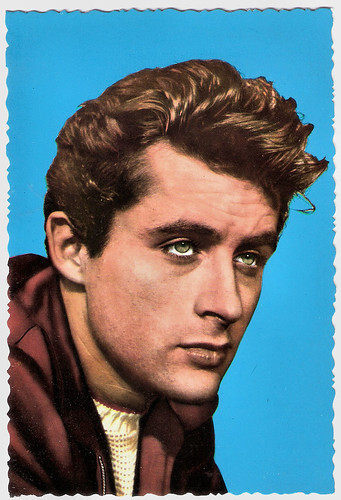
Spanish postcard by Ediciones Raker, Barcelona, no. 1032.
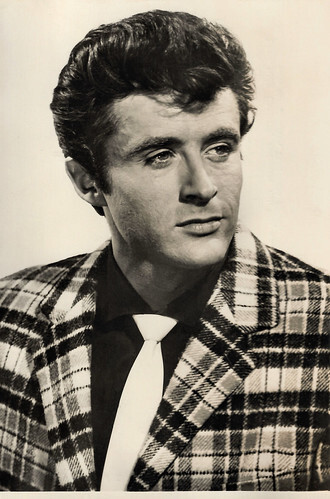
Spanish postcard by Ediciones Raker, Barcelona, no. 282. José Campos in Los castigadores/The punishers (Alfonso Balcázar, 1962).
Sources: Ma Cortes (IMDb), Enciclopedia del Cine Español (Spanish), Film Affinity and .

Spanish postcard by Raker, no. 1010.

Spanish postcard by Raker, no. 1084.
One of the most spectacular publicity campaigns in the history of Spanish cinema
José Campos was born José Antonio Campos Boloix in 1936 in Granada, Andalucia. He studied acting at the I.I.E.C., and then made his film debut, benefiting from a certain physical resemblance to the then-recently deceased James Dean .
He was given one of the most spectacular publicity campaigns in the history of Spanish cinema. For his first film, Llama un tal Esteban (Pedro L. Ramírez, 1959), the publicity read: "José Campos is a true star of today's cinema, who will mark an epoch and define a school of acting in world cinema".
However, the professional career of José Campos in no way corresponded to such optimistic perspectives. He developed his film activity mainly in Barcelona in films produced by Ignacio F. Iquino or the brothers Alfonso Balcázar and Jaime Jesús Balcázar.
In the early 1960s, he starred in such Spanish light entertainment films as Solteros de verano/Summer bachelors (Alfonso Balcázar, 1962) and Los castigadores/The punishers (Alfonso Balcázar, 1962).
Campos played a juvenile delinquent in Los desamparados/The Homeless (Antonio Santillán, 1962). He co-starred with Rafael Bardem in La alternativa/The alternative (José María Nunes, 1963). For this film, he also wrote the story.

Spanish postcard by Ediciones Raker, Barcelona, no. 26. José Campos in Solteros de verano/Summer bachelors (Alfonso Balcázar, 1962).

Spanish postcard by Ediciones Raker, Barcelona, no. 299. José Campos in Solteros de verano/Summer bachelors (Alfonso Balcázar, 1962).
A scary and ghastly film with a lot of thrills, chills, and ominous bloodsuckers
In Italy, José Campos appeared in the horror film La cripta e l'incubo/Crypt of the Vampire (Camillo Mastrocinque, 1964) starring Christopher Lee . Though only superficially faithful to Joseph Sheridan Le Fanu's famous novella, 'Carmilla', the film was praised for its consistent visual distinction and unity of mood.
Ma Cortes at IMDb : "A scary and ghastly film with a lot of thrills, chills, and ominous bloodsuckers. Interesting screenplay full of twists and turns."
He appeared in an episode of the popular historical series Diego de Acevedo (Ricardo Blasco, 1966) about Spain during the 19th century. He also appeared in the crime films Yo no soy un asesino/I am not a murderer (José María Zabalza, 1968) and Homicidios en Chicago/Homicides in Chicago (José María Zabalza, 1969).
After a long interval, José Campos returned to the screen with Vivir a mil/Living at a thousand (1976), which he both wrote and directed and which starred his son, Juan Carlos Campos. He then acted in the Spanish comedy Visanteta, estáte quieta/Visanteta, be quiet (Vicente Escrivá, 1979) starring Maria Rosaria Omaggio. He only played a supporting part, credited as Josep Campos.
He had an even smaller, uncredited part in the sex comedy Consultorio sexológico/Sex Clinic (José Antonio Villalba, 1980). His final film was the thriller El enigma del yate/The enigma of the yacht (Carlos Aured, 1983). José Campos died in 2010 in Madrid, Spain. He was 76. His daughter is Marie Cozannet, who also works in the film industry.

Spanish postcard by Ediciones Raker, Barcelona, no. 1032.

Spanish postcard by Ediciones Raker, Barcelona, no. 282. José Campos in Los castigadores/The punishers (Alfonso Balcázar, 1962).
Sources: Ma Cortes (IMDb), Enciclopedia del Cine Español (Spanish), Film Affinity and .
Published on June 17, 2023 22:00
June 16, 2023
Janet Leigh
American actress Janet Leigh (1927-2004) starred in more than 50 films, but will always be remembered for the 45 minutes that she was on the screen in Alfred Hitchcock's Psycho (1960). Her shower scene became a film landmark. She was nominated for an Oscar and received a Golden Globe. Also unforgettable are her roles in Orson Welles' Touch of Evil (1958) and The Manchurian Candidate (1962), in which she starred with Frank Sinatra. Leigh and Tony Curtis were married from 1951 to 1962.
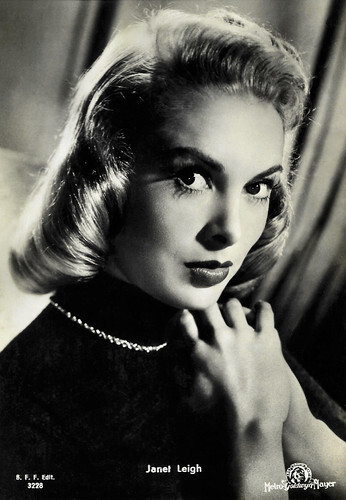
Italian postcard by B.F.F. Edit., no. 3228. Photo: Metro Goldwyn Mayer. Janet Leigh in Rogue Cop (Roy Rowland, 1954).
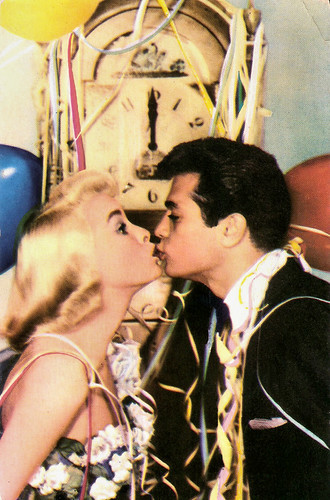
Spanish postcard by Archivo Bermejo, no. C 44. Photo: Universal International. With Tony Curtis .
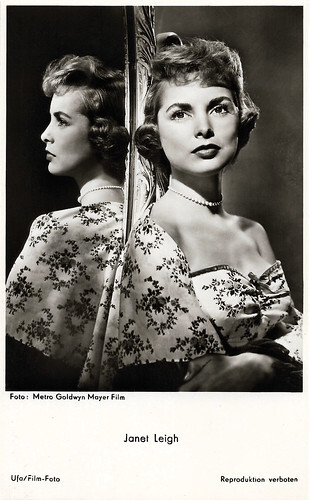
West-German postcard by Ufa/Film-Foto, Berlin-Tempelhof, no. FK-917. Photo: Metro-Goldwyn-Mayer. Janet Leigh in The Naked Spur (Anthony Mann, 1953). The German title is Nackte Gewalt.
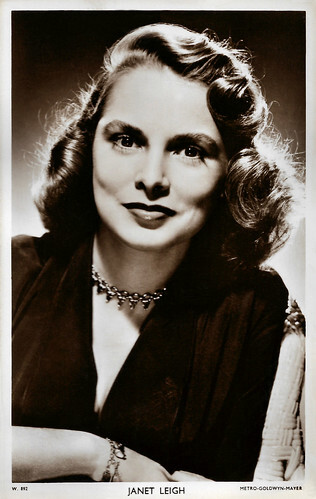
British postcard in the Picturegoer Series, London, no. W. 892. Photo: Metro-Goldwyn-Mayer.
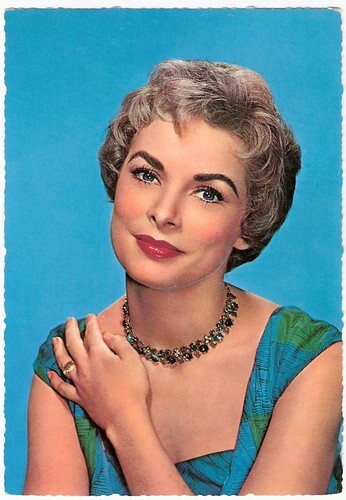
West German postcard by Krüger, no. 902/2.
The local cinema as a babysitter
Janet Leigh was born Jeanette Helen Morrison in 1927 as the only child of a very young married couple, Helen Lita (née Westergaard) and Frederick Morrison in Merced, California. She spent her childhood moving from town to town due to her father's changing jobs. A bright child who skipped several grades in school, Leigh took music and dancing lessons, making her public debut at age 10 as a baton twirler for a marching band.
Her favourite times were the afternoons spent at the local cinema, which she called her "babysitter." After high school, she studied music and psychology at the College of the Pacific in Stockton. In the winter of 1945, she stayed at Sugar Bowl, a ski resort in the Sierra Nevada mountains, with her parents.
Leigh's mother was working at a ski lodge where actress Norma Shearer was vacationing. Shearer was impressed by a photograph of then-eighteen-year-old Leigh taken by the ski club photographer over the Christmas holiday. Shearer brought Leigh to the attention of MGM talent agent Lew Wasserman who offered the girl a contract. Leigh left the College of the Pacific to take acting lessons from Lillian Burns. Her prior acting experience consisted only of a college play.
One year later Leigh was at MGM, playing the ingenue in the film Romance of Rosy Ridge (Roy Rowland, 1947), a big-screen romance in which she starred opposite veteran Hollywood actor Van Johnson. The studio changed her name to Janet Leigh. The Romance of Rosy Ridge was a box-office success and the same year Leigh was cast for the film If Winter Comes (Victor Saville, 1947) with Walter Pidgeon and Deborah Kerr .
The young actress became one of the busiest contractees at the studio, building her following with solid performances in such films as Little Women (Mervyn LeRoy, 1949), The Doctor and the Girl (Curtis Bernhardt, 1950) as Glenn Ford 's love interest, and the Swashbuckler Scaramouche (George Sidney, 1952), starring Stewart Granger .
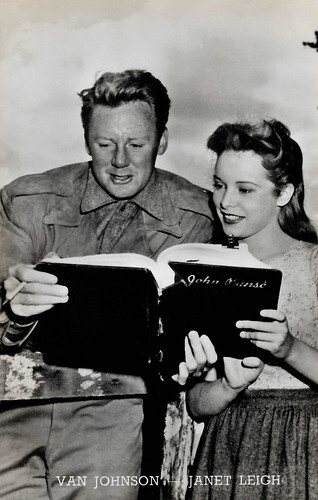
Belgian postcard, no. 61. Photo: M.G.M. Van Johnson and Janet Leigh on the set of The Romance of Rosy Ridge (Roy Rowland, 1947).
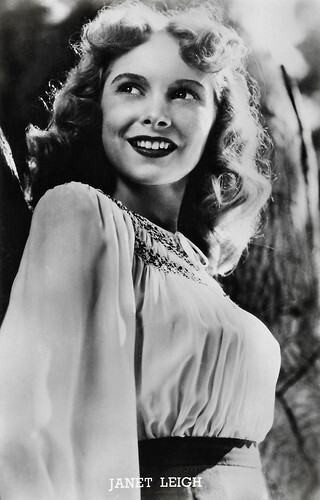
Dutch postcard by Van Leer's Fotodrukindustrie N.V., Amsterdam, no. 3541. Photo: Metro Goldwyn Mayer.
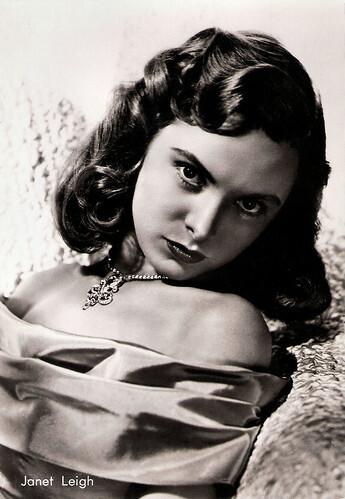
Italian postcard by Bromostampa, Milano, no. 91.
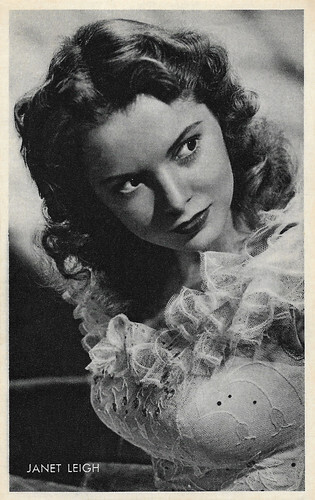
Belgian collectors card by Kwatta, Bois -d'Haine, no. C. 121 (in the series C. 99 - 196). Photo: Metro-Goldwyn-Mayer.
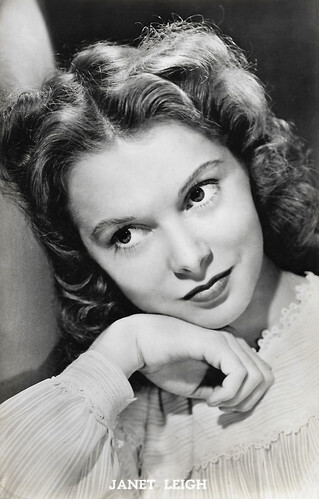
Belgian postcard, no. 850. Photo: Metro-Goldwyn-Mayer.
The darlings of fan magazines and columnists
Janet Leigh caught the eye of RKO Radio's owner Howard Hughes, who hoped that her several RKO appearances on loan from MGM would lead to something substantial in private life. Instead, Leigh married Tony Curtis who became her third husband at 25.
During her final year of high school, Leigh married eighteen-year-old John Kenneth Carlisle in Reno in 1942. The marriage was annulled five months later. Her second marriage to Stanley Reames (1946-1948) lasted two years.
Curtis and Leigh became the darlings of fan magazines and columnists, as well as occasional co-stars in such films as Houdini (George Marshall, 1953), The Black Shield of Falworth (Rudolph Maté, 1954), and The Vikings (Richard Fleischer, 1958) with Kirk Douglas .
Even as this 'perfect' Hollywood marriage deteriorated in the late 1950s, Leigh's career prospered. In the Film Noir Touch of Evil (Orson Welles, 1958), she starred opposite Charlton Heston and Orson Welles. Among her significant roles in the 1960s were that of Frank Sinatra 's enigmatic lady friend in The Manchurian Candidate (John Frankenheimer, 1962), and Paul Newman 's ex-wife in the mystery Harper (Jack Smight, 1966).
Hal Erickson at AllMovie : "And, of course, the unfortunate embezzler in Alfred Hitchcock 's Psycho (1960), who met her demise in the nude (actually covered by a moleskin) and covered with blood (actually chocolate sauce, which photographed better) in the legendary 'shower scene'." The part of Marion Crane would become her most famous role and she received an Oscar nomination and a Golden Globe for it.
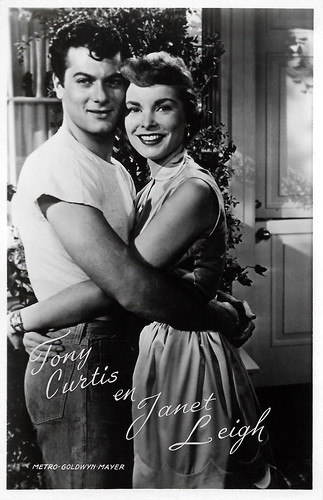
Swedish postcard by Förlag Torsten G. Ericsson, Hälsingborg, no. AX 865. Photo: Metro-Goldwyn-Mayer.
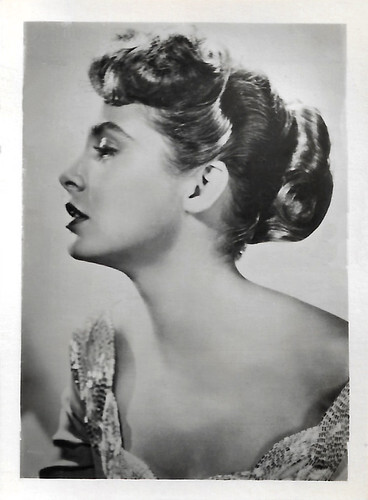
Small German collectors card in the 'Film Stars der Welt ' series by Greiling-Sammelbilder, series E, no. 152. Photo: RKO.
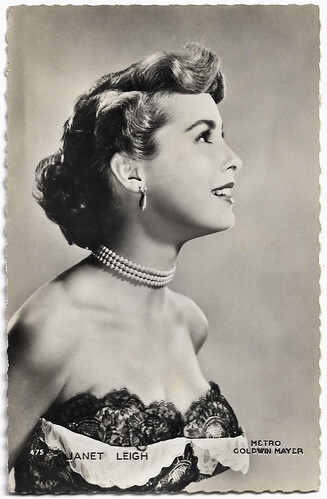
French postcard by Editions P.I., Paris, no. 475. Photo: Metro Goldwyn Mayer, 1954.
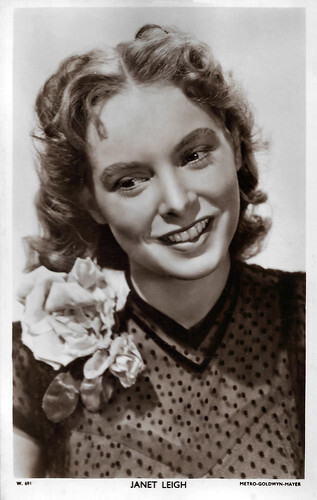
British postcard in the Picturegoer Series, London, no. W. 691. Photo: Metro-Goldwyn-Mayer.
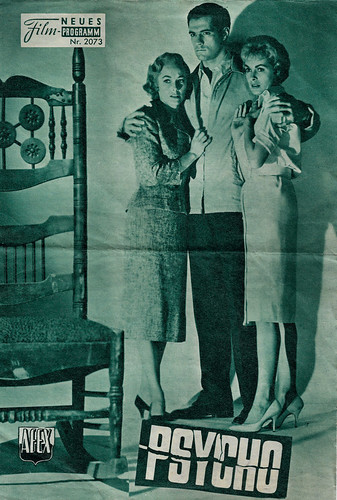
Austrian flyer (front) by Neues Film-programm, no. 2073, October 1960. Photo: Afex. Vera Miles, John Gavin and Janet Leigh in Psycho (Alfred Hitchcock, 1960).
The Mother of Jaimie Lee
Meanwhile, Janet Leigh had become the mother of two daughters, Kelly (1956) and Jamie-Lee (1958), and divorced Tony Curtis in 1962. In the same year, she remarried stockbroker Robert Brandt, with whom she would remain for the next 42 years. In order to spend more time with her family, Leigh began to put her career on hold.
She mainly played roles in television productions such as Bob Hope Presents the Chrysler Theatre (1964-1966), The Red Skelton Show (1969), and Tales of the Unexpected (1982-1984). Notable were her appearances in the feature-length television film The House on Greenapple Road (Robert Day, 1970) and her role as a forgotten film actress in Forgotten Lady (1975), an episode of the series Columbo.
She made her Broadway debut in 1975 in a production of 'Murder Among Friends'. In the cinema, she starred in the supernatural horror film The Fog (John Carpenter, 1980) with her daughter Jamie Lee Curtis. In the 1980s, Leigh curtailed her film and TV appearances. However, her extended legacy as both the star/victim of Psycho and the mother of actress Jamie Lee Curtis still found her a notable place in the world of cinema even if her career was no longer "officially" active.
She co-starred with Jamie Lee again in the slasher Halloween H20: 20 Years Later (Steve Miner, 1998). Leigh wrote an autobiography 'There Really Was a Hollywood' (1984), and a non-fiction 'Psycho: Behind the Scenes of the Classic Thriller' (1995, co-authored with Christopher Nickens), as well as two novels 'House of Destiny' (1996) and 'The Dream Factory' (2002).
Janet Leigh died of vasculitis, an inflammation of the blood vessels, in 2004, at home in Beverly Hills in the presence of her family. She was 77. Leigh was cremated and her ashes were entombed at Westwood Village Memorial Park Cemetery in the Westwood Village neighbourhood of Los Angeles.

Italian postcard by S.A. Poligrafica Sammarinese, no. 002-d.
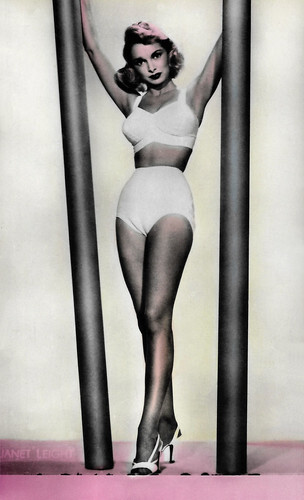
Yugoslavian postcard by Studio Sombor.
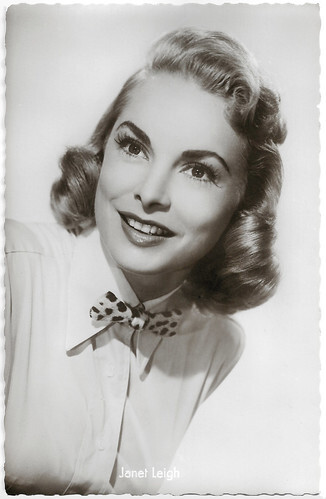
West-German postcard by Kolibri-Verlag G.m.b.H., Minden/Westf., no. 597.
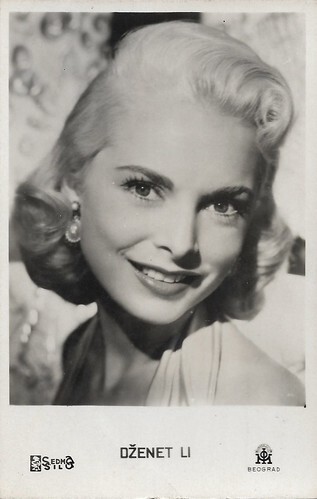
Former Yugoslavian (now Serbian) postcard by Sedma Sila / Morava Film, Beograd (Belgrade).

Dutch postcard by DRC, no. F 209. Photo: Metro-Goldwyn-Mayer.
Sources: Hal Erickson (AllMovie), Wikipedia (English and Dutch) and .

Italian postcard by B.F.F. Edit., no. 3228. Photo: Metro Goldwyn Mayer. Janet Leigh in Rogue Cop (Roy Rowland, 1954).

Spanish postcard by Archivo Bermejo, no. C 44. Photo: Universal International. With Tony Curtis .

West-German postcard by Ufa/Film-Foto, Berlin-Tempelhof, no. FK-917. Photo: Metro-Goldwyn-Mayer. Janet Leigh in The Naked Spur (Anthony Mann, 1953). The German title is Nackte Gewalt.

British postcard in the Picturegoer Series, London, no. W. 892. Photo: Metro-Goldwyn-Mayer.

West German postcard by Krüger, no. 902/2.
The local cinema as a babysitter
Janet Leigh was born Jeanette Helen Morrison in 1927 as the only child of a very young married couple, Helen Lita (née Westergaard) and Frederick Morrison in Merced, California. She spent her childhood moving from town to town due to her father's changing jobs. A bright child who skipped several grades in school, Leigh took music and dancing lessons, making her public debut at age 10 as a baton twirler for a marching band.
Her favourite times were the afternoons spent at the local cinema, which she called her "babysitter." After high school, she studied music and psychology at the College of the Pacific in Stockton. In the winter of 1945, she stayed at Sugar Bowl, a ski resort in the Sierra Nevada mountains, with her parents.
Leigh's mother was working at a ski lodge where actress Norma Shearer was vacationing. Shearer was impressed by a photograph of then-eighteen-year-old Leigh taken by the ski club photographer over the Christmas holiday. Shearer brought Leigh to the attention of MGM talent agent Lew Wasserman who offered the girl a contract. Leigh left the College of the Pacific to take acting lessons from Lillian Burns. Her prior acting experience consisted only of a college play.
One year later Leigh was at MGM, playing the ingenue in the film Romance of Rosy Ridge (Roy Rowland, 1947), a big-screen romance in which she starred opposite veteran Hollywood actor Van Johnson. The studio changed her name to Janet Leigh. The Romance of Rosy Ridge was a box-office success and the same year Leigh was cast for the film If Winter Comes (Victor Saville, 1947) with Walter Pidgeon and Deborah Kerr .
The young actress became one of the busiest contractees at the studio, building her following with solid performances in such films as Little Women (Mervyn LeRoy, 1949), The Doctor and the Girl (Curtis Bernhardt, 1950) as Glenn Ford 's love interest, and the Swashbuckler Scaramouche (George Sidney, 1952), starring Stewart Granger .

Belgian postcard, no. 61. Photo: M.G.M. Van Johnson and Janet Leigh on the set of The Romance of Rosy Ridge (Roy Rowland, 1947).

Dutch postcard by Van Leer's Fotodrukindustrie N.V., Amsterdam, no. 3541. Photo: Metro Goldwyn Mayer.

Italian postcard by Bromostampa, Milano, no. 91.

Belgian collectors card by Kwatta, Bois -d'Haine, no. C. 121 (in the series C. 99 - 196). Photo: Metro-Goldwyn-Mayer.

Belgian postcard, no. 850. Photo: Metro-Goldwyn-Mayer.
The darlings of fan magazines and columnists
Janet Leigh caught the eye of RKO Radio's owner Howard Hughes, who hoped that her several RKO appearances on loan from MGM would lead to something substantial in private life. Instead, Leigh married Tony Curtis who became her third husband at 25.
During her final year of high school, Leigh married eighteen-year-old John Kenneth Carlisle in Reno in 1942. The marriage was annulled five months later. Her second marriage to Stanley Reames (1946-1948) lasted two years.
Curtis and Leigh became the darlings of fan magazines and columnists, as well as occasional co-stars in such films as Houdini (George Marshall, 1953), The Black Shield of Falworth (Rudolph Maté, 1954), and The Vikings (Richard Fleischer, 1958) with Kirk Douglas .
Even as this 'perfect' Hollywood marriage deteriorated in the late 1950s, Leigh's career prospered. In the Film Noir Touch of Evil (Orson Welles, 1958), she starred opposite Charlton Heston and Orson Welles. Among her significant roles in the 1960s were that of Frank Sinatra 's enigmatic lady friend in The Manchurian Candidate (John Frankenheimer, 1962), and Paul Newman 's ex-wife in the mystery Harper (Jack Smight, 1966).
Hal Erickson at AllMovie : "And, of course, the unfortunate embezzler in Alfred Hitchcock 's Psycho (1960), who met her demise in the nude (actually covered by a moleskin) and covered with blood (actually chocolate sauce, which photographed better) in the legendary 'shower scene'." The part of Marion Crane would become her most famous role and she received an Oscar nomination and a Golden Globe for it.

Swedish postcard by Förlag Torsten G. Ericsson, Hälsingborg, no. AX 865. Photo: Metro-Goldwyn-Mayer.

Small German collectors card in the 'Film Stars der Welt ' series by Greiling-Sammelbilder, series E, no. 152. Photo: RKO.

French postcard by Editions P.I., Paris, no. 475. Photo: Metro Goldwyn Mayer, 1954.

British postcard in the Picturegoer Series, London, no. W. 691. Photo: Metro-Goldwyn-Mayer.

Austrian flyer (front) by Neues Film-programm, no. 2073, October 1960. Photo: Afex. Vera Miles, John Gavin and Janet Leigh in Psycho (Alfred Hitchcock, 1960).
The Mother of Jaimie Lee
Meanwhile, Janet Leigh had become the mother of two daughters, Kelly (1956) and Jamie-Lee (1958), and divorced Tony Curtis in 1962. In the same year, she remarried stockbroker Robert Brandt, with whom she would remain for the next 42 years. In order to spend more time with her family, Leigh began to put her career on hold.
She mainly played roles in television productions such as Bob Hope Presents the Chrysler Theatre (1964-1966), The Red Skelton Show (1969), and Tales of the Unexpected (1982-1984). Notable were her appearances in the feature-length television film The House on Greenapple Road (Robert Day, 1970) and her role as a forgotten film actress in Forgotten Lady (1975), an episode of the series Columbo.
She made her Broadway debut in 1975 in a production of 'Murder Among Friends'. In the cinema, she starred in the supernatural horror film The Fog (John Carpenter, 1980) with her daughter Jamie Lee Curtis. In the 1980s, Leigh curtailed her film and TV appearances. However, her extended legacy as both the star/victim of Psycho and the mother of actress Jamie Lee Curtis still found her a notable place in the world of cinema even if her career was no longer "officially" active.
She co-starred with Jamie Lee again in the slasher Halloween H20: 20 Years Later (Steve Miner, 1998). Leigh wrote an autobiography 'There Really Was a Hollywood' (1984), and a non-fiction 'Psycho: Behind the Scenes of the Classic Thriller' (1995, co-authored with Christopher Nickens), as well as two novels 'House of Destiny' (1996) and 'The Dream Factory' (2002).
Janet Leigh died of vasculitis, an inflammation of the blood vessels, in 2004, at home in Beverly Hills in the presence of her family. She was 77. Leigh was cremated and her ashes were entombed at Westwood Village Memorial Park Cemetery in the Westwood Village neighbourhood of Los Angeles.

Italian postcard by S.A. Poligrafica Sammarinese, no. 002-d.

Yugoslavian postcard by Studio Sombor.

West-German postcard by Kolibri-Verlag G.m.b.H., Minden/Westf., no. 597.

Former Yugoslavian (now Serbian) postcard by Sedma Sila / Morava Film, Beograd (Belgrade).

Dutch postcard by DRC, no. F 209. Photo: Metro-Goldwyn-Mayer.
Sources: Hal Erickson (AllMovie), Wikipedia (English and Dutch) and .
Published on June 16, 2023 22:00
June 15, 2023
Glenda Jackson
Yesterday, 15 June 2023, British actress and politician Glenda Jackson (1936) passed away. She was one of the leading British actresses of the 1960s and 1970s. As a major film star, she won many awards, including two Oscars for Best Actress for Women in Love (1969) and A Touch of Class (1973).

British postcard for A British Film Year exhibition by Raithby, Lawrence & Company Ltd, Leicester and London. Photo: Terry O'Neill. Glenda Jackson on the set of Mary Queen of Scots (Charles Jarrott, 1971).

Romanian postcard by Casa Filmului Acin, no. 43078.
Blazing intelligence, sexual challenge and abrasiveness
Glenda May Jackson was born in Birkenhead on the Wirral, England, in 1936. Her father was a bricklayer. Jackson was educated at the West Kirby County Grammar School for Girls. She graduated from school at 16 and worked for two years in a Boots chemist shop. However, she found this boring and dead-end. She wanted better for herself.
Her life changed forever when she was accepted into the prestigious Royal Academy of Dramatic Art (RADA) at 18. Her work impressed all who observed it. Jackson made her professional stage debut in Terence Rattigan's 'Separate Tables' in 1957. She was a member of the Dundee Repertory Company in the early 1960s alongside Edward Fox, Michael Culver and Nicol Williamson. She made her film debut as a singer at a party in the British New Wave drama This Sporting Life ( Lindsay Anderson, 1963), starring Richard Harris. After ten years of scraping by, she was invited to join the Theatre of Cruelty, an offshoot of the Royal Shakespeare Company.
She was cast as Charlotte Corday in Peter Brook's internationally award-winning The Persecution and Assassination of Jean-Paul Marat as Performed by the Inmates of the Asylum of Charenton Under the Direction of the Marquis De Sade (aka Marat/Sade), written by Peter Weiss. For this part, she was nominated for a Tony Award as Best Supporting or Featured Actress (Dramatic). Jackson also appeared in the controversial film version, Marat/Sade (Peter Brook, 1967), featuring Patrick Magee. According to the anonymous biographer at IMDb , Jackson “is acknowledged to have stolen the show”. Her first starring film role came in the offbeat drama Negatives (Peter Medak, 1968).
It was followed by a starring role in the 1920s romance Women in Love (Ken Russell, 1969), based on a scandalous novel by D.H. Lawrence. For her role opposite Alan Bates, she won her first Academy Award for Best Actress. In the Encyclopedia of British Film, Brian McFarlane said, “Her blazing intelligence, sexual challenge and abrasiveness were at the service of a superbly written role in a film with a passion rare in the annals of British cinema.”
Another controversial role followed as Tchaikovsky's (Richard Chamberlain) nymphomaniac wife in The Music Lovers (Ken Russell, 1970). Both roles added to her image of being prepared to do almost anything for her art. She worked again with Russell on the musical comedy The Boy Friend (Ken Russell, 1971), although her part was only an uncredited cameo.
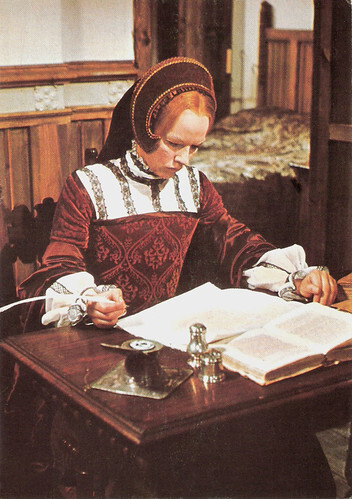
British postcard by British Broadcasting Corporation, no. 1, 1971. Photo: Glenda Jackson as Elizabeth I in the BBC TV series Elizabeth R (1971).
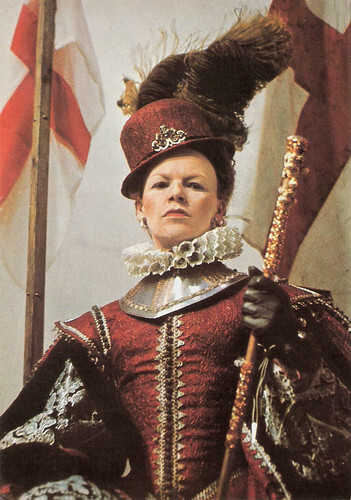
British postcard by British Broadcasting Corporation, no. 6, 1971. Photo: Glenda Jackson as Elizabeth I in the BBC TV series Elizabeth R (1971).
Controversial reputation
In the early 1970s, Glenda Jackson was much in demand. In Sunday Bloody Sunday (John Schlesinger, 1971), she played a divorced businesswoman in a dead-end affair with a shallow bisexual artist (Murray Head). The film turned out to be another major success. She won the BAFTA Award for Best Actress in a Leading Role and was again nominated for the Academy Award.
She confirmed her controversial reputation by having her head shaved in order to play Queen Elizabeth I of England in the BBC's blockbuster serial, Elizabeth R (1971). Jackson received two Emmy Awards for her work. She also portrayed Queen Elizabeth in the film Mary, Queen of Scots (Charles Jarrott, 1971) opposite Vanessa Redgrave . For this role, she won David di Donatello Award for Best Actress in Italy.
She appeared on the popular comedy series Morecambe and Wise Show (1971), playing Cleopatra in a very funny comedy sketch. This led to many other appearances on the show, including the Christmas Shows of 1971 and 1972. American Filmmaker Melvin Frank saw Glenda Jackson’s comedic potential and offered her the lead female part in A Touch of Class (Melvin Frank, 1973), co-starring George Segal. Her funny performance earned her a second Academy Award as Best Actress, plus a Golden Globe. Curiously she was not present to receive either of her Oscars.
By then, she was recognized as one of Britain's leading actresses. She was praised for her high intelligence and meticulous approach to her work. Jackson refused obvious commercial roles and sought out serious artistic work. In the following years, she played such roles as Solange in The Maids (Christopher Miles, 1974) with Susannah York, Hedda Gabler in Hedda (Trevor Dunn, 1975) and Sarah Bernhardt in The Incredible Sarah (Richard Fleischer, 1976). For these impressive portrayals she was again nominated for major awards, and she took several of them home.
In 1978, she was made a Commander of the Order of the British Empire (CBE). Sandra Brennan at AllMovie : “On stage, screen, and television, powerhouse actress Glenda Jackson displayed a fierce intelligence and a brazen toughness that have bordered on abrasiveness. With her sharp facial features, Jackson is more handsome than glamorous, but this has only helped her career in that it provided her the opportunity to play a wide variety of strong-willed, smart, and sexy women.”
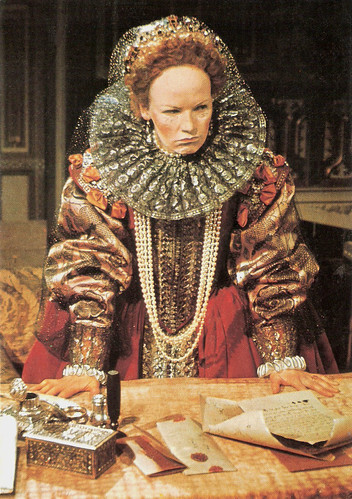
British postcard by British Broadcasting Corporation, no. 7, 1971. Photo: Glenda Jackson as Elizabeth I in the BBC TV series Elizabeth R (1971).
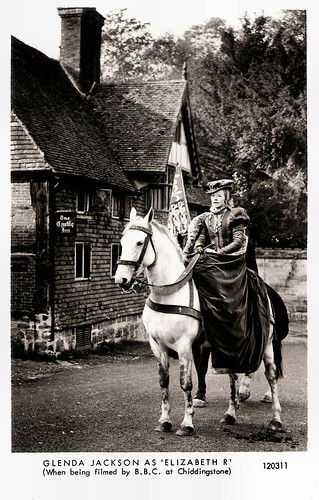
British postcard. Photo: John Topham Ltd, Sicup, Kent, no. 120311. Glenda Jackson as Elizabeth I in the BBC TV series Elizabeth R (1971).
Passionate about politics
During the 1980s, Glenda Jackson often worked for television. She portrayed actress Patricia Neal in The Patricia Neal Story (Anthony Harvey, Anthony Page, 1981) with Dirk Bogarde as Neal’s husband Roald Dahl, and Yelena Bonner in Sakharov (Jack Gold, 1984) starring Jason Robards as Bonner’s husband, the imprisoned Russian nuclear scientist and dissident Andrei Sakharov. For both parts, she was again nominated for an Emmy award, but both times she did not win.
She was one of the most fondly remembered later guest stars on The Muppet Show because she told the producers that she would perform any material they liked; this turned out to be a role where she has a delusion that she is a pirate captain who hijacks the Muppet Theatre as her ship.
She continued to make interesting films, including The Return of the Soldier (Alan Bridges, 1982) with Julie Christie , and Turtle Diary (John Irvin, 1985), but both were modest successes. In 1989, she appeared in Ken Russell's The Rainbow, playing Anna Brangwen, mother of Gudrun, the part which had won her her first Academy Award.
Jackson retired from acting in order to focus on public affairs. She had grown up in a household that was staunchly supportive of the Labour Party, and throughout her adult life, Jackson has been passionate about politics. After the 1992 general election, she became a Member of Parliament (MP) for Labour and remained an MP for many years. After the 1997 general election, she was appointed a junior minister in the government of Prime Minister Tony Blair, with responsibility for London Transport, a post she resigned before an attempt to be nominated as the Labour Party candidate for the election of the first Mayor of London in 2000. The nomination was eventually won by Frank Dobson, who lost the election to Ken Livingstone, the independent candidate.
After constituency changes for the 2010 general election, her majority of 42 votes was one of the closest results of the entire election. In June 2011, Jackson announced that presuming the Parliament elected in 2010 lasts until 2015, she would not seek re-election. She explained, "I will be almost 80 and by then it will be time for someone else to have a turn". In 2019, after a 27-year absence, Jackson returned to television drama, portraying an elderly grandmother struggling with dementia in Elizabeth Is Missing on BBC One, based on the novel of the same name by Emma Healey, for which she won the BAFTA TV Award for Best Actress and International Emmy Award for Best Actress. Jackson completed filming on The Great Escaper (Oliver Parker, 2023) shortly before her death. On 15 June 2023, Jackson died at her home in Blackheath at the age of 87. She was married to former stage actor and designer Roy Hodges from 1958 until their divorce in 1976. They had a son, Daniel Hodges (1969).
Trailer for The Music Lovers (1970). Source: Mondo Digital (YouTube).
Morecombe and Wise, with Glenda Jackson in the Antony & Cleopatra sketch (1971). Source: Slaphead6000 (YouTube).
Trailer for Mary, Queen of Scots (1971). Source: MaiU2b (YouTube).
Sources: Brian McFarlane (Encyclopedia of British Film), Sandra Brennan (AllMovie), Wikipedia, and .

British postcard for A British Film Year exhibition by Raithby, Lawrence & Company Ltd, Leicester and London. Photo: Terry O'Neill. Glenda Jackson on the set of Mary Queen of Scots (Charles Jarrott, 1971).

Romanian postcard by Casa Filmului Acin, no. 43078.
Blazing intelligence, sexual challenge and abrasiveness
Glenda May Jackson was born in Birkenhead on the Wirral, England, in 1936. Her father was a bricklayer. Jackson was educated at the West Kirby County Grammar School for Girls. She graduated from school at 16 and worked for two years in a Boots chemist shop. However, she found this boring and dead-end. She wanted better for herself.
Her life changed forever when she was accepted into the prestigious Royal Academy of Dramatic Art (RADA) at 18. Her work impressed all who observed it. Jackson made her professional stage debut in Terence Rattigan's 'Separate Tables' in 1957. She was a member of the Dundee Repertory Company in the early 1960s alongside Edward Fox, Michael Culver and Nicol Williamson. She made her film debut as a singer at a party in the British New Wave drama This Sporting Life ( Lindsay Anderson, 1963), starring Richard Harris. After ten years of scraping by, she was invited to join the Theatre of Cruelty, an offshoot of the Royal Shakespeare Company.
She was cast as Charlotte Corday in Peter Brook's internationally award-winning The Persecution and Assassination of Jean-Paul Marat as Performed by the Inmates of the Asylum of Charenton Under the Direction of the Marquis De Sade (aka Marat/Sade), written by Peter Weiss. For this part, she was nominated for a Tony Award as Best Supporting or Featured Actress (Dramatic). Jackson also appeared in the controversial film version, Marat/Sade (Peter Brook, 1967), featuring Patrick Magee. According to the anonymous biographer at IMDb , Jackson “is acknowledged to have stolen the show”. Her first starring film role came in the offbeat drama Negatives (Peter Medak, 1968).
It was followed by a starring role in the 1920s romance Women in Love (Ken Russell, 1969), based on a scandalous novel by D.H. Lawrence. For her role opposite Alan Bates, she won her first Academy Award for Best Actress. In the Encyclopedia of British Film, Brian McFarlane said, “Her blazing intelligence, sexual challenge and abrasiveness were at the service of a superbly written role in a film with a passion rare in the annals of British cinema.”
Another controversial role followed as Tchaikovsky's (Richard Chamberlain) nymphomaniac wife in The Music Lovers (Ken Russell, 1970). Both roles added to her image of being prepared to do almost anything for her art. She worked again with Russell on the musical comedy The Boy Friend (Ken Russell, 1971), although her part was only an uncredited cameo.

British postcard by British Broadcasting Corporation, no. 1, 1971. Photo: Glenda Jackson as Elizabeth I in the BBC TV series Elizabeth R (1971).

British postcard by British Broadcasting Corporation, no. 6, 1971. Photo: Glenda Jackson as Elizabeth I in the BBC TV series Elizabeth R (1971).
Controversial reputation
In the early 1970s, Glenda Jackson was much in demand. In Sunday Bloody Sunday (John Schlesinger, 1971), she played a divorced businesswoman in a dead-end affair with a shallow bisexual artist (Murray Head). The film turned out to be another major success. She won the BAFTA Award for Best Actress in a Leading Role and was again nominated for the Academy Award.
She confirmed her controversial reputation by having her head shaved in order to play Queen Elizabeth I of England in the BBC's blockbuster serial, Elizabeth R (1971). Jackson received two Emmy Awards for her work. She also portrayed Queen Elizabeth in the film Mary, Queen of Scots (Charles Jarrott, 1971) opposite Vanessa Redgrave . For this role, she won David di Donatello Award for Best Actress in Italy.
She appeared on the popular comedy series Morecambe and Wise Show (1971), playing Cleopatra in a very funny comedy sketch. This led to many other appearances on the show, including the Christmas Shows of 1971 and 1972. American Filmmaker Melvin Frank saw Glenda Jackson’s comedic potential and offered her the lead female part in A Touch of Class (Melvin Frank, 1973), co-starring George Segal. Her funny performance earned her a second Academy Award as Best Actress, plus a Golden Globe. Curiously she was not present to receive either of her Oscars.
By then, she was recognized as one of Britain's leading actresses. She was praised for her high intelligence and meticulous approach to her work. Jackson refused obvious commercial roles and sought out serious artistic work. In the following years, she played such roles as Solange in The Maids (Christopher Miles, 1974) with Susannah York, Hedda Gabler in Hedda (Trevor Dunn, 1975) and Sarah Bernhardt in The Incredible Sarah (Richard Fleischer, 1976). For these impressive portrayals she was again nominated for major awards, and she took several of them home.
In 1978, she was made a Commander of the Order of the British Empire (CBE). Sandra Brennan at AllMovie : “On stage, screen, and television, powerhouse actress Glenda Jackson displayed a fierce intelligence and a brazen toughness that have bordered on abrasiveness. With her sharp facial features, Jackson is more handsome than glamorous, but this has only helped her career in that it provided her the opportunity to play a wide variety of strong-willed, smart, and sexy women.”

British postcard by British Broadcasting Corporation, no. 7, 1971. Photo: Glenda Jackson as Elizabeth I in the BBC TV series Elizabeth R (1971).

British postcard. Photo: John Topham Ltd, Sicup, Kent, no. 120311. Glenda Jackson as Elizabeth I in the BBC TV series Elizabeth R (1971).
Passionate about politics
During the 1980s, Glenda Jackson often worked for television. She portrayed actress Patricia Neal in The Patricia Neal Story (Anthony Harvey, Anthony Page, 1981) with Dirk Bogarde as Neal’s husband Roald Dahl, and Yelena Bonner in Sakharov (Jack Gold, 1984) starring Jason Robards as Bonner’s husband, the imprisoned Russian nuclear scientist and dissident Andrei Sakharov. For both parts, she was again nominated for an Emmy award, but both times she did not win.
She was one of the most fondly remembered later guest stars on The Muppet Show because she told the producers that she would perform any material they liked; this turned out to be a role where she has a delusion that she is a pirate captain who hijacks the Muppet Theatre as her ship.
She continued to make interesting films, including The Return of the Soldier (Alan Bridges, 1982) with Julie Christie , and Turtle Diary (John Irvin, 1985), but both were modest successes. In 1989, she appeared in Ken Russell's The Rainbow, playing Anna Brangwen, mother of Gudrun, the part which had won her her first Academy Award.
Jackson retired from acting in order to focus on public affairs. She had grown up in a household that was staunchly supportive of the Labour Party, and throughout her adult life, Jackson has been passionate about politics. After the 1992 general election, she became a Member of Parliament (MP) for Labour and remained an MP for many years. After the 1997 general election, she was appointed a junior minister in the government of Prime Minister Tony Blair, with responsibility for London Transport, a post she resigned before an attempt to be nominated as the Labour Party candidate for the election of the first Mayor of London in 2000. The nomination was eventually won by Frank Dobson, who lost the election to Ken Livingstone, the independent candidate.
After constituency changes for the 2010 general election, her majority of 42 votes was one of the closest results of the entire election. In June 2011, Jackson announced that presuming the Parliament elected in 2010 lasts until 2015, she would not seek re-election. She explained, "I will be almost 80 and by then it will be time for someone else to have a turn". In 2019, after a 27-year absence, Jackson returned to television drama, portraying an elderly grandmother struggling with dementia in Elizabeth Is Missing on BBC One, based on the novel of the same name by Emma Healey, for which she won the BAFTA TV Award for Best Actress and International Emmy Award for Best Actress. Jackson completed filming on The Great Escaper (Oliver Parker, 2023) shortly before her death. On 15 June 2023, Jackson died at her home in Blackheath at the age of 87. She was married to former stage actor and designer Roy Hodges from 1958 until their divorce in 1976. They had a son, Daniel Hodges (1969).
Trailer for The Music Lovers (1970). Source: Mondo Digital (YouTube).
Morecombe and Wise, with Glenda Jackson in the Antony & Cleopatra sketch (1971). Source: Slaphead6000 (YouTube).
Trailer for Mary, Queen of Scots (1971). Source: MaiU2b (YouTube).
Sources: Brian McFarlane (Encyclopedia of British Film), Sandra Brennan (AllMovie), Wikipedia, and .
Published on June 15, 2023 22:00
June 14, 2023
Saracinesca (1921)
Italian actress, screenwriter, director and producer Elena Sangro (1896-1969) was one of the stars of the Italian period piece Saracinesca (Gaston Ravel, 1921), also starring Carlo Gualandri. The film was based on the novel by Frances Marion Crawford. Sangro produced Saracinesca for Medusa Film, and the film was distributed by UCI (Unione Cinematografica Italiana). Sangro was one of the first female directors and was also known for her famous affair with the writer and poet Gabriele D'Annunzio. Ivo Blom collected a wonderful series of postcards of this little-known Italian silent film.
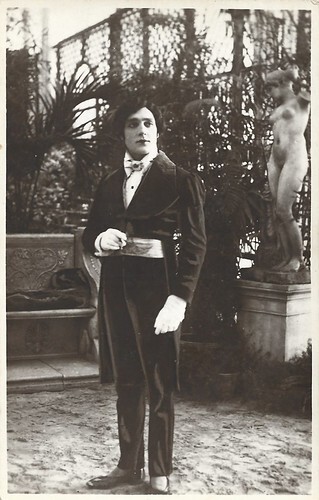
Italian postcard by Unione Cinemagrafica Italiana. Photo: Medusa Film. Carlo Gualandri as Don Giovanni Saracinesca in Saracinesca (Gaston Ravel, 1921). Caption: Don Giovanni Saracinesca.
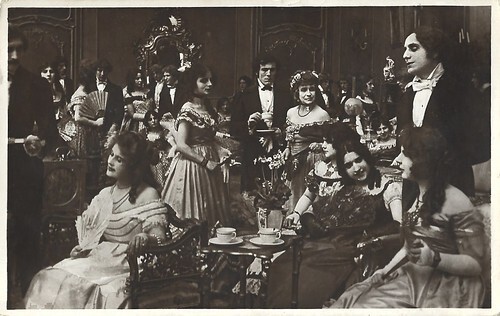
Italian postcard by Unione Cinemagrafica Italiana. Photo: Medusa Film. Carlo Gualandri as Don Giovanni Saracinesca in Saracinesca (Gaston Ravel, 1921). Caption: A reception. The man far left may be Don Giovanni Saracinesca.
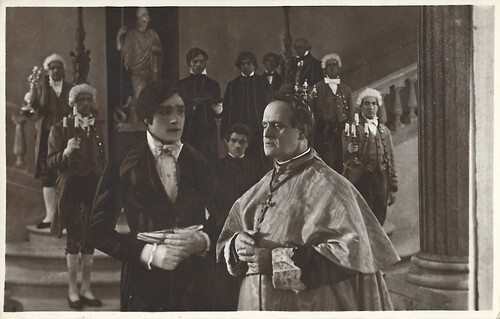
Italian postcard by Unione Cinemagrafica Italiana. Photo: Medusa Film. Carlo Gualandri as Don Giovanni Saracinesca in Saracinesca (Gaston Ravel, 1921). Caption: The day he hears that the young Prince Saracinesca wants to marry Donna Tullia Mayer, the cardinal doesn't hide his disapproval.
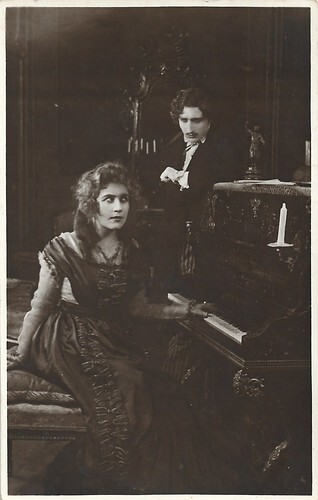
Italian postcard by Unione Cinemagrafica Italiana. Photo: Medusa Film. Alfredo Martinelli as Del Ferice and Sigrid Lind as Dona Tullia in Saracinesca (Gaston Ravel, 1921). Caption: The scheming and coquette Donna Tullia stands in a good relationship with the liberals and knows she is no party for the young Prince.
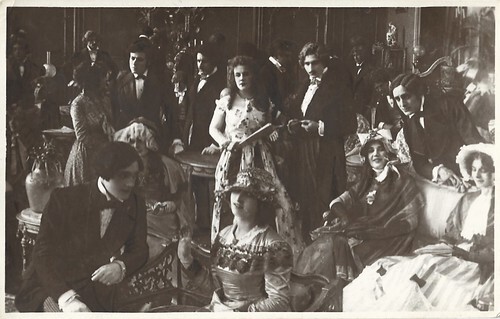
Italian postcard by Unione Cinemagrafica Italiana. Photo: Medusa Film. Carlo Gualandri as Don Giovanni Saracinesca and Elena Sangro as Corona d'Astradente in Saracinesca (Gaston Ravel, 1921). Caption: Don Giovanni Saracinesca meets Corona for the first time. (In the back, Donna Tullia and De Feriel look worried at them.)
An extremely popular novel
Little is known about Saracinesca (Gaston Ravel, 1921). It was based on an extremely popular novel (1887) by Frances Marion Crawford and is set in Rome in the 1860s, then still part of the Papal State. Ivo Blom subtracted the plot of the film from Crawford's novel as indicated on Project Gutenberg.
At a reception at the Embassy, Don Giovanni Saracinesca (Carlo Gualandri) meets Corona D'Astrardente (Elena Sangro), married to an old Duke, a dandy. Giovanni's father wants him to marry the young, rich widow Don Tullia Mayer, but he is hesitant himself, so he asks Corona for advice. Tullia is close with Ugo Del Ferice, who is close with the revolutionaries such as the painter Gouache, but mostly involved with his own interests, waving with the political tides.
Tullia tolerates him as her smooth-talking spy and lapdog. Del Ferice's only weak spot is his detestation of Saracinesca, eager to set a trap for him. At the opera, Giovanni confesses his love to Corona, while the Duke is too deaf to overhear them. At the Frangipani ball, cardinal Antonelli warns Giovanni against marriage with Tullia Mayer, because of her acquaintance with Del Ferice (an arrivé) and his liberal circle.
At the ball, Giovanni forgets his promised dance with Tullia when he talks to Corona. Terribly angered, Tullia makes a scene and leaves. Del Ferice overhears a conversation between Giovanni and Corona, in which she rejects his love. Giovanni calls him a dog. Giovanni's father helps him set up a duel with Del Ferice.
The duel is fierce, and there is also foul play by Del Ferice and his second. Both Giovanni and Del Ferice are wounded but don't die. After the ball, the Duke confesses to Corona he is ill beyond cure. Giovanni's father meets Tullia, who thinks the duel was about her, and Corona, who is offended to hear the duel was about her and is also appalled when she hears about the foul play of Del Ferice and his second, which could have caused Giovanni's death.
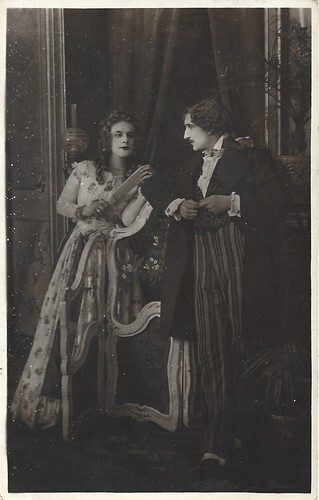
Italian postcard by Unione Cinemagrafica Italiana. Photo: Medusa Film. Alfredo Martinelli as Del Ferice in Saracinesca (Gaston Ravel, 1921). Caption: Plotting against Don Giovanni Saracinesca.
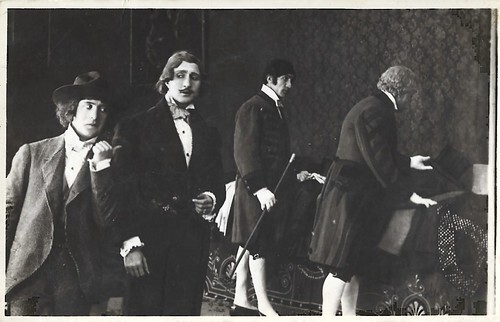
Italian postcard by Unione Cinemagrafica Italiana. Photo: Medusa Film. Alfredo Martinelli as Del Ferice in Saracinesca (Gaston Ravel, 1921). Caption: De Feriel at the opera.
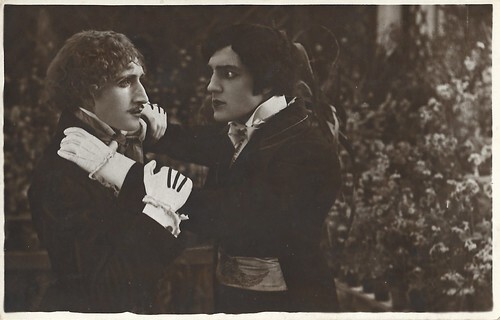
Italian postcard by Unione Cinemagrafica Italiana. Photo: Medusa Film. Carlo Gualandri as Don Giovanni Saracinesca and Alfredo Martinelli as Del Ferice in Saracinesca (Gaston Ravel, 1921). Caption: Don Giovanni Saracinesca threatens Del Ferice (named on the card: De Feriel).
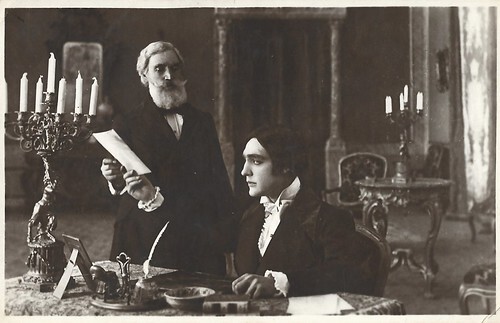
Italian postcard by Unione Cinemagrafica Italiana. Photo: Medusa Film. Carlo Gualandri as Don Giovanni Saracinesca in Saracinesca (Gaston Ravel, 1921). Caption: Before the duel, Saracinesca gives his last will to his notary.
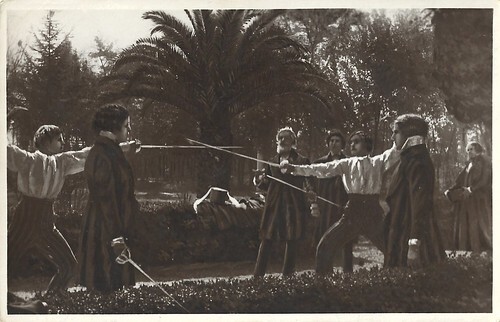
Italian postcard by Unione Cinemagrafica Italiana. Photo: Medusa Film. Carlo Gualandri as Don Giovanni Saracinesca, at left, in Saracinesca (Gaston Ravel, 1921). Caption: The duel.
Giovanni and Corona marry at last
Afterwards, the Duke hears that Giovanni's second killed Del Ferice's second over foul play, but he is also told the first duel was over his wife, and he explodes. He confronts his wife, she rebukes the affair, he forgives her, falls on his knees... and dies. Giovanni's father then doesn't oppose any marriage, as Corona is a rich widow now. Cardinal Antonelli visits her and convinces her to create a salon for the papal party. Corona intends to leave for the countryside, in vain Giovanni tries to prevent this.
Meanwhile, Del Ferice is cured and plots with Tullia to kill Corona and humiliate Giovanni by preventing their marriage. In exchange for not telling a secret, Tullia promises to marry Del Ferice. Del Ferice, namely, has found out Giovanni is already married. Corona has retreated to the Astradente residence in the countryside. Not far from there is also the Saracinesca estate. Giovanni's father visits the Duchess, sets up a meeting, and proposes Corona marry Giovanni, as they would be a perfect match, socially and materially. A reconciliation between the young couple happens and they declare each other their love. Yet, shortly before they marry, Tullia visits Corona and tells her about Giovanni's earlier marriage to a peasant woman called Felice Baldi. Yet, Corona calls Giovanni and his father, who press Tullia to show proof within 24 hours.
Tullia runs to Del Ferice, who immediately understands what she has done: tell what was secret. He gives her copies of the marriage certificate, knowing she will marry him now. Giovanni suspects De Ferice is behind Tullia's scheme. When Tullia presents the papers, Giovanni's unmasking of a (possible) fraud makes her doubt De Ferice's intentions and she storms out again. Giovanni's father goes to Aquila and finds out there was a namesake and even a distant relative also called Giovanni Saracinesca. Giovanni and Corona marry at last. Giovanni's father urges the Cardinal to arrest Del Ferice as a spy. They send the police after Del Ferice and his servant, but Del Ferice flees dressed as a beggar friar. On the road, Giovanni and Corona meet him, but on Corona's request his life is spared and Giovanni lets him go.
According to Wikipedia , "Crawford, though an American by parentage and citizenship, was born in the Italian resort of Bagni de Lucca, spent most of his life abroad, and wrote 'Saracinesca' while living in Sant' Agnello di Sorrento, Italy." After the success of his book, Crawford continued with several sequels: "She followed it with two brilliant sequels, 'Sant'Ilario' and 'Don Orsino', the three of which are usually considered a trilogy. Subsequent sequels, such as 'Corleone', continue the saga of the Saracinesca family, but with a diversion from the previous focus on the drama and status of family members into heavily plotted, incident-heavy melodrama. Characters from Saracinesca and its sequels also appear in 'A Lady of Rome' (1906) and 'The White Sister' (1909).
The film version, Saracinesca (Gaston Ravel, 1921), unfortunately, was less successful with Italian critics, according to two reviews in Vittorio Martinelli's reference work 'Il cinema muto italiano, Vol. 1921-22'. The film premiered in Rome on 31 January 1923. Next to Gaston Ravel, IMDb and Wikipedia mention a second director of the film. It's Augusto Camerini, the brother of the more famous director Mario Camerini and the cousin of another famous director, Augusto Genina. Augusto Camerini was a well-known painter, illustrator and cartoonist and also worked as a writer and assistant film director. In the years 1920-1921, he directed six films. Later he directed three more films.
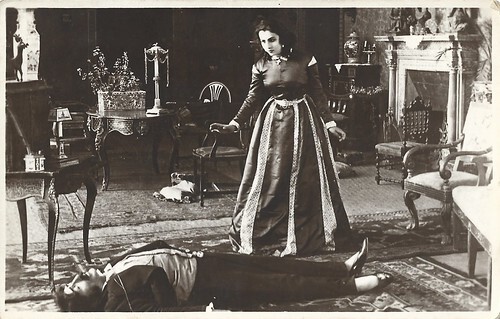
Italian postcard by Unione Cinemagrafica Italiana. Photo: Medusa Film. Elena Sangro as Corona d'Astradente in Saracinesca (Gaston Ravel, 1921). Caption: After the killing of her husband, Corona d'Astradente has become a rich heiress.
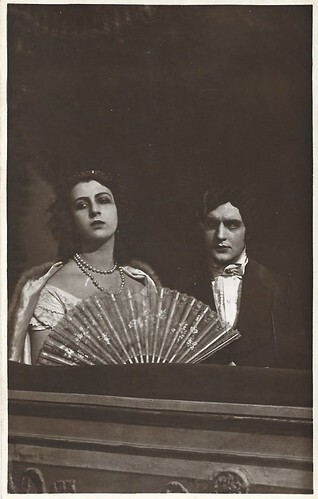
Italian postcard by Unione Cinemagrafica Italiana. Photo: Medusa Film. Elena Sangro as Corona d'Astradente and Carlo Gualandri as Don Giovanni Saracinesca in Saracinesca (Gaston Ravel, 1921). Caption: [At the opera] Corona and Giovanni are now husband and wife.
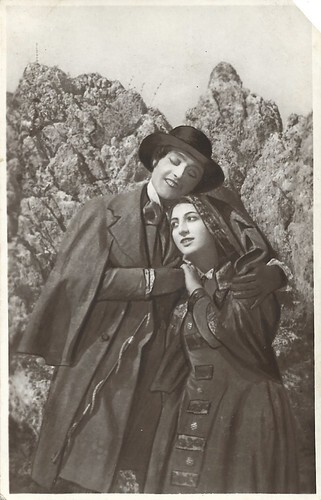
Italian postcard by Unione Cinemagrafica Italiana. Photo: Medusa Film. Elena Sangro as Corona d'Astradente and Carlo Gualandri as Don Giovanni Saracinesca in Saracinesca (Gaston Ravel, 1921). Caption: Don Giovanni Saracinesca holds his new wife Corona tight, whispering: You are the best among the women - and the most beloved!
Sources: Guttenberg, Vittorio Martinelli (La carrière italienne de Gaston Ravel (1919-1922) - French), Wikipedia (Italian) and IMDb.

Italian postcard by Unione Cinemagrafica Italiana. Photo: Medusa Film. Carlo Gualandri as Don Giovanni Saracinesca in Saracinesca (Gaston Ravel, 1921). Caption: Don Giovanni Saracinesca.

Italian postcard by Unione Cinemagrafica Italiana. Photo: Medusa Film. Carlo Gualandri as Don Giovanni Saracinesca in Saracinesca (Gaston Ravel, 1921). Caption: A reception. The man far left may be Don Giovanni Saracinesca.

Italian postcard by Unione Cinemagrafica Italiana. Photo: Medusa Film. Carlo Gualandri as Don Giovanni Saracinesca in Saracinesca (Gaston Ravel, 1921). Caption: The day he hears that the young Prince Saracinesca wants to marry Donna Tullia Mayer, the cardinal doesn't hide his disapproval.

Italian postcard by Unione Cinemagrafica Italiana. Photo: Medusa Film. Alfredo Martinelli as Del Ferice and Sigrid Lind as Dona Tullia in Saracinesca (Gaston Ravel, 1921). Caption: The scheming and coquette Donna Tullia stands in a good relationship with the liberals and knows she is no party for the young Prince.

Italian postcard by Unione Cinemagrafica Italiana. Photo: Medusa Film. Carlo Gualandri as Don Giovanni Saracinesca and Elena Sangro as Corona d'Astradente in Saracinesca (Gaston Ravel, 1921). Caption: Don Giovanni Saracinesca meets Corona for the first time. (In the back, Donna Tullia and De Feriel look worried at them.)
An extremely popular novel
Little is known about Saracinesca (Gaston Ravel, 1921). It was based on an extremely popular novel (1887) by Frances Marion Crawford and is set in Rome in the 1860s, then still part of the Papal State. Ivo Blom subtracted the plot of the film from Crawford's novel as indicated on Project Gutenberg.
At a reception at the Embassy, Don Giovanni Saracinesca (Carlo Gualandri) meets Corona D'Astrardente (Elena Sangro), married to an old Duke, a dandy. Giovanni's father wants him to marry the young, rich widow Don Tullia Mayer, but he is hesitant himself, so he asks Corona for advice. Tullia is close with Ugo Del Ferice, who is close with the revolutionaries such as the painter Gouache, but mostly involved with his own interests, waving with the political tides.
Tullia tolerates him as her smooth-talking spy and lapdog. Del Ferice's only weak spot is his detestation of Saracinesca, eager to set a trap for him. At the opera, Giovanni confesses his love to Corona, while the Duke is too deaf to overhear them. At the Frangipani ball, cardinal Antonelli warns Giovanni against marriage with Tullia Mayer, because of her acquaintance with Del Ferice (an arrivé) and his liberal circle.
At the ball, Giovanni forgets his promised dance with Tullia when he talks to Corona. Terribly angered, Tullia makes a scene and leaves. Del Ferice overhears a conversation between Giovanni and Corona, in which she rejects his love. Giovanni calls him a dog. Giovanni's father helps him set up a duel with Del Ferice.
The duel is fierce, and there is also foul play by Del Ferice and his second. Both Giovanni and Del Ferice are wounded but don't die. After the ball, the Duke confesses to Corona he is ill beyond cure. Giovanni's father meets Tullia, who thinks the duel was about her, and Corona, who is offended to hear the duel was about her and is also appalled when she hears about the foul play of Del Ferice and his second, which could have caused Giovanni's death.

Italian postcard by Unione Cinemagrafica Italiana. Photo: Medusa Film. Alfredo Martinelli as Del Ferice in Saracinesca (Gaston Ravel, 1921). Caption: Plotting against Don Giovanni Saracinesca.

Italian postcard by Unione Cinemagrafica Italiana. Photo: Medusa Film. Alfredo Martinelli as Del Ferice in Saracinesca (Gaston Ravel, 1921). Caption: De Feriel at the opera.

Italian postcard by Unione Cinemagrafica Italiana. Photo: Medusa Film. Carlo Gualandri as Don Giovanni Saracinesca and Alfredo Martinelli as Del Ferice in Saracinesca (Gaston Ravel, 1921). Caption: Don Giovanni Saracinesca threatens Del Ferice (named on the card: De Feriel).

Italian postcard by Unione Cinemagrafica Italiana. Photo: Medusa Film. Carlo Gualandri as Don Giovanni Saracinesca in Saracinesca (Gaston Ravel, 1921). Caption: Before the duel, Saracinesca gives his last will to his notary.

Italian postcard by Unione Cinemagrafica Italiana. Photo: Medusa Film. Carlo Gualandri as Don Giovanni Saracinesca, at left, in Saracinesca (Gaston Ravel, 1921). Caption: The duel.
Giovanni and Corona marry at last
Afterwards, the Duke hears that Giovanni's second killed Del Ferice's second over foul play, but he is also told the first duel was over his wife, and he explodes. He confronts his wife, she rebukes the affair, he forgives her, falls on his knees... and dies. Giovanni's father then doesn't oppose any marriage, as Corona is a rich widow now. Cardinal Antonelli visits her and convinces her to create a salon for the papal party. Corona intends to leave for the countryside, in vain Giovanni tries to prevent this.
Meanwhile, Del Ferice is cured and plots with Tullia to kill Corona and humiliate Giovanni by preventing their marriage. In exchange for not telling a secret, Tullia promises to marry Del Ferice. Del Ferice, namely, has found out Giovanni is already married. Corona has retreated to the Astradente residence in the countryside. Not far from there is also the Saracinesca estate. Giovanni's father visits the Duchess, sets up a meeting, and proposes Corona marry Giovanni, as they would be a perfect match, socially and materially. A reconciliation between the young couple happens and they declare each other their love. Yet, shortly before they marry, Tullia visits Corona and tells her about Giovanni's earlier marriage to a peasant woman called Felice Baldi. Yet, Corona calls Giovanni and his father, who press Tullia to show proof within 24 hours.
Tullia runs to Del Ferice, who immediately understands what she has done: tell what was secret. He gives her copies of the marriage certificate, knowing she will marry him now. Giovanni suspects De Ferice is behind Tullia's scheme. When Tullia presents the papers, Giovanni's unmasking of a (possible) fraud makes her doubt De Ferice's intentions and she storms out again. Giovanni's father goes to Aquila and finds out there was a namesake and even a distant relative also called Giovanni Saracinesca. Giovanni and Corona marry at last. Giovanni's father urges the Cardinal to arrest Del Ferice as a spy. They send the police after Del Ferice and his servant, but Del Ferice flees dressed as a beggar friar. On the road, Giovanni and Corona meet him, but on Corona's request his life is spared and Giovanni lets him go.
According to Wikipedia , "Crawford, though an American by parentage and citizenship, was born in the Italian resort of Bagni de Lucca, spent most of his life abroad, and wrote 'Saracinesca' while living in Sant' Agnello di Sorrento, Italy." After the success of his book, Crawford continued with several sequels: "She followed it with two brilliant sequels, 'Sant'Ilario' and 'Don Orsino', the three of which are usually considered a trilogy. Subsequent sequels, such as 'Corleone', continue the saga of the Saracinesca family, but with a diversion from the previous focus on the drama and status of family members into heavily plotted, incident-heavy melodrama. Characters from Saracinesca and its sequels also appear in 'A Lady of Rome' (1906) and 'The White Sister' (1909).
The film version, Saracinesca (Gaston Ravel, 1921), unfortunately, was less successful with Italian critics, according to two reviews in Vittorio Martinelli's reference work 'Il cinema muto italiano, Vol. 1921-22'. The film premiered in Rome on 31 January 1923. Next to Gaston Ravel, IMDb and Wikipedia mention a second director of the film. It's Augusto Camerini, the brother of the more famous director Mario Camerini and the cousin of another famous director, Augusto Genina. Augusto Camerini was a well-known painter, illustrator and cartoonist and also worked as a writer and assistant film director. In the years 1920-1921, he directed six films. Later he directed three more films.

Italian postcard by Unione Cinemagrafica Italiana. Photo: Medusa Film. Elena Sangro as Corona d'Astradente in Saracinesca (Gaston Ravel, 1921). Caption: After the killing of her husband, Corona d'Astradente has become a rich heiress.

Italian postcard by Unione Cinemagrafica Italiana. Photo: Medusa Film. Elena Sangro as Corona d'Astradente and Carlo Gualandri as Don Giovanni Saracinesca in Saracinesca (Gaston Ravel, 1921). Caption: [At the opera] Corona and Giovanni are now husband and wife.

Italian postcard by Unione Cinemagrafica Italiana. Photo: Medusa Film. Elena Sangro as Corona d'Astradente and Carlo Gualandri as Don Giovanni Saracinesca in Saracinesca (Gaston Ravel, 1921). Caption: Don Giovanni Saracinesca holds his new wife Corona tight, whispering: You are the best among the women - and the most beloved!
Sources: Guttenberg, Vittorio Martinelli (La carrière italienne de Gaston Ravel (1919-1922) - French), Wikipedia (Italian) and IMDb.
Published on June 14, 2023 22:00
June 13, 2023
Leontine Kühnberg
Leontine Kühnberg (1889-1945?) was a German theatre and silent film actress. For a time she belonged to the ensemble of Max Reinhardt's Deutsches Theater. Shortly before the outbreak of the First World War, she began to make films. In 1921 she married and withdrew from the film sets. She was Jewish and probably died at the end of WW II.
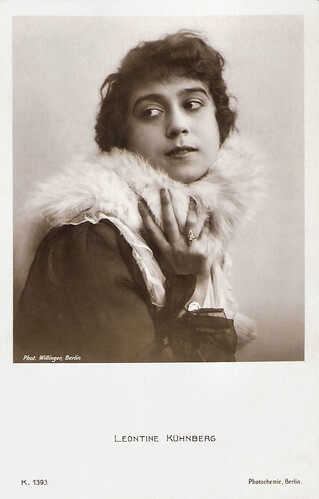
German postcard by Photochemie, Berlin, no. K. 1393. Photo: Willinger, Berlin.

German postcard by Photochemie, Berlin, no. K. 2637. Photo: Eichberg-Film. The film title Uns aber ist gegeben auf keiner Stätte zu ruhen/But to us it is given to rest on no place is absent on IMDb and Filmportal . From the six films that Richard Eichberg directed with Leontine Kühnberg in 1918, all for his own company Eichberg-Film, a probable option is Im Zeichen der Schuld/Under the sign of guilt (Richard Eichberg, 1918), aka Aus dem Leben eines Vorbestraften/From the life of a convicted man. Filmportal.de lists this as the only film in which Bruno Decarli and Kühnberg played together in a film by Eichberg-Film. The plot deals with a man (Decarli) who, convicted of forging his boss's name, kills the bank director and assumes his identity. However, the Early German Film Database does list the film Uns aber ist gegeben, auf keiner Stätte zu ruhen as a separate film (1918), directed by Eichberg, and starring Decarli and Kühnberg. So perhaps, this is a separate film after all.
An impossible menage à trois
Leontine Kühnberg was born Leontine Chimberg in 1889 in Berlin. She was the daughter of the Jewish merchant Emil Chimberg and his wife Heni, née Lastu. Leontine can be traced as a theatre actress from 1908. For a time she belonged to the ensemble of Max Reinhardt's Deutsches Theater.
Shortly before the outbreak of the First World War, she began to make films, first under the direction of Harry Piel in Der schwarze Pierrot/The Black Pierrot (1913) with Ludwig Trautmann . In 1914 she started at PAGU / Union, led by Paul Davidson. Her participation in two Hermann Sudermann adaptations, Die Geschichte der stillen Mühle/The story of the silent mill (Richard Oswald, 1914) and Der Katzensteg/The catwalk (Max Mack, 1915), brought her recognition.
The former film dealt with an impossible menage à trois, also with Alfred Abel and Robert Valberg, while the latter was set in Napoleonic times and dealt first with a father-son conflict in which a maiden was forced to help the father and the French enemy, and later on the son, despite being a Prussian free fighter, defending the woman at all costs. Ferdinand Bonn , who later on often acted with her, already had supporting parts in these two films.
Kühnberg continued at PAGU in films such as Pension Lampel (Max Mack, 1915) and So rächt sich die Sonne/This is how the sun takes revenge (William Wauer, 1915) based on a script by Richard Oswald. Apart from PAGU she also acted in the mid-1910s in Otto Rippert's Der grüne Mann von Amsterdam/The green man from Amsterdam (1916) with Erich Kaiser-Titz , Harry Piel 's Das lebende Rätsel/The living enigma (1915) with Ludwig Trautmann .
She also acted in Richard Oswald's films Seine letzte Maske/His last mask (1916), Zirkusblut/Circus blood (1916), Des Goldes Fluch/The Curse of Gold (1917), and in particular, in the lost film Es werde Licht/Let There Be Light, I (1917), protesting the anti-abortion-law and warning against syphilis. In all these films she co-starred with Bernd Aldor . According to IMDb , Kühnberg also acted in two Hungarian films: Az ezüst kecske/The Medic (Michael Curtiz, 1916) with Victor Varconi, and A Világ csak hangulat/The World is just a mood (Eugen Illés, 1917). With Eugen Illés she also would do various German films too.
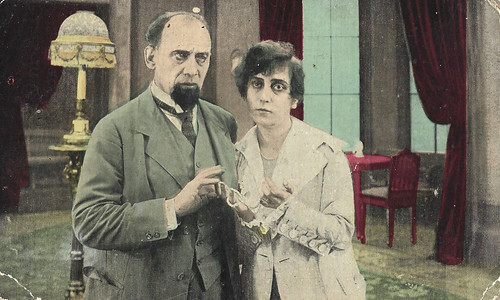
Spanish collector's card (cromo) by Chocolat Imperial, no. 1 of 6. Photo: Distr. J. Verdaguer, Barcelona / Eichberg-Film. Leontine Kühnberg and Ferdinand Bonn in Die goldene Mumie/The Golden Mummy (Richard Eichberg, 1918).
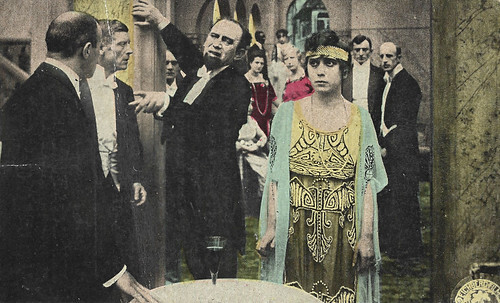
Spanish collector's card (cromo) by Chocolat Imperial, no. 3 of 6. Photo: Distr. J. Verdaguer, Barcelona / Eichberg-Film. Leontine Kühnberg and Ferdinand Bonn in Die goldene Mumie (Richard Eichberg, 1918).
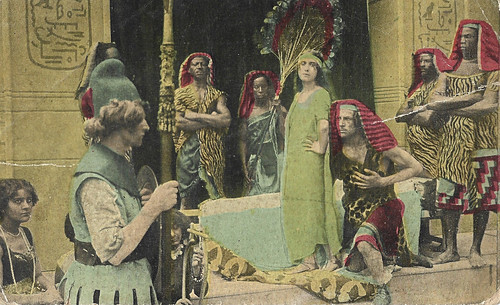
Spanish collector's card (cromo) by Chocolat Imperial, no. 4 of 6. Photo: Distr. J. Verdaguer, Barcelona / Eichberg-Film. Leontine Kühnberg and Ferdinand Bonn in Die goldene Mumie (Richard Eichberg, 1918).
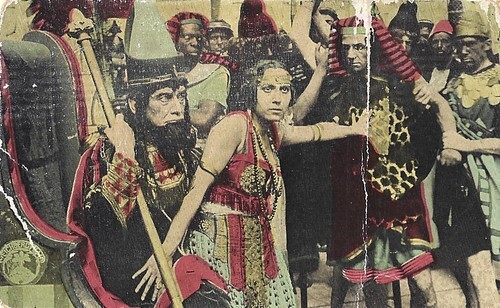
Spanish collector's card (cromo) by Chocolat Imperial, no. 5 of 6. Photo: Distr. J. Verdaguer, Barcelona / Eichberg-Film. Leontine Kühnberg and Ferdinand Bonn in Die goldene Mumie (Richard Eichberg, 1918).
A Daughter of Her People
In 1918, after a few films at Duskes and Neutral-Film, Leontine Kühnberg stepped over to Eichberg-Film, where she did seven films from 1918-1919 under the direction of Richard Eichberg. These included Die goldene Mumie/The Golden Mummy (1918), also with Ferdinand Bonn , Die letzte Liebesnacht der Inge Tolmein/Inge Tolmein's Last Night of Love (1918), with Karl Falkenberg, and Die Tragödie der Manja Orsan/The Tragedy of Manja Orsan (1919), in which she had the title role opposite Charles Willy Kaiser .
She then moved to Neutral-Film for a few films under the direction of Eugen Illés, e.g. Die silberne Fessel/The silver shackle (1919-20) and Moral (1920), often acting opposite Ernst Rückert .
Her last films were for the company Neos-Film, among which Judith Trachtenberg (Henrik Galeen, 1920), about a young Jewish woman who cannot choose between her Jewish family and roots and her non-Jewish lover, a count (Paul Otto). Moreover, she is pregnant with her husband-to-be. In the end, she commits suicide. In 1932 an American remake was released as A Daughter of Her People. According to IMDb , the film was re-edited and re-released with a new framing story as A Daughter of Her People (Henrik Galeen, George Roland, 1932)
At the beginning of 1921, Leontine Kühberg got married to the businessman and film producer Ludwig Schwarz in Vienna, for whose Neos-Film GmbH she had appeared in leading roles three times before. She withdrew from the film sets. In the following years, the couple lived in the Berlin districts of Wilmersdorf and Charlottenburg, where Ludwig Schwarz ran a large hosiery factory. In 1930, Leontine Kühnberg was the owner of the short-lived publishing house Buchkultur, which she ran together with her husband.
No definite information is currently available about her later fate. In 1970, Leontine Kühnberg was declared dead at the Schöneberg District Court, with 31 December 1945 as the official date of death. Her last place of residence was presumably Warsaw so it must be assumed that the actress, who was considered a "full Jewess" according to Nazi racial doctrine, died violently - possibly in connection with the Warsaw Ghetto. Her husband had already been declared dead in 1962. IMDb writes she already died in 1924 but this is a mistake. The writer Ernst Birnbaum was a cousin of Leontine Kühnberg.

German postcard by Verlag Hermann Leiser, Berlin-Wilm., no. 3165. Photo: Becker & Maass, Berlin.
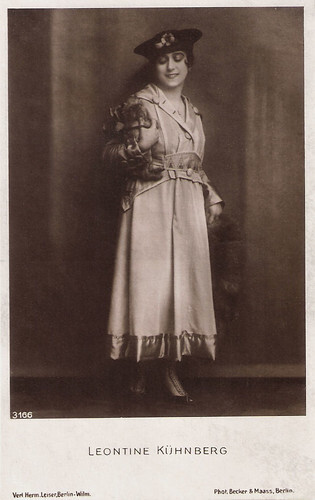
German postcard by Verlag Hermann Leiser, Berlin-Wilm., no. 3166. Photo: Becker & Maass, Berlin.
Sources: Filmportal, Wikipedia (German) and .

German postcard by Photochemie, Berlin, no. K. 1393. Photo: Willinger, Berlin.

German postcard by Photochemie, Berlin, no. K. 2637. Photo: Eichberg-Film. The film title Uns aber ist gegeben auf keiner Stätte zu ruhen/But to us it is given to rest on no place is absent on IMDb and Filmportal . From the six films that Richard Eichberg directed with Leontine Kühnberg in 1918, all for his own company Eichberg-Film, a probable option is Im Zeichen der Schuld/Under the sign of guilt (Richard Eichberg, 1918), aka Aus dem Leben eines Vorbestraften/From the life of a convicted man. Filmportal.de lists this as the only film in which Bruno Decarli and Kühnberg played together in a film by Eichberg-Film. The plot deals with a man (Decarli) who, convicted of forging his boss's name, kills the bank director and assumes his identity. However, the Early German Film Database does list the film Uns aber ist gegeben, auf keiner Stätte zu ruhen as a separate film (1918), directed by Eichberg, and starring Decarli and Kühnberg. So perhaps, this is a separate film after all.
An impossible menage à trois
Leontine Kühnberg was born Leontine Chimberg in 1889 in Berlin. She was the daughter of the Jewish merchant Emil Chimberg and his wife Heni, née Lastu. Leontine can be traced as a theatre actress from 1908. For a time she belonged to the ensemble of Max Reinhardt's Deutsches Theater.
Shortly before the outbreak of the First World War, she began to make films, first under the direction of Harry Piel in Der schwarze Pierrot/The Black Pierrot (1913) with Ludwig Trautmann . In 1914 she started at PAGU / Union, led by Paul Davidson. Her participation in two Hermann Sudermann adaptations, Die Geschichte der stillen Mühle/The story of the silent mill (Richard Oswald, 1914) and Der Katzensteg/The catwalk (Max Mack, 1915), brought her recognition.
The former film dealt with an impossible menage à trois, also with Alfred Abel and Robert Valberg, while the latter was set in Napoleonic times and dealt first with a father-son conflict in which a maiden was forced to help the father and the French enemy, and later on the son, despite being a Prussian free fighter, defending the woman at all costs. Ferdinand Bonn , who later on often acted with her, already had supporting parts in these two films.
Kühnberg continued at PAGU in films such as Pension Lampel (Max Mack, 1915) and So rächt sich die Sonne/This is how the sun takes revenge (William Wauer, 1915) based on a script by Richard Oswald. Apart from PAGU she also acted in the mid-1910s in Otto Rippert's Der grüne Mann von Amsterdam/The green man from Amsterdam (1916) with Erich Kaiser-Titz , Harry Piel 's Das lebende Rätsel/The living enigma (1915) with Ludwig Trautmann .
She also acted in Richard Oswald's films Seine letzte Maske/His last mask (1916), Zirkusblut/Circus blood (1916), Des Goldes Fluch/The Curse of Gold (1917), and in particular, in the lost film Es werde Licht/Let There Be Light, I (1917), protesting the anti-abortion-law and warning against syphilis. In all these films she co-starred with Bernd Aldor . According to IMDb , Kühnberg also acted in two Hungarian films: Az ezüst kecske/The Medic (Michael Curtiz, 1916) with Victor Varconi, and A Világ csak hangulat/The World is just a mood (Eugen Illés, 1917). With Eugen Illés she also would do various German films too.

Spanish collector's card (cromo) by Chocolat Imperial, no. 1 of 6. Photo: Distr. J. Verdaguer, Barcelona / Eichberg-Film. Leontine Kühnberg and Ferdinand Bonn in Die goldene Mumie/The Golden Mummy (Richard Eichberg, 1918).

Spanish collector's card (cromo) by Chocolat Imperial, no. 3 of 6. Photo: Distr. J. Verdaguer, Barcelona / Eichberg-Film. Leontine Kühnberg and Ferdinand Bonn in Die goldene Mumie (Richard Eichberg, 1918).

Spanish collector's card (cromo) by Chocolat Imperial, no. 4 of 6. Photo: Distr. J. Verdaguer, Barcelona / Eichberg-Film. Leontine Kühnberg and Ferdinand Bonn in Die goldene Mumie (Richard Eichberg, 1918).

Spanish collector's card (cromo) by Chocolat Imperial, no. 5 of 6. Photo: Distr. J. Verdaguer, Barcelona / Eichberg-Film. Leontine Kühnberg and Ferdinand Bonn in Die goldene Mumie (Richard Eichberg, 1918).
A Daughter of Her People
In 1918, after a few films at Duskes and Neutral-Film, Leontine Kühnberg stepped over to Eichberg-Film, where she did seven films from 1918-1919 under the direction of Richard Eichberg. These included Die goldene Mumie/The Golden Mummy (1918), also with Ferdinand Bonn , Die letzte Liebesnacht der Inge Tolmein/Inge Tolmein's Last Night of Love (1918), with Karl Falkenberg, and Die Tragödie der Manja Orsan/The Tragedy of Manja Orsan (1919), in which she had the title role opposite Charles Willy Kaiser .
She then moved to Neutral-Film for a few films under the direction of Eugen Illés, e.g. Die silberne Fessel/The silver shackle (1919-20) and Moral (1920), often acting opposite Ernst Rückert .
Her last films were for the company Neos-Film, among which Judith Trachtenberg (Henrik Galeen, 1920), about a young Jewish woman who cannot choose between her Jewish family and roots and her non-Jewish lover, a count (Paul Otto). Moreover, she is pregnant with her husband-to-be. In the end, she commits suicide. In 1932 an American remake was released as A Daughter of Her People. According to IMDb , the film was re-edited and re-released with a new framing story as A Daughter of Her People (Henrik Galeen, George Roland, 1932)
At the beginning of 1921, Leontine Kühberg got married to the businessman and film producer Ludwig Schwarz in Vienna, for whose Neos-Film GmbH she had appeared in leading roles three times before. She withdrew from the film sets. In the following years, the couple lived in the Berlin districts of Wilmersdorf and Charlottenburg, where Ludwig Schwarz ran a large hosiery factory. In 1930, Leontine Kühnberg was the owner of the short-lived publishing house Buchkultur, which she ran together with her husband.
No definite information is currently available about her later fate. In 1970, Leontine Kühnberg was declared dead at the Schöneberg District Court, with 31 December 1945 as the official date of death. Her last place of residence was presumably Warsaw so it must be assumed that the actress, who was considered a "full Jewess" according to Nazi racial doctrine, died violently - possibly in connection with the Warsaw Ghetto. Her husband had already been declared dead in 1962. IMDb writes she already died in 1924 but this is a mistake. The writer Ernst Birnbaum was a cousin of Leontine Kühnberg.

German postcard by Verlag Hermann Leiser, Berlin-Wilm., no. 3165. Photo: Becker & Maass, Berlin.

German postcard by Verlag Hermann Leiser, Berlin-Wilm., no. 3166. Photo: Becker & Maass, Berlin.
Sources: Filmportal, Wikipedia (German) and .
Published on June 13, 2023 22:00
Paul van Yperen's Blog
- Paul van Yperen's profile
- 13 followers
Paul van Yperen isn't a Goodreads Author
(yet),
but they
do have a blog,
so here are some recent posts imported from
their feed.



